Amber Awareness Ribbons: Colors and causes symbolize, stand for and support:
Animal Paw Prints Awareness Ribbons: Colors and causes symbolize, stand for and support:


- Animal Abuse Prevention: Preventing animal cruelty and abuse is in all our best interests. Studies show that cruelty to animals is a sign that other abuse may be taking place in the home. Those same studies show that children who witness animal abuse are at a greater risk of becoming animal abusers themselves. The alternate color for Animal Abuse Prevention is purple.
- Animal Blood Donors / Veterinary Transfusion Medicine: Just like humans, animals may require blood transfusions. Trauma, autoimmune diseases, bone marrow surgery, cancer, and abdominal surgery are just a few reasons blood is needed to save the life of a beloved pet.
- Animal Fostering Parent / Family: Animal fostering creates more space in shelters for other animals in need. Whether a shelter is crowded or not, each animal in a shelter requires time and resources that could be stretched further if those animals were in foster homes. Foster caregivers help animal shelters and rescues extend their resources.
- Animal Loss Due to Animal Abuse or Neglect: Animal death due to animal abuse includes hoarding, lack of shelter or veterinary care, tethering and abandonment, as well as other forms of abuse. The alternate colors for Animal Loss Due to Animal Abuse are purple or black.
- Animal Protection and Welfare: Animals deserve to live their lives free from suffering and exploitation. The alternate color for Animal Protection and Welfare is purple.
- Animal Rescue Mom / Dad / Family: Overburdened shelters take in millions of strays, abused and lost animals every year. By adopting an animal, you're making room for others. You are giving more animals a second chance and the cost of your adoption goes directly toward helping shelters better care for the animals they take in.
- Cancer in Animals: Cats and dogs can get cancer. A veterinary oncologist is a veterinarian that specializes in the diagnosis and treatment of cancer in pets. A veterinary oncologist has undergone an additional 3–4 years of residency training in cancer medicine after attaining their Doctor of Veterinary Medicine degree.
- Diabetes in Animals: In dogs, the prevalence of diabetes is about 1 in 500. The common age of diagnosis is 7-9 years. Female dogs are three times more likely than males to get diabetes. Dogs are more likely to have insulin-dependent diabetes, like Type I diabetes in humans. In cats, the prevalence of diabetes is about 1 in 200 cats.
- Feline Leukemia Virus / FeLV (Cats): Feline Leukemia virus (FeLV) is one of the most common infectious diseases in cats, affecting between 2% and 3% of all cats in the United States.
- Heartworm in Animals: Heartworm disease results in severe lung disease, heart failure, other organ damage, and death in pets. This mainly occurs in dogs, cats, and ferrets. Heartworm is caused by a parasitic worm. The worms are spread through the bite of a mosquito.
- High Rise Syndrome (Cats): High-Rise syndrome refers to the injuries that cats may sustain if they fall from a steep height. Cases of High-Rise syndrome tend to spike during warm weather months when windows are open and outdoor spaces, like terraces, are in use more often.
- Humane Treatment of Animals: Animals deserve to be treated humanely. It is our responsibility as humans to treat them with compassion and benevolence. The alternate colors for Humane Treatment of Animals are orange or purple.
- Kennel Cough (Dogs): Kennel cough is a highly contagious, common airway infection that can be caused by several viruses and bacteria. Its most distinctive symptom is a loud, hacking cough.
- Loss of a Loved Pet / In Memory of a Loved Pet: When we lose a beloved pet, the loss can bring grief and intense sorrow. Honoring and remembering a pet with an animal paw prints ribbon pin is a way to keep your pet close to your heart.
- Parvovirus (Dogs): Parvo in puppies is caused by the canine parvovirus. This virus is highly contagious and spreads through direct contact with an infected dog or indirect contact with a contaminated object.
- Rabies in Animals: Rabies is a viral disease that can infect all warm-blooded animals, including cats and people, although some species are somewhat naturally resistant to the disease.
- Ringworm (Cats): Ringworm in cats is a highly contagious fungal infection of the skin. It is more common in kittens and long-haired cats but can affect any breed and age.
- Spay and Neuter Pets: Spaying is the common term used to describe the surgical procedure known as an ovariohysterectomy. In this procedure, the female's ovaries and uterus are removed completely. Neutering and castration are the common terms used to describe the surgical procedure during which both testicles are removed to sterilize a male cat or dog. The alternate color for Spay and Neuter Pets is light blue.
- Upper Respiratory Infection in Animals: Feline upper respiratory infection is the common term for a respiratory infection. Synonyms for this condition include feline infectious respiratory disease and feline upper respiratory disease complex.
- Worms Prevention: Healthy-looking pets can still carry worms, so it's important to worm them regularly.
Black Awareness Ribbons: Colors and causes symbolize, stand for and support:
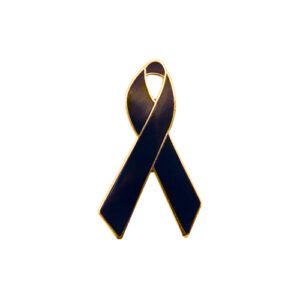

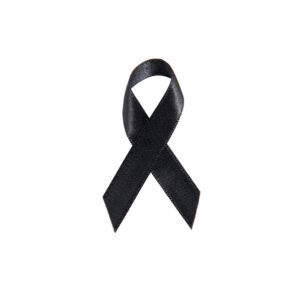



- Accidents and Unintentional Injuries: Injuries have traditionally been known as accidents or random and unavoidable events. Injuries are instead described as preventable events with major consequences on public health and represent a significant global issue.
- Funerals and Mourning: Traditionally, black has been the color that communicates bereavement. For this reason, it is often used in funeral services. Many cultures have their own traditional color other than black. In some cultures, the ribbon is torn to represent the tear in your heart when losing a loved one.
- Funerals/Mourning: The color of mourning has varied, though most cultures recognize black as being the preferred standard for funeral attire.
- Gang Prevention: Gang prevention programs target youth at risk of gang involvement and help reduce the number of youth who join gangs.
- Hypersomnia: Hypersomnia is characterized by excessive daytime sleepiness and oversleeping. People with hypersomnia often struggle to stay awake during the day, which can significantly impact daily life and overall well-being. Causes can vary, but may include underlying medical conditions, medication side effects, or a sleep disorder.
- Insomnia: Insomnia is defined as difficulty initiating or maintaining sleep, or both, despite adequate opportunity and time to sleep. This can lead to impaired daytime functioning. Insomnia may be a cause of or result of poor quality and/or quantity of sleep. In general, women are affected more frequently than men.
- Malignant Melanoma (Skin Cancer): Melanoma is a cancer that develops in melanocytes, the pigment cells present in the skin. It can be more serious than the other forms of skin cancer because of a tendency to spread to other parts of the body and cause serious illness and death. About 50,000 new cases of melanoma are diagnosed in the United States every year.
- Mass Shooting Memorial / Community in Mourning: There is no single consensus on the definition of a mass shooting although it is often defined as an incident in which four or more people are shot or killed, not including the shooter. Communities in mourning suffer the shock of losing loved ones, and experience the random nature of mass shootings.
- Mass Shooting Victims / Mass Shooting Survivors: Studies show that long-term outcomes for survivors of mass shootings are improved with the help of community connections and continuing access to mental health support.
- Melanoma, Adult: Melanoma occurs when the pigment-producing cells that give color to the skin become cancerous. Symptoms might include a new, unusual growth or a change in an existing mole. Melanomas can occur anywhere on the body.
- Melanoma, Childhood: Even though melanoma is rare, it is the most common skin cancer in children. It occurs more often in adolescents aged 15 to 19 years of age. The alternate color for Melanoma in children is gold.
- Memorial Ribbons: A black ribbon may be worn, seen on websites, or used on social media to provide support to those who have lost a loved one. A memorial black ribbon may also be used to honor a deceased individual.
- Mourning: As opposed to grief, which refers to how someone may feel the loss of a loved one, mourning is the outward expression of that loss. Mourning usually involves culturally determined rituals that help mourners make sense of the end of their loved one's life and give structure to what can feel like a very confusing time. While the internal pain of grief is a more universal phenomenon, how people mourn is influenced by their personal, familial, cultural, religious, and societal beliefs and customs.
- Narcolepsy: Narcolepsy is a chronic disease of the central nervous system. Symptoms include excessive daytime sleepiness, sudden loss of muscle tone, distorted perceptions, inability to move or talk, disturbed nocturnal sleep, and automatic behavior.
- National Tragedies: A tragedy is an event of great loss, usually of human life. Examples of recent national tragedies include the World Trade Center bombing, the assassination of President Kennedy, the truck bombing of the Oklahoma City Federal Building by Timothy McVeigh and, most recently, school shootings.
- Non-24-Hour Sleep-Wake Disorder (N24): Non-24-hour sleep-wake disorder (N24) is a circadian rhythm sleep disorder in which an individual's biological clock fails to synchronize to a 24-hour day. Instead of sleeping at roughly the same time every day, someone with N24 will typically find their sleep time gradually delaying by minutes to hours every day.
- POW/MIA Recognition Day: Congress designated the third Friday of September as National POW/MIA Recognition Day and ordered prominent display of the POW/MIA flag on this day and several other days. The alternate color for POW/MIA Remembrance is yellow.
- Sleep Apnea: Sleep apnea is a serious sleep disorder that happens when breathing stops and starts while sleeping. If sleep apnea goes untreated, it can cause loud snoring, daytime tiredness, or more serious problems like heart trouble or high blood pressure.
- Sleep Disorders: Sleep disorders are conditions that prevent a person from getting restful sleep and, as a result, can cause daytime sleepiness and dysfunction. There are approximately eighty different types of sleep disorders which affect approximately 70 million Americans. The most important sleep disorders are insomnia, sleep apnea, restless legs syndrome and narcolepsy.
Black and Blue Awareness Ribbons: Colors and causes symbolize, stand for and support:


- Loss of a Brother / In Memory of a Brother
- Loss of a Father / In Memory of a Father
- Loss of a Male Loved One / In Memory of a Male Loved One
- Loss of a Son / In Memory of a Son
Black and Gold Awareness Ribbons: Colors and causes symbolize, stand for and support:


- School Bus Accidents: Each year, an average of 137 people are killed in school transportation-related crashes, and hundreds more are injured. When it comes to school bus safety, the safest place to be is on the bus. Motorists, pedestrians, and bicyclists, make up 93% of the fatalities in these types of accidents each year.
- World Press Freedom (formerly Freedom of the Press): Each year on World Press Freedom Day, the world celebrates the importance of journalism and recognizes the integral role a vibrant, independent media plays in democratic societies. The free flow of accurate information, ideas, and opinions, including dissenting ones, is essential for transparent, responsive, and inclusive governance.
Black and Navy Awareness Ribbons: Colors and causes symbolize, stand for and support:

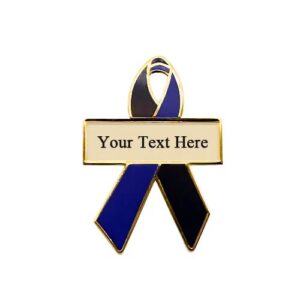
- Eye Cancer: Eye cancer includes several rare types of cancers that begin in the eye, including your eyeball and the structures surrounding your eyeball. Eye cancer starts when cells multiply out of control and form a tumor. Tumors can be benign (noncancerous) or malignant (cancerous).
- Intraocular Melanoma, Adult: Intraocular Melanoma is a rare cancer that forms in the eye. It usually has no early signs or symptoms. As with Melanoma of the skin, risk factors include having fair skin and light-colored eyes.
- Intraocular Melanoma, Childhood: Intraocular Melanoma begins in the middle of three layers of the wall of the eye. The middle layer, where Intraocular Melanoma forms, is called the uvea or uveal tract. The alternate color for Intraocular Melanoma in children is gold.
- Loss of an Adult Child / In Memory of an Adult Child
- Ocular Cancer: Ocular cancer is one that forms in tissues of and around the eye. Some of the cancers that may affect the eye include melanoma (a rare cancer that begins in cells that make the pigment melanin in the eye), carcinoma (cancer that begins in tissues that cover structures in the eye), lymphoma (cancer that begins in immune system cells), and retinoblastoma (cancer that begins in the retina and usually occurs in children younger than 5 years).
- Ocular Melanoma: Ocular Melanoma is a cancer in pigment-producing cells of the eye called melanocytes
- Police Officers Lost in the Line of Duty: Black and Navy represents any law enforcement officer who has died as a direct or indirect result of a personal injury sustained in the line of duty. This includes law enforcement officers who, while in an off-duty capacity, act in direct response to an emergency situation involving the general public or a violation of the law.
- Uveal Melanoma: Ocular Melanoma or, more specifically, Uveal Melanoma is the most common primary intraocular cancer in adults.
Black and Pink Awareness Ribbons: Colors and causes symbolize, stand for and support:


- Loss of a Daughter / In Memory of a Daughter
- Loss of a Female Loved One / In Memory of a Female Loved One
- Loss of a Mother / In Memory of a Mother
- Loss of a Sister / In Memory of a Sister
Black and Red Awareness Ribbons: Colors and causes symbolize, stand for and support:
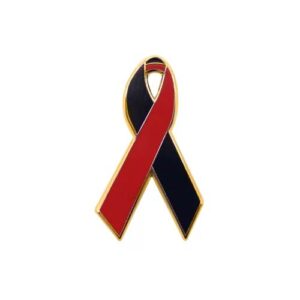
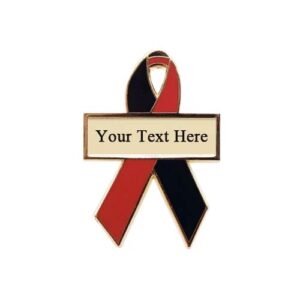
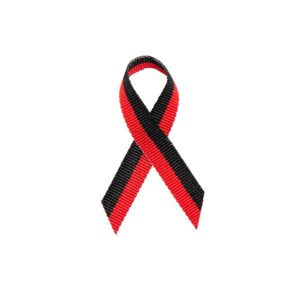
- Genocide: Genocide is the intentional and systematic destruction of a human group, defined by the perpetrator, with the goal of eliminating the group's ability to maintain its existence. This is different from other mass crimes against humanity because it aims to destroy the group's social and cultural cohesion, not just its individual members.
- In Memory of Murder Victims: The annual National Day of Remembrance for Murder Victims gives people the opportunity to remember those lost to homicide, and honor their memories.
- Murder Victims: In addition to pins to remember victims of homicide, black and red pins show support for survivors of homicide victims.
- Murdered Children: In 2007, Congress designated September 25 as the National Day of Remembrance for Murder Victims. Robert and Charlotte Hullinger, of Cincinnati, formed Parents of Murdered Children following the 1978 murder of their 19-year-old daughter, Lisa, while she was studying in Germany. The annual day of observance is on the date Lisa was murdered. The annual National Day of Remembrance for Murder Victims provides the opportunity to remember those lost to homicide, and honor their memories. The purpose of this event is to focus on the impact of murder on families, and communities, and ways to support and serve survivors.
- Sepsis: Sepsis is defined as "life-threatening organ dysfunction due to a dysregulated host response to infection." The new criteria are based on just three symptoms: Altered mental status, fast respiratory rate and low blood pressure.
- Shwachman-Diamond Syndrome: Shwachman-Diamond syndrome is an inherited condition that affects many parts of the body, particularly the bone marrow, pancreas, and skeletal system. Most cases of Shwachman-Diamond Syndrome are caused by mutations in the SBDS gene.
Black and White Awareness Ribbons: Colors and causes symbolize, stand for and support:
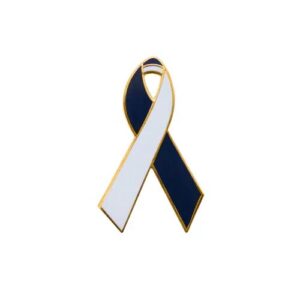

- Acute Disseminated Encephalomyelitis: Acute Disseminated Encephalomyelitis is a neurological condition characterized by a brief but intense attack of inflammation in the brain and spinal cord. This may lead to damage of the layer of insulation around the nerves (myelin) within affected areas. ADEM often follows viral infection, or less often, vaccinations for measles, mumps, or rubella (MMR). Symptoms usually appear rapidly, beginning with fever, fatigue, headache, nausea and vomiting.
- Anti-Corruption: Corruption is the use of public office for private gain. It includes crimes such as extortion, bribery, racketeering, or embezzlement. It also includes unethical acts and patronage such as revolving doors for government employees and capture of the regulatory process by the powerful and connected.
- Vaccine Injury: Any vaccine can cause side effects, but for the most part, the side effects are minor. Common side effects are pain, swelling, and redness at the injection site, low-grade fever, shivering, fatigue, headache, muscle aches, and joint aches. The side effects for all the different vaccines can be found on the CDC web site (https://www.cdc.gov/vaccines/vac-gen/side-effects.htm). There are rare serious side effects that can be serious or even fatal. However, many more people died of vaccine-preventable diseases prior to vaccines than ever suffer serious complications of vaccines. The alternate color for vaccine injury is black.
Black and White Pinstripes Awareness Ribbons: Colors and causes symbolize, stand for and support:
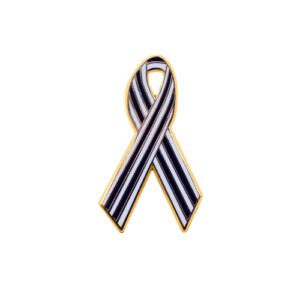

- Breast Implant Illness or Injury, Toxicity or Silicone Poisoning: Breast Implant Illness, Injury, Toxicity or Silicone Poisoning is a collection of symptoms that occur in people with breast implants. There is no official medical diagnosis for Breast Implant Illness or Injury. Symptoms may include fatigue, joint pain, brain fog, dry eyes and many other health concerns. Healthcare providers diagnose Breast Implant Injury or Illness by ruling out other health conditions. Symptoms vary from body to body due to personal differences, the type of breast implants and the progression of the illness. However, it appears that some symptoms show up earlier and more consistently, such as those mentioned above, and recurring infections and problems with thyroid and adrenals, or other endocrine glands.
Blood Drop Type 1 Diabetes T1D Awareness Ribbons: Colors and causes symbolize, stand for and support:
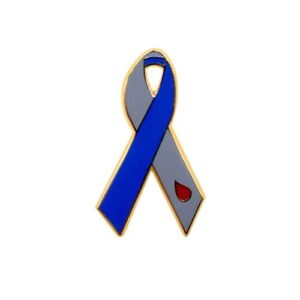

- Diabetes Mellitus Type 1 / Juvenile Diabetes / Type 1 Diabetes / T1D: Diabetes is a disease that occurs when blood glucose, also called blood sugar, is too high. Blood glucose is the main source of energy and comes from food. Insulin, a hormone made by the pancreas, helps glucose from food get into cells to be used for energy. Sometimes the body does not make enough, or any, insulin or does not use insulin well. Glucose then stays in the blood and does not reach the body's cells.
- Type 2 Diabetes: Type 2 diabetes is a condition that happens because of a problem in the way the body regulates and uses sugar as a fuel. That sugar also is called glucose. This long-term condition results in too much sugar circulating in the blood. Eventually, high blood sugar levels can lead to disorders of the circulatory, nervous and immune systems. Type 2 diabetes used to be known as Adult-Onset Diabetes, but both Type 1 and Type 2 Diabetes can begin during childhood and adulthood. Type 2 is more common in older adults. But the increase in the number of children with obesity has led to more cases of Type 2 Diabetes in younger people.
- Hyperglycemia: Hyperglycemia, also known as high blood sugar, is a condition that occurs when there is a higher-than-normal amount of glucose in the blood. It can be a sign of diabetes or other conditions. Hyperglycemia can affect people of any age. In people with diabetes, it can occur when the body doesn't produce enough insulin or can't use it properly, causing too much glucose to remain in the blood and not reach the cells. It can also develop if diabetes is not treated properly. Symptoms of Hyperglycemia include excessive thirst, hunger, fatigue, and an urge to urinate more than usual.
Blue Awareness Ribbons: Colors and causes symbolize, stand for and support:
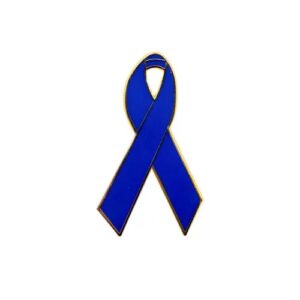

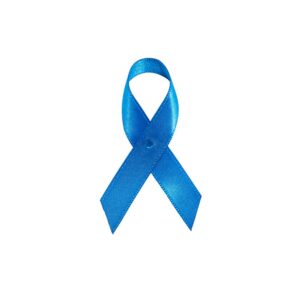
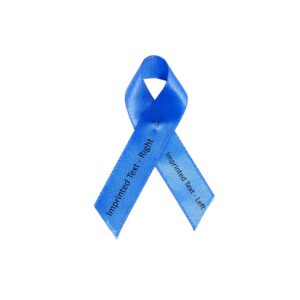


- Ankylosing Spondylitis: Ankylosing Spondylitis is a form of arthritis featuring chronic inflammation of the spine and the sacroiliac joints. Over time, chronic inflammation of the spine (spondylitis) can lead to a complete fusion of the vertebrae, a process referred to as ankylosis. Ankylosis causes loss of mobility of the spine.
- Apraxia: Aphasia is a neurological disorder caused by damage to the portions of the brain responsible for language. Primary signs of Apraxia include difficulty in expressing oneself when speaking, trouble understanding speech, and difficulty with reading and writing. Aphasia is not a disease, but a symptom of brain damage.
- Arthritis: Arthritis literally means inflammation of one or more joints. Arthritis is a joint inflammation disorder. Arthritis is frequently accompanied by joint pain. Joint pain is referred to as arthralgia. The alternate color for arthritis is purple and blue.
- Arthritis, Enthesitis-Related: Enthesitis-Related Arthritis is a disease predominantly affecting the joints and entheses of the lower extremities and has the potential to eventually affect the sacroiliac joints and spine evolving to Juvenile Ankylosing Spondylitis. The alternate color for arthritis is purple and blue.
- Arthritis, Infectious: Infectious Arthritis is joint pain, soreness, stiffness and swelling caused by a bacterial, viral, or fungal infection that spreads from another part of the body. Depending on the type of infection, one or more joints may be affected. The alternate color for arthritis is purple and blue.
- Arthritis, Inflammatory: Inflammatory arthritis includes a group of arthritis accompanied by joint pain, swelling, warmth, and tenderness in the joints, and morning stiffness that lasts for an hour. Because most of the inflammatory forms of arthritis are systemic, symptoms related to inflammation may occur in other parts of the body, including skin rashes, eye inflammation, hair loss, dry mouth, and fever. The alternate color for arthritis is purple and blue.
- Arthritis, Juvenile: Also known as Pediatric Rheumatic Disease, Juvenile Arthritis is an umbrella term used to describe the many autoimmune and inflammatory conditions or Pediatric Rheumatic Diseases that can develop in children under the age of 16. Although the various types of juvenile arthritis share many common symptoms, like pain, joint swelling, redness and warmth, each type of Juvenile Arthritis is distinct and has its own special concerns and symptoms. Some types of Juvenile Arthritis affect the musculoskeletal system, but joint symptoms may be minor or nonexistent. Juvenile Arthritis can also involve the eyes, skin, muscles and gastrointestinal tract. The alternate color for arthritis is purple and blue.
- Arthritis, Juvenile Idiopathic: Juvenile Idiopathic Arthritis, formerly known as Juvenile Rheumatoid Arthritis, is the most common type of arthritis in children under the age of 16. Juvenile Idiopathic Arthritis can cause persistent joint pain, swelling and stiffness. Some children may experience symptoms for only a few months, while others have symptoms for many years. Some types of Juvenile Idiopathic Arthritis can cause serious complications, such as growth problems, joint damage and eye inflammation. Treatment focuses on controlling pain and inflammation, improving function, and preventing damage. The alternate color for arthritis is purple and blue.
- Arthritis, Juvenile Rheumatoid: Juvenile Rheumatoid Arthritis (JRA), often referred to by doctors today as Juvenile Idiopathic Arthritis, is a type of arthritis that causes joint inflammation and stiffness for more than six weeks in a child aged 16 or younger. It affects approximately 50,000 children in the United States. JRA is an autoimmune disorder. The alternate color for arthritis is purple and blue.
- Arthritis, Reactive / Reiter's Syndrome: Reactive Arthritis, formerly known as Reiter's Syndrome, is a form of inflammatory arthritis that develops in response to an infection in another part of the body. Reactive Arthritis is an inflammatory type of Arthritis which affects the joints, and may affect the eyes, skin and urinary tract (bladder, vagina, urethra). The alternate color for arthritis is purple and blue.
- Arthritis, Systemic Juvenile Idiopathic: Systemic Juvenile Idiopathic Arthritis is the most common type of arthritis in children where the immune system mistakenly attacks the body’s tissues, causing inflammation in joints and potentially other areas of the body. The alternate color for arthritis is purple and blue.
- At-Risk Youth: An At-Risk youth is a child who is less likely to transition successfully into adulthood.
- Autoimmune Autonomic Ganglionopathy: Autoimmune Autonomic Ganglionopathy is a rare autoimmune disorder in which the body's immune system mistakenly attacks and damages certain parts of the autonomic nervous system. Signs and symptoms may include severe orthostatic hypotension (low blood pressure upon standing). fainting, constipation, fixed and dilated pupils, urinary retention, and/or dry mouth and eyes. The alternate color for autoimmune autonomic ganglionopathy is teal.
- Autoimmune Autonomic Neuropathy: Autoimmune Autonomic Neuropathy is a disorder of difficulties maintaining blood pressure, usually combined with gastrointestinal problems and dry eyes or non-reactive pupils. The alternate color for autoimmune autonomic neuropathy is purple.
- Autonomic Dysfunction: Autonomic Dysfunction can affect a small part of the Autonomic Nervous System or the entire Autonomic Nervous System. Some symptoms of an autonomic nerve disorder include dizziness orthostatic hypotension, an inability to alter heart rate with exercise, or exercise intolerance.
- Brain Injury: A brain injury is a disruption to the brains normal function. This can be caused by several factors, such as a blow to the head, disease, infection, or lack of oxygen. The alternate color for brain injury is green.
- Bullying Prevention: Bullying is unwanted, aggressive behavior among school-aged children that involves a real or perceived power imbalance. The behavior is repeated, or has the potential to be repeated, over time. Bullying can also occur in teen-age or adult populations. The alternate color for bullying is orange.
- Bursitis: Bursitis is a painful condition that affects the small, fluid-filled sacs that cushion the bones, tendons and muscles near the joints. Bursitis occurs when these sacs become inflamed. The most common locations for Bursitis are in the shoulder, elbow and hip.
- Calcium Pyrophosphate Deposition Disease: Calcium Pyrophosphate Deposition Disease occurs when crystals form deposits in the joint and surrounding tissues. The crystal deposits cause inflammation in the joint, which can damage the joint cartilage. The disease may take the form of osteoarthritis, a chronic rheumatoid arthritis-like inflammatory arthritis, or an acutely painful inflammatory condition called Pseudogout.
- Carpal Tunnel Syndrome: Carpal Tunnel Syndrome is caused by irritation of the median nerve at the wrist. Irritation of the median nerve causes tingling and numbness of the thumb, index, and the middle fingers.
- Charcot-Marie-Tooth Disease: Charcot-Marie-Tooth Disease is a group of disorders that affect the peripheral nerves. There are over forty types of Charcot-Marie-Tooth Disease. The alternate color for Charcot-Marie-Tooth disease is gray or orange and blue.
- Child Abuse / Child Neglect: Child Abuse is any injury that is intentionally inflicted on a child by a caregiver or during discipline. Neglect, physical, and sexual abuse are types of Child Abuse that typically result in reporting to and intervention by authorities.
- Child Exploitation: Child Exploitation can affect any child or young person, male or female, under the age of 18. The main types of Child Exploitation experienced by young people are criminal and sexual exploitation. The alternate color for child exploitation is white.
- Child Labor: Child Labor refers to the exploitation of children through any form of work that deprives children of their childhood, interferes with their ability to attend school regularly, and is mentally, physically, socially and morally harmful.
- Chronic Fatigue Syndrome: Chronic Fatigue Syndrome is defined by two major criteria, chronic severe fatigue for at least six months not caused by a diagnosable disease or relieved with rest and at least four other specific symptoms that occur simultaneously or after the development of severe fatigue. These include cognitive impairment, muscle and/or joint pain, new types of headaches, tender lymph nodes, sore throat, un-refreshing sleep, and malaise after exercise. In 2015, the Institute of Medicine proposed a new name for this syndrome, Systemic Exertion Intolerance Disease.
- Chronic Inflammatory Demyelinating Polyneuropathy: Chronic Inflammatory Demyelinating Polyneuropathy is a neurological disorder that causes progressive weakness and impaired sensory function in the legs and arms. Symptoms include tingling or numbness in the toes and fingers, weakness of the arms and legs, loss of deep tendon reflexes, fatigue, and abnormal sensations. CIDP is thought to be caused by the immune system mistakenly attacking and damaging the myelin sheath of the peripheral nerves. Chronic Inflammatory Demyelinating Polyneuropathy is closely related to Guillain-Barre Syndrome and is considered the "chronic counterpart" of Guillain-Barre Syndrome.
- Colon Cancer, Adult: Colorectal Cancer is a malignant tumor arising from the inner wall of the large intestine (colon) or rectum. It is the third leading cause of cancer in both men and women in the United States. Common risk factors for colorectal cancer include increased age, African American race, a family history of colorectal cancer, colon polyps, and long-standing ulcerative colitis. Most colorectal cancers develop from polyps. Removal of colon polyps can aid in the prevention of colorectal cancer. Colon polyps and early cancer may have no cancer-specific signs or symptoms.
- Colon Cancer, Childhood: Carcinoma of the large bowel is rare in children. It is seen in 1 case per 1 million people younger than 20 years in the United States annually. Fewer than 100 cases are diagnosed in children each year in the United States. The alternate color for childhood colon cancer is gold.
- Colorectal Cancer, Adult: Colorectal Cancer often begins as a growth called a polyp inside the colon or rectum. Finding and removing polyps can prevent colorectal cancer. Worldwide, colorectal cancer is the third most common form of cancer.
- Colorectal Cancer, Childhood: Childhood Colorectal Cancer may be part of an inherited syndrome. Some colorectal cancers in young people are linked to a gene mutation that causes polyps to form that may turn into cancer later. The risk of colorectal cancer is increased by having certain inherited conditions. The alternate color for colorectal cancer in children is gold.
- Crime Victims' Rights: Victims' rights are legal rights afforded to victims of crime. These may include the right to restitution, the right to a victims' advocate, the right not to be excluded from criminal justice proceedings, and the right to speak at criminal justice proceedings. The alternate color for crime victims' rights is black and red.
- Cushing Syndrome: Cushing’s Syndrome is a disorder that occurs when the body makes too much of the hormone cortisol over a long period of time. Cortisol is sometimes called the “stress hormone” because it helps the body respond to stress. The alternate color for arthritis is yellow and blue.
- Cyclic Vomiting Syndrome: Cyclic Vomiting Syndrome is a condition characterized by recurrent, prolonged episodes of severe nausea and vomiting. Episodes of vomiting may last hours or days. Most people with Cyclic Vomiting Syndrome are symptom-free in between episodes. The condition can begin at any age, but it most often begins in childhood.
- Dermatomyositis, Adult: Dermatomyositis is one of a group of acquired muscle diseases called inflammatory myopathies, which are characterized by chronic muscle inflammation accompanied by muscle weakness and a skin rash. Dermatomyositis may occur at any age but is most common in adults in their late 40s to early 60s, or children between 5 and 15 years of age. There is no cure for dermatomyositis, but the symptoms can be treated.
- Dermatomyositis, Juvenile: Juvenile Dermatomyositis is a disease in children that causes skin rash and muscle inflammation, resulting in weak muscles. Juvenile Dermatomyositis is a type of autoimmune disease. In autoimmune diseases such as JDM, cells fight the body's own tissues and cells, causing inflammation and, in some cases, tissue damage.
- Developmental Disabilities: Developmental disabilities are a group of conditions due to an impairment in physical, learning, language, or behavior areas. These conditions begin during the child's developmental period, may impact day-to-day functioning, and usually last throughout a person's lifetime. Most developmental disabilities begin before a baby is born, but some can happen after birth because of injury, infection, or other factors.
- Developmental Learning Disorders: Developmental learning disorders affect many children, impairing their experience in the classroom and hindering aspects of their life. Several learning disorders can now be successfully alleviated, directly benefiting from promising interventions. Two of the most prevalent learning disorders are Dyslexia and Attention-Deficit/Hyperactivity Disorder (ADHD).
- Dyspraxia: Dyspraxia, a form of developmental coordination disorder, affects fine and/or gross motor coordination in children and adults. It may also affect speech. Dyspraxia is a lifelong condition.
- Dystonia: Dystonia is a disorder characterized by involuntary muscle contractions that cause slow repetitive movements or abnormal postures. Some forms of Dystonia are genetic but the cause of most cases is not known.
- Education: Education helps students to develop critical skills, problem-solving skills and cognitive skills. Education allows students to become self-sufficient and Independent. Education helps students contribute to the well-being of society and create equal opportunities for both men and women.
- Enthesitis: Enthesitis is the medical term for inflammation of one or more entheses. Entheses are sites at which tendons and ligaments attach to bones. Enthesitis can cause symptoms such as joint pain and stiffness and problems with mobility. The condition can develop because of overuse, injuries, or underlying diseases.
- Epstein-Barr Virus: The Epstein-Barr Virus (EBV) is a herpes virus that is found worldwide and is a common cause of infectious mononucleosis. The cause of an Epstein-Barr Infection (mononucleosis) is EBV. Risk factors include intimate contacts with body secretions, especially saliva, and objects that may be exposed to body secretions of infected people. The Epstein-Barr Virus is contagious and is spread from person to person.
- Erb's Palsy: Erb’s Palsy, also known as Erb-Duchenne Palsy, is a nerve disorder that occurs because of an injury during birth. Erb’s Palsy affects about one or two out of every 1,000 children born.
- Familial Adenomatous Polyposis: Familial Adenomatous Polyposis is an inherited condition that causes cancer of the large intestine (colon) and rectum. People usually develop hundreds to thousands of noncancerous polyps in the colon as early as their teenage years. Over time, these polyps can become cancerous, leading to early-onset colorectal cancer at an average age of 39 years. Some people have a milder form of the condition called Attenuated Familial Adenomatous Polyposis which is generally characterized by fewer colon polyps and a delay in the development of colon cancer by 10-15 years.
- Female Genital Mutilation Prevention Blue Ribbon Campaign: Female genital mutilation (FGM) is a procedure where the female genitals are deliberately cut, injured or changed, but there is no medical reason for this to be done. It's also known as female circumcision or cutting, and by other terms, such as Sunna, gudniin, halalays, tahur, megrez and khitan, among others. The alternate color for female genital mutilation is red.
- Fibromuscular Dysplasia: Fibromuscular Dysplasia is characterized by abnormal development or growth of cells in the walls of blood vessels (arteries) that can cause vessel narrowing. The carotid arteries are commonly affected. Arteries within the brain and kidneys can also be affected. Some people experience no symptoms of the disease while others may experience high blood pressure, dizziness or vertigo, chronic headache, ringing in the ears, weakness or numbness in the face, neck pain, or changes in vision.
- Free Speech: Free Speech is a principle that supports the freedom of an individual or a community to articulate their opinions and ideas without fear of retaliation, censorship, or legal sanction.
- Gambling Addiction: Gambling involves taking a risk on an unclear outcome or event by risking something of value (usually money) with the intent of trying to win an item of higher value. A gambling disorder is identified by a pattern of repeated and ongoing betting and wagering that continues despite creating multiple problems in several areas of an individual’s life. Individuals in any age group may suffer from gambling disorder. Those who suffer from gambling disorder have trouble controlling gambling. Individuals, families, and society may be affected by gambling disorder.
- Gout: Gout is a type of arthritis that causes sudden joint inflammation, usually in a single joint. Gout is caused by too much uric acid in the bloodstream and accumulation of uric acid crystals in tissues of the body.
- Growth Hormone Deficiency: Growth Hormone Deficiency (GHD), also known as dwarfism or pituitary dwarfism, is a condition caused by insufficient amounts of growth hormone in the body. Children with Growth Hormone Deficiency have abnormally short stature with normal body proportions.
- Guillain-Barre Syndrome: Guillain-Barré Syndrome is a rare syndrome in which the body’s immune system attacks part of the peripheral nervous system. Symptoms of Guillain-Barre Syndrome include muscle weakness, numbness, and tingling, which can increase in intensity until the muscles cannot be used at all (paralysis). The exact cause of Guillain-Barré Syndrome is unknown.
- Harassment Prevention: Harassment is a type of discrimination that involves unwelcome, offensive, or humiliating behavior or comments that can be verbal or physical.
- Histiocytosis: Histiocytosis is a rare blood disease caused by abnormal increase in the number of immune cells called histiocytes. Histiocytosis is not technically a cancer. But, because it is so similar to cancer, it is primarily treated by oncologists with chemotherapy and/or steroids.
- Histiocystosis, Langerhans Cell: Langerhans Cell Histiocytosis is a disorder that primarily affects children, but is also found in adults. People with Langerhans Cell Histiocytosis produce too many Langerhans cells or histiocytes, a form of white blood cells found in healthy people that are supposed to protect the body from infection. In people with LCH, these cells multiply excessively and build up in certain areas of the body, causing tumor formations called granulomas.
- Human Slavery (Modern Slavery): Modern Slavery is defined as the recruitment, movement, harboring or receiving of children, women or men by force, coercion, abuse of vulnerability, deception or other means for the purpose of exploitation. Children are among the most vulnerable to slavery. There are 8.4 million children currently suffering exploitation all over the world. At least 4.8 million are enduring sexual exploitation. There are an estimated 20.1 million people in forced labor. They are coerced through violence, intimidation or subtler techniques such as debt-accumulation or the retention of documents.
- Human Trafficking: Human Trafficking is modern-day slavery and involves the use of force, fraud, or coercion to obtain some type of labor or commercial sex act. Every year, millions of men, women, and children are trafficked in countries around the world, including the United States. It is estimated that Human Trafficking generates many billions of dollars of profit per year, second only to drug trafficking as the most profitable form of transnational crime. Human Trafficking is a hidden crime as victims rarely come forward to seek help because of language barriers, fear of their traffickers, and/or fear of law enforcement.
- Huntington's Disease: Huntington Disease is an inherited condition that causes progressive degeneration of neurons in the brain. Signs and symptoms usually develop between ages 35 to 44 years and may include uncontrolled movements, loss of intellectual abilities, and various emotional and psychiatric problems.
- Hydrocephalus: Hydrocephalus is a condition in which the primary characteristic is excessive accumulation of fluid in the brain. The fluid is actually cerebrospinal fluid, a clear fluid that surrounds the brain and spinal cord. The excessive accumulation of fluid results in an abnormal widening of spaces in the brain (ventricles) and potentially places harmful pressure on the tissues of the brain.
- Hypotension: For some people, low blood pressure causes no problems. However, for many people, abnormally low blood pressure (hypotension) can cause dizziness and fainting. In severe cases, low blood pressure can be life-threatening. A blood pressure reading below 90 for the top number (systolic) or 60 for the bottom number (diastolic) is generally considered Low Blood Pressure.
- Infant Airway Defects: Airway disorders can affect how babies and children breathe, eat, swallow, and sleep. These conditions may be diagnosed before birth or develop over time as the result of an infection or traumatic injury. Blocked airways can also occur suddenly. If your child experiences a sudden blockage in their airway from an object, allergic reaction, or any other reason, call 911 immediately.
- Klinefelter Syndrome (47,XXY): Klinefelter Syndrome, also known as the XXY condition, is a term used to describe males who have an extra X chromosome in most of their cells. Instead of having the usual XY chromosome pattern that most males have, these men have an XXY pattern. Even though all men with Klinefelter Syndrome have the extra X chromosome, not every XXY male has all of those symptoms. The alternate color for Klinefelter syndrome is green.
- Laryngomalacia: Laryngomalacia is best described as floppy tissue above the vocal cords that falls into the airway when a child breathes in. It is the most frequent cause of noisy breathing (stridor) in infants and children. It is also the most common birth defect of the voice box (larynx).
- Leukodystrophy: Leukodystrophy is a type of rare genetic disorder that affects the brain, spinal cord, and other nerves in the body. It is caused by destruction of the white matter of the brain. The leukodystrophies are a group of disorders caused by mutations in the genes involved in making myelin. Myelin is needed to protect the nerves, and the nerves cannot function normally without it.
- Malaria: Malaria is a serious and sometimes fatal disease caused by a parasite that commonly infects a certain type of mosquito which feeds on humans. Infection with malaria parasites may result in a wide variety of symptoms, ranging from absent or very mild symptoms to severe disease and even death. People who get malaria are typically very sick with high fevers, shaking chills, and flu-like illness. In general, malaria is a curable disease if diagnosed and treated promptly and correctly.
- Mesothelioma: Mesothelioma is a rare cancer that forms in the thin tissue that lines the internal organs, called the mesothelium. It is most often caused by exposure to asbestos, but any amount of exposure can cause the disease. The alternate color for mesothelioma is pearl.
- Misophonia: Misophonia, translated as “hatred of sound,” is a chronic condition that causes intense emotional reactions to specific sounds. Symptoms usually start in childhood or early teenage years, and severity increases over time. The cause of Misophonia is not known.
- Myalgic Encephalomyelitis / Chronic Fatigue Syndrome / ME / CFIDS: Myalgic Encephalomyelitis (ME) is defined by distinctive neuro-muscular symptoms including prolonged muscle weakness after minor exertion, neurological symptoms indicative of cerebral dysfunction, circulatory impairment, and a chronic relapsing course. Symptoms vary and fluctuate and are usually chronic. The cause is still unknown, but most investigators believe that the disorder is most likely the result of an abnormal immune system response to an infection or virus.
- Myositis / Polymyositis / Dermatomyositis: Myositis is a term meaning inflammation in the muscles. There are several types of myositis, the most common being polymyositis and dermatomyositis. Polymyositis causes muscle weakness around the middle of the body and affects both sides of the body. Dermatomyositis causes muscle weakness as well as a skin rash.
- Myositis, Inclusion Body: Inclusion Body Myositis is a progressive muscle disorder characterized by muscle inflammation, weakness, and atrophy. The symptoms and rate of progression vary from person to person. Common symptoms include progressive weakness of the legs, arms, fingers, and wrists.
- Myositis, Juvenile: Juvenile myositis is a rare autoimmune disease that causes inflammation in the muscles, skin, and blood vessels of children. The most common type of juvenile myositis is juvenile dermatomyositis (JDM), which is characterized by a specific rash. Other types of juvenile myositis include polymyositis, which is even rarer and doesn't have a characteristic rash.
- Neurocardiogenic Syncope (Vasovagal Syncope): Neurocardiogenic syncope (also known as vasovagal syncope) is a benign condition characterized by a self-limited episode of systemic hypotension. Neurocardiogenic Syncope is caused by an abnormal or exaggerated autonomic response to various stimuli, of which the most common are standing and emotion.
- Osteoarthritis: Sometimes called Degenerative Joint Disease or “wear and tear” arthritis, Osteoarthritis is the most common chronic condition of the joints. It occurs when the cartilage or cushion between joints breaks down leading to pain, stiffness and swelling
- Patellofemoral Pain Syndrome: Patellofemoral Pain Syndrome is a broad term used to describe pain in the front of the knee and around the patella, or kneecap. It is sometimes called "runner's knee" or "jumper's knee" because it is common in people who participate in sports.
- Pneumonia: Pneumonia is an infection that inflames the air sacs in one or both lungs. The air sacs may fill with fluid or pus (purulent material), causing cough with phlegm or pus, fever, chills, and difficulty breathing. A variety of organisms, including bacteria, viruses and fungi, can cause pneumonia.
- Polymyositis: Polymyositis is a rare disease that makes the immune system attack the body's muscles. It causes inflammation and weakness in muscles close to the center of the body, which can lead to severe, life-threatening complications.
- Precocious Puberty: Precocious puberty is when children's bodies begin to change into adult bodies too soon. This change is known as puberty. Most of the time, puberty occurs after age 8 in girls and after age 9 in boys. However, Black, Hispanic, and Native American children might naturally reach puberty earlier.
- Pseudogout: Pseudogout often resembles gout and, like gout, is caused by the formation of crystals in the joints. Instead of being composed of uric acid, as true gout crystals are, the crystals in Pseudogout are composed of a salt called calcium pyrophosophate dihydrate (CPPD). The condition is also called CPPD Disease.
- Rabies: Rabies is a viral disease that affects the central nervous system and can be transmitted to humans and other mammals from infected animals. It is almost always fatal once symptoms appear.
- Rectal Cancer: Rectal Cancer is a disease in which cancer cells form in the tissues of the rectum. Colorectal Cancer often begins as a growth called a polyp inside the colon or rectum.
- Respiratory Distress Syndrome, Infant: Infant respiratory distress syndrome (IRDS), also known as neonatal respiratory distress syndrome (RDS), is a condition that makes it difficult for babies to breathe. IRDS is caused by a lack of surfactant, a substance that helps the lungs fill with air. This can be due to the lungs not being fully developed, or genetic problems with lung development. IRDS is more common in babies born before 37 to 39 weeks, or who are born prematurely.
- Restless Leg Syndrome: Restless Leg Syndrome is a condition marked by a strong urge to mover the legs and unpleasant leg sensations while resting and sleeping. The leg pain of Restless Leg Syndrome typically eases with motion of the legs and becomes more noticeable at rest.
- Rheumatism: The term “rheumatism” was used historically to describe a number of rheumatic conditions. It is no longer used by medical professionals, who stress the importance of obtaining a specific diagnosis in order to get proper treatment. The alternate color for rheumatism is purple and blue.
- Rheumatism, Palindromic: Palindromic Rheumatism is a rare episodic form of inflammatory arthritis. Between attacks, symptoms disappear and the affected joints go back to normal, with no lasting damage. Half of the people who have palindromic rheumatism eventually develop rheumatoid arthritis, which does cause permanent joint damage. The alternate color for palindromic rheumatism is purple and blue.
- Save the Waves: Save The Waves protects coastal ecosystems around the world in partnership with local communities, utilizing a unique combination of protected areas, economics, and direct action.
- Sensory Processing Disorder: Besides sound, touch, taste, sight and smell, there are also two other less known senses. They are proprioception, or a sense of body awareness, and vestibular sense, which involves movement, balance, and coordination. Kids with sensory processing issues experience too much or too little stimulation through these senses. The alternate color for sensory processing disorder is orange.
- Sex Slavery / Sex Trafficking: Human trafficking is a form of modern-day slavery. This crime occurs when a trafficker uses force, fraud or coercion to control another person for the purpose of engaging in commercial sex acts or soliciting labor or services against his/her will. Force, fraud, or coercion need not be present if the individual engaging in commercial sex is under 18 years of age.
- 1 (888) 373-7888 / TTY: 711 for the National Human Trafficking Hotline
SMS: 233733 (Text "HELP" or "INFO")
- Hours: 24 hours, 7 days a week
Languages: English, Spanish and 200 more languages
- Short Bowel Syndrome: Short Bowel Syndrome is a disorder characterized by malabsorption of nutrients due to problems involving the small intestine. In children the main causes include necrotizing enterocolitis, intestinal atresias, and intestinal volvulus.
- Spinal Stenosis: Spinal Stenosis is narrowing of the spinal column due to arthritis that leads to a bony overgrowth of vertebrae and a thickening of ligaments. If a significant overgrowth occurs, the narrowing can press on the nerves in the spine. The alternate color for spinal stenosis is green.
- Spondylitis (See Ankylosing Spondylitis): Ankylosing Spondylitis has no known specific cause, though genetic factors seem to be involved. In particular, people who have a gene called HLA-B27 are at a greatly increased risk of developing Ankylosing Spondylitis. However, only some people with the gene develop the condition.
- Spondyloarthritis: Spondyloarthritis is an umbrella term for inflammatory diseases that involve both the joints and the entheses (the sites where the ligaments and tendons attach to the bones). The most common of these diseases is Ankylosing Spondylitis.
- Stevens-Johnson Syndrome: Stevens-Johnson Syndrome is a very severe reaction that mainly affects the skin, mucous membranes, and eyes. It is often triggered by particular medications. This syndrome is an emergency medical condition that usually requires hospitalization and can be life-threatening. Symptoms may include fever and flu-like symptoms, followed by painful blistering of the skin and mucous membranes.
- Stop Plastic Pollution in our Oceans: Ocean trash affects the health of wildlife, people and local economies. Trash in the water and on the shore can be mistaken as food by wildlife or entangle animals with lethal consequences. Plastic also attracts and concentrates other pollutants from surrounding seawater, posing a contamination risk to those species that then eat it.
- Syringomyelia: Syringomyelia is a condition in which a cyst, called a syrinx, forms within the spinal cord. This cyst expands and elongates over time, destroying the center of the spinal cord.
- Tardive Dyskinesia: Tardive dyskinesia (TD) is a chronic condition that causes involuntary, repetitive movements in the body, usually due to. along-term use of certain medications.
- Targeted Individuals of Bullying / Harassment / Stalking: Children can be bullied. No single factor puts a child at risk of being bullied (targeted) by others. Depending on the environment, some groups, such as lesbian, gay, bisexual, or transgendered (LGBTQ+) youth, youth with disabilities, and socially isolated youth, may be at an increased risk of being bullied or targeted. Adults can also be bullied, especially in the workplace.
- Tay Sachs Disease: Tay-Sachs disease is a rare, inherited genetic disorder that destroys nerve cells in the brain and spinal cord, causing progressive neurological deterioration.
- Tendinitis: Tendinitis is inflammation or irritation of a tendon, the thick fibrous cords that attach muscle to bone. The condition causes pain and tenderness just outside a joint.
- Transverse Myelitis: Transverse Myelitis is a neurological disorder caused by inflammation of the spinal cord, which carries nerve signals from the brain to the rest of the body. Most commonly, the upper spinal cord is affected, causing impaired leg movement, and problems controlling the bowel and bladder. The onset of symptoms may be acute or subacute. The cause of Transverse Myelitis may be unknown or associated with a wide variety of underlying health problems, including infections, immune system disorders, and other inflammatory disorders.
- UNICEF: UNICEF works in the world's toughest places to reach the most disadvantaged children and adolescents – and to protect the rights of every child, everywhere.
Blue and Gray Awareness Ribbons: Colors and causes symbolize, stand for and support:
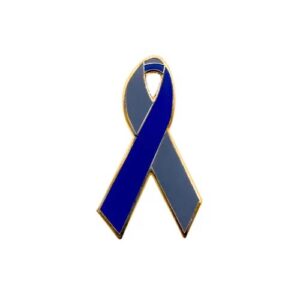

- Diabetes Mellitus Type 1 / Juvenile Diabetes / Type 1 Diabetes / T1D: Diabetes is a disease that occurs when blood glucose, also called blood sugar, is too high. Blood glucose is the main source of energy and comes from food. Insulin, a hormone made by the pancreas, helps glucose from food get into cells to be used for energy. Sometimes the body does not make enough, or any, insulin or does not use insulin well. Glucose then stays in the blood and does not reach the body's cells. The alternate color for diabetes is blood drop.
- Type 2 Diabetes: Type 2 diabetes is a condition that happens because of a problem in the way the body regulates and uses sugar as a fuel. That sugar also is called glucose. This long-term condition results in too much sugar circulating in the blood. Eventually, high blood sugar levels can lead to disorders of the circulatory, nervous and immune systems. Type 2 diabetes used to be known as Adult-Onset Diabetes, but both Type 1 and Type 2 Diabetes can begin during childhood and adulthood. Type 2 is more common in older adults. But the increase in the number of children with obesity has led to more cases of Type 2 Diabetes in younger people. The alternate color for diabetes is blood drop.
- Hyperglycemia: Hyperglycemia, also known as high blood sugar, is a condition that occurs when there is a higher-than-normal amount of glucose in the blood. It can be a sign of diabetes or other conditions. Hyperglycemia can affect people of any age. In people with diabetes, it can occur when the body doesn't produce enough insulin or can't use it properly, causing too much glucose to remain in the blood and not reach the cells. It can also develop if diabetes is not treated properly. Symptoms of Hyperglycemia include excessive thirst, hunger, fatigue, and an urge to urinate more than usual. The alternate color for diabetes is blood drop.
Blue and Green Awareness Ribbons: Colors and causes symbolize, stand for and support:
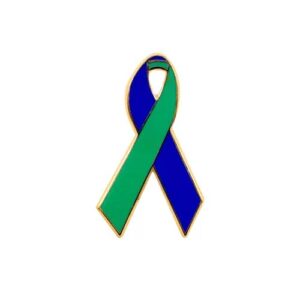

- Adrenoleukodystrophy: Adrenoleukodystrophy, is a deadly genetic disease that most severely affects boys and men. This brain disorder destroys myelin, the protective sheath that surrounds the brain's neurons, the nerve cells that allow thinking and muscle control. The most devastating form of Adrenoleukodystrophy appears in childhood, generally between the ages of four and ten years old. The alternate color for adrenoleukodystrophy is blue.
- Cytomegalovirus: Cytomegalovirus is a common virus in the same family as herpesvirus. Cytomegalovirus is spread by direct contact of body fluids, such as saliva, blood, urine, semen, vaginal fluids, and breast milk. Thus breastfeeding, blood transfusions, organ transplants, and sexual contact are possible modes of transmission. Most healthy people do not experience any symptoms when infected with CMV, and it does not pose a serious health concern. Most adults have antibodies consistent with past infection. The alternate color for cytomegalovirus is silver.
- Dermatillomania: Dermatillomania is a mental health condition where a person compulsively picks or scratches their skin, causing injuries or scarring. Also known as excoriation disorder or skin-picking disorder, this condition falls under the category of obsessive-compulsive disorders. The alternate color for dermatillomania is green.
- Necrotizing Enterocolitis: Premature babies are at risk for necrotizing enterocolitis. The condition causes intestinal tissue to die. It can also cause a hole in the intestine. Bacteria can leak through this hole, causing serious abdominal infections. Switching to IV feedings can help. Some infants need surgery to remove the damaged intestine.
- Neurofibromatosis Type 1: Neurofibromatosis Type 1 (NF1) is a genetic disease that causes tumors to develop in the nervous system. Neurofibromatosis Type 1 causes skin changes, bone abnormalities, optic gliomas, and tumors on the nerve tissue or under the skin. Signs and symptoms are usually present at birth.
- Neurofibromatosis Type 2: Neurofibromatosis Type 2 (NF2) causes acoustic neuromas, hearing loss, ringing in the ears, poor balance, brain and/or spinal tumors, and cataracts at a young age. It often starts in the teen years.
- Paget's Disease of the Bone: Paget's disease of the bone is a chronic disorder that causes bones to grow abnormally, becoming larger, softer, and more likely to break. It's the second most common metabolic bone disease, after osteoporosis
- Schwannomatosis: The third type of Neurofibromatosis is Schwannomatosis, which causes schwannomas, pain, numbness, and weakness. Schwannomas are rarely cancerous but can lead to nerve damage and loss of muscle control.
Blue and White Awareness Ribbons: Colors and causes symbolize, stand for and support:
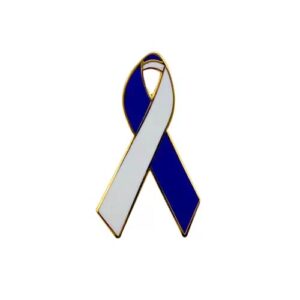

- Adolescent Cancer (Teen Cancer): Teens and young adults with cancer are a group with special needs and have different cancers from young children and older adults. They also have unique social preferences. One study found that adolescent and young adult patients ranked the opportunity to meet other young adult survivors higher than receiving support from family and friends.
- Femoral Acetabular Impingement Syndrome: Hip Impingement Syndrome, also known as Femoral Acetabular Impingement Syndrome, usually affects young and middle-aged adults. Pain is caused because two areas are contacting or impinging on each other, resulting in pain.
Blue and White Pinstripes Awareness Ribbons: Colors and causes symbolize, stand for and support:
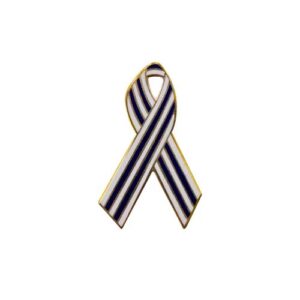

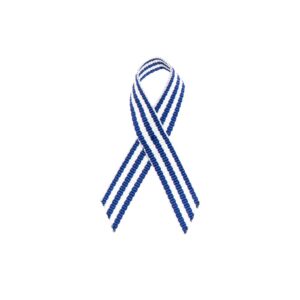
- Amyotrophic Lateral Sclerosis / ALS: Amyotrophic Lateral Sclerosis (ALS) is a progressive neurodegenerative disease that affects nerve cells in the brain and spinal cord. Motor neurons reach from the brain to the spinal cord and from the spinal cord to the muscles throughout the body. The progressive degeneration of the motor neurons in ALS eventually leads to their death. When the motor neurons die, the ability of the brain to initiate and control muscle movement is lost. With voluntary muscle action progressively affected, patients in the later stages of the disease may become totally paralyzed. The alternate color for amyotrophic lateral sclerosis / ALS is red.
- Lou Gehrig's Disease: Lou Gehrig's Disease, also known as ALS, was first found in 1869. It was not until 1939 that Lou Gehrig brought national and international attention to the disease. Ending the career of one of the most beloved baseball players of all time, the disease is still most closely associated with the name, Lou Gehrig. Amyotrophic Lateral Sclerosis (ALS) is a progressive neurodegenerative disease that affects nerve cells in the brain and the spinal cord. The alternate color for Lou Gehrig's disease is red.
- Motor Neuron Diseases: Motor Neuron Diseases are a group of progressive neurological disorders that destroy motor neurons, the cells that control essential voluntary muscle activity such as speaking, walking, breathing, and swallowing. Over time, the ability to control voluntary movement can be lost.
Braille Awareness Ribbons: Colors and causes symbolize, stand for and support:
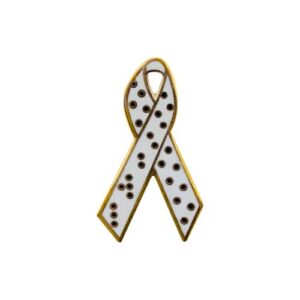

- Blindness: Blindness is a loss of useful sight. Blindness can be temporary or permanent. There are many causes of blindness. The alternate color for blindness is white.
- Visually Challenged: Visually challenged is an adjective that describes someone with significantly reduced vision. Some synonyms for "visually challenged" include Dim-sighted, Near-blind, Purblind, Sand-blind, and Visually impaired. The alternate color for "visually challenged" is white.
- Visually Impaired: Visual impairment is a general term for people who have a decreased ability to see that cannot be corrected with glasses or contacts. Some types of visual impairment include low vision or partially sighted. The term "visually handicapped" is used to describe people who are unable to perform normal activities due to vision loss or defects. The more common term for this condition is visual impairment, which can refer to any degree of vision loss, from partial to total blindness. The alternate color for "visually impaired" is white.
Brown Awareness Ribbons: Colors and causes symbolize, stand for and support:
Burgundy Awareness Ribbons: Colors and causes symbolize, stand for and support:
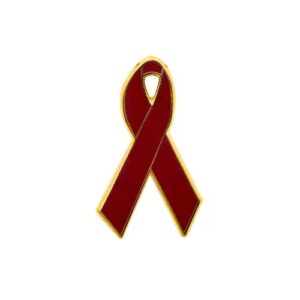

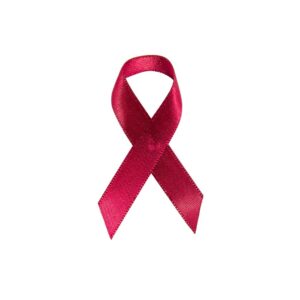
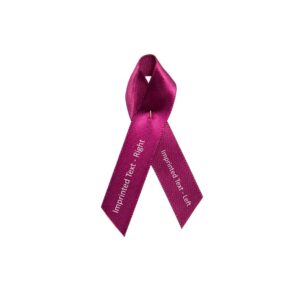


- Abdominal Aortic Aneurysm: An Abdominal Aortic Aneurysm is an enlarged area in the lower part of the major vessel that supplies blood to the body (aorta). The aorta runs from the heart through the center of the chest and abdomen.
- Adhesions: Adhesions are bands of scar-like tissue that form between two surfaces inside the body and cause them to stick together. Pain from adhesions is caused by the increased muscle contraction of the gut trying to force its contents through the narrowed segment. Adhesions can result in long term abdominal pain (chronic pain syndrome), which can be difficult to treat.
- Amyloidosis: Amyloidosis is a term that represents several different types of diseases where an abnormal protein called amyloid is produced. These amyloid protein fibers can attach and deposit into organs, tissues, nerves and other places in the body. When that happens, normal function of the area can be affected. Amyloidosis is considered a rare disease by the U.S. Office of Rare Diseases (ORD), a segment of the National Institutes of Health (NIH). It is also referred to as an “orphan” disease. As a classified rare disease by the U.S. government, this means that it is estimated that all of the types of Amyloidosis combined affects less than 200,000 people in the U.S. population.
- Antiphospholipid Syndrome: Antiphospholipid Syndrome is a disorder of the immune system that is characterized by excessive clotting of blood and/or certain complications of pregnancy and the presence of antiphospholipid antibodies (such as anti-cardiolipin or lupus anticoagulant antibodies) in the blood. Clotting disorders associated with Antiphospholipid Syndrome include stroke, blood clots deep within the legs and clots in the lungs.
- Aortic Aneurysm: Aortic Aneurysm is an abnormal bulge that occurs in the wall of the major blood vessel (aorta) that carries blood from the heart to the body. Aortic Aneurysms can occur anywhere in the aorta and may be tube-shaped or round.
- Aortic Dissection: Aortic Dissection is a serious condition in which a tear occurs in the inner layer of the body's main artery (aorta). Blood rushes through the tear, causing the inner and middle layers of the aorta to split (dissect). If the blood goes through the outside aortic wall, aortic dissection is often deadly.
- Arteriovenous Malformations: Arteriovenous Malformation (AVM) is a rare disease characterized by tangled blood vessels that connect arteries and veins. These tangles disrupt normal blood flow and oxygen circulation and can develop anywhere in the body but are most commonly found afflicting a person’s brain or spine.
- AV Malformation: An arteriovenous malformation (AVM) is an abnormal tangle of blood vessels that causes problems with the connections between the arteries and veins. AVMs most often occur in the spinal cord and in the brain but can develop elsewhere in the body.
- Brain Aneurysm: Brain Aneurysms, also referred to as Cerebral Aneurysms or Intracranial Aneurysms, are a weak bulging spot on the wall of a brain artery. Over time, the blood flow within the artery pounds against the thinned portion of the wall and aneurysms form silently from wear and tear on the arteries. As the artery wall becomes gradually thinner from the dilation, the blood flow causes the weakened wall to swell outward. This pressure may cause the aneurysm to rupture and allow blood to escape into the space around the brain. A ruptured brain aneurysm commonly requires advanced surgical treatment. The alternate color for brain aneurysm is red.
- Classic Hereditary Hemochromatosis: Classic hereditary hemochromatosis is a rare genetic disorder that causes the body to absorb too much iron, which can damage organs and tissues. It's also known as hemochromatosis type 1, HFE-related hemochromatosis, or hereditary hemochromatosis.
- Congenital Vascular Cavernous Malformation: Cavernous Malformations are dilated blood vessels that are characterized by multiple distended "caverns" of blood-filled vasculature through which the blood flows very slowly. Cavernous aMlformations are primarily located in the brain, but can also be found in the spinal cord, on the skin, and more rarely in the retina.
- Cystic Hygroma: A Cystic Hygroma is a fluid-filled sac that results from a blockage in the lymphatic system. It is most commonly located in the neck or head area, but can be located anywhere in the body. When it is identified on pregnancy ultrasound, there is an increased risk for miscarriage. In some cases, it is not discovered until a person is older.
- Disabled Adults: More than 21 million US adults 18–64 years of age have a disability.
- Factor V Leiden Thrombophilia: Factor V Leiden Thrombophilia is a genetic disorder that makes it more likely to develop a blood clot. It is estimated that 95% of people with Factor V Leiden never develop a clot. When a clot does form, the clot most often occurs in the leg or lungs.
- Hemangioma: Hemangioma is a birthmark that most commonly appears as a rubbery, bright red nodule of extra blood vessels in the skin. A hemangioma grows during the first year of life, and then recedes over time. A child who had a hemangioma during infancy usually has little visible trace of the growth by age 10.
- Hemochromatosis: Hemochromatosis is one of the most common genetic disorders in the United States. It is an inherited condition in which the body absorbs and stores too much iron. The extra iron builds up in several organs, especially the liver, and can cause serious damage. Without treatment, the disease can cause these organs to fail. The alternate color for hemochromatosis is red.
- Hemochromatosis, Juvenile: Juvenile Hemochromatosis is a rare genetic disorder characterized by the accumulation of iron in various organs of the body. Symptoms usually become apparent before the age of 30, though they may appear at a later age in some individuals. The specific symptoms and severity of juvenile hemochromatosis vary from one person to another.
- Hemochromatosis, Neonatal: Neonatal Hemochromatosis is a disorder affecting fetuses and newborns. It is characterized by liver disease associated with the accumulation of excess iron in the liver and other areas of the body. Neonatal hemochromatosis is caused by severe fetal liver disease. Some severe cases result in stillbirth, while live born infants with Neonatal Hemochromatosis typically show signs within 48 hours of birth. Neonatal Hemochromatosis often produces life-threatening complications such as liver failure. However, some infants are less severely affected than others.
- Hirschsprung Disease: Hirschsprung Disease is a congenital disease where the large intestine does not have nerve cells needed to expel stools (feces) normally from the body. About one in 5000 newborns have Hirschsprung Disease.
- Hughes Syndrome: Hughes Syndrome, or Antiphospholipid Antibody Syndrome, is an autoimmune condition that causes thickening of the circulating blood. The immune system produces abnormal blood proteins called antiphospholipid antibodies, which cause blood platelets to clump together. Hughes Syndrome is sometimes called ‘sticky blood syndrome’ because people with this condition are more likely to form clots in blood vessels. People with certain autoimmune diseases such as Systemic Lupus Erythematosus (SLE) are at increased risk of having Hughes Syndrome.
- Lymphatic Malformations: Lymphatic Malformations are rare, non-malignant masses consisting of fluid-filled channels or spaces thought to be caused by the abnormal development of the lymphatic system. These malformations are usually apparent at birth or by two years of age. Lymphatic Malformations can affect any area of the body (except the brain), but most commonly affect the head and neck.
- Meningitis: Meningitis is an inflammation of the meninges. The meninges are the three membranes that cover the brain and spinal cord. Meningitis can occur when fluid surrounding the meninges becomes infected. The most common causes of meningitis are viral and bacterial infections.
- Meningitis, Meningococcal: Meningitis caused by the bacteria Neisseria meningitidis is called Meningococcal Meningitis. With meningococcal meningitis, the bacteria infect the lining of the brain and spinal cord and cause swelling.
- Multiple Myeloma: Multiple Myeloma is a form of cancer that occurs due to abnormal and uncontrolled growth of plasma cells in the bone marrow. When present, the most common symptom is anemia, which can be associated with fatigue and shortness of breath.
- Parkes Weber Syndrome: Parkes Weber Syndrome is a rare congenital condition characterized by a large number of abnormal blood vessels. Parkes Weber Syndrome typically includes a capillary malformation on the skin, excessive growth of bone and soft tissue of the affected limb, and multiple abnormal connections between arteries and veins which can potentially lead to heart failure.
- Plasma Cell Neoplasms: Plasma cell neoplasms occur when abnormal plasma cells form cancerous tumors in bone or soft tissue. When there is only one tumor, the disease is called a plasmacytoma. When there are multiple tumors, it is called multiple myeloma.
- Polio Survivor: Surviving paralytic polio can be a life-changing experience. Individuals may be permanently physically disabled to varying degrees.
- Port Wine Stain Birthmark: Port Wine Stains are a kind of vascular birthmark, meaning that they're related to the skin's blood vessels. A Port Wine Stain Birthmark happens when chemical signals in tiny blood vessels don't "turn off," and those blood vessels get bigger. The extra blood turns the skin red.
- Post-Polio Syndrome: Post-Polio Syndrome is a group of potentially disabling signs and symptoms that appear decades after the initial polio illness. These signs and symptoms usually appear between 30 to 40 years after having polio.
- Sickle Cell Anemia: Sickle Cell Anemia is one of a group of inherited disorders known as Sickle Cell Disease. It affects the shape of red blood cells, which carry oxygen to all parts of the body. In Sickle Cell Anemia, some red blood cells are shaped like sickles or crescent moons. These sickle cells become rigid and sticky, which can slow or block blood flow. The alternate color for sickle cell anemia is red.
- Vascular Malformations of the Brain: Vascular malformations of the brain occur when the brain's blood vessels develop abnormally, a condition that is usually congenital (present at birth). The condition includes abnormalities with veins and arteries that alter the normal flow of blood in the brain.
Camo Military Awareness Ribbons: Colors and causes symbolize, stand for and support:


- Loss of a Military Husband / In Memory of a Military Husband
- Loss of a Military Wife / In Memory of a Military Wife
- Loss of a Soldier / In Memory of a Soldier
- Military and Troop Support: Support our troops is a slogan commonly used in the United States and Canada in reference to each country's military forces or troops. The slogan has been used during recent conflicts, including the Gulf War and the Iraq War.
- Military Families: Military Families are defined as those with Immediate family members related by blood, marriage, or adoption to a current member of the U.S. armed forces, including one who is deceased.
- Military Personnel Injured in Active Duty: Common combat injuries include second and third degree burns, broken bones, shrapnel wounds, brain injuries, spinal cord injuries, nerve damage, paralysis, loss of sight and hearing, post-traumatic stress disorder (PTSD), and limb loss. The alternate color for Military Personnel Injured in Active Duty is purple.
- Parents of Fallen Soldiers: Gold star families include spouses, children, parents, siblings or others whose loved one died in service to our nation. They are a vital part of our country's military community and history.
- POW / MIA: POW/MIA Recognition Day is commemorated on the third Friday of every September, a date that’s not associated with any particular war. In 1979, Congress and the president passed resolutions making it official after the families of the more than 2,500 Vietnam War POW/MIAs pushed for full accountability. The alternate color for POW/MIA Recognition Day is black.
Cloud Awareness Ribbons: Colors and causes symbolize, stand for and support:
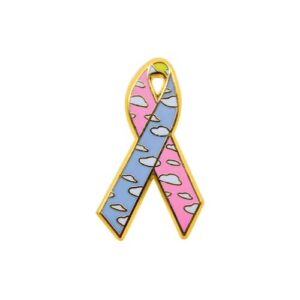

- Congenital Diaphragmatic Hernia: Congenital Diaphragmatic Hernia (CDH) is a condition present before birth characterized by abnormal development of the diaphragm. The severity of CDH may range from a thinned area in part of the diaphragm, to its complete absence. CDH may allow the stomach and intestines to move through an opening into the chest cavity, crowding the heart and lungs.
Copper Awareness Ribbons: Colors and causes symbolize, stand for and support:
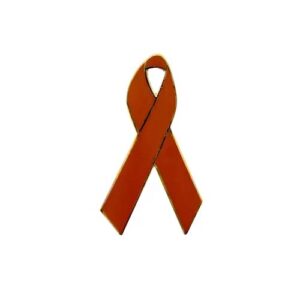



- Herpes Gestationis: Herpes Gestationis (HG), also known as Pemphigoid Gestationis, is a rare, autoimmune, bullous disease that occurs during the second or third trimester, but it has been reported in the first trimester. It flares at delivery and usually resolves spontaneously over weeks or months after delivery.
- Herpes, Neonatal: Congenital Herpes Simplex is a rare but potentially devastating viral infection that occurs in newborns and is transmitted from mother to baby during childbirth. Caused by the herpes simplex virus (HSV), primarily HSV-2, congenital herpes simplex can result in significant morbidity and mortality if not promptly diagnosed and treated.
- Menkes Syndrome: Menkes Disease or Menkes Syndrome is an inherited disorder in which the body has a problem absorbing copper. The disease affects both mental and physical development.
- Wilson Disease: Wilson disease, also known as Hepatolenticular Degeneration, is a rare genetic disorder that causes copper to build up in the body, especially in the liver, brain, and eyes. This buildup can damage the liver, brain, and other organs.
Cranberry Awareness Ribbons: Colors and causes symbolize, stand for and support:
Cream Awareness Ribbons: Colors and causes symbolize, stand for and support:
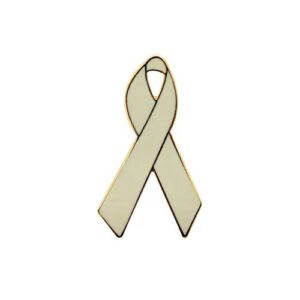


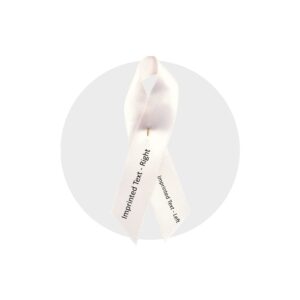


- Degenerative Disc Disease: Not actually a disease, Degenerative Disc Disease refers to a condition in which pain is caused from a disc that loses integrity. Several factors can cause discs to degenerate, including age.
- Developmental-Dysplasia of Hip: In babies and children with Developmental-Dysplasia of Hip, the hip joint has not formed normally. The ball is loose in the socket and may be easy to dislocate. Although Developmental-Dysplasia of Hip is most often present at birth, it may also develop during a child's first year of life.
- Dysplasia: Dysplasia is a term used to describe abnormal cell growth or development in an organ or tissue. It can be mild, moderate, or severe, depending on how abnormal the cells appear under a microscope and how much of the tissue is affected. Dysplasia is not cancer, but it can sometimes become cancerous. It can occur in any part of the body and can lead to a variety of conditions, including enlarged tissue or precancerous cells.
- Paralysis: Paralysis is the loss of muscle function in a part of the body. It happens when something goes wrong with the way messages pass between the brain and muscles. Paralysis can be complete or partial. It can occur on one or both sides of the body. It can also occur in just one area, or it can be widespread.
- Progressive Muscular Atrophy: Progressive Muscular Atrophy (PMA) is a rare type of motor neuron disease. Motor neuron diseases are a group of disorders characterized by progressive damage to the motor neurons. These are cells in the nervous system that allow speaking, breathing, and movement. PMA most commonly affects males and involves lower motor neuron damage. Lower motor neurons transmit signals between the spinal cord and muscles. Still, many with PMA later develop damage to upper motor neurons, which originate in the brain. Weakness in the arms and legs is a common symptom of PMA.
- Spinal Muscular Atrophy: Spinal Muscular Atrophy is a hereditary disease affecting the lower motor neurons. In Spinal Muscular Atrophy, insufficient levels of the SMN protein lead to degeneration of the lower motor neurons, producing weakness and wasting of the skeletal muscles. SMA in children is classified into three types, based on ages of onset, severity, and progression of symptoms.
- Spinal Muscular Atrophy Type I: Spinal Muscular Atrophy Type I (Werdnig-Hoffmann Disease) is evident by the time a child is 6 months old.
- Spinal Muscular Atrophy Type II: Spinal Muscular Atrophy Type II is the intermediate form, and usually begins between 6 and 18 months of age.
- Spinal Muscular Atrophy Type III: Spinal Muscular Trophy Type III (Kugelberg-Welander Disease) appears between 2 and 17 years of age.
Denim Blue Jeans Awareness Ribbons: Causes and colors symbolize, stand for and support:
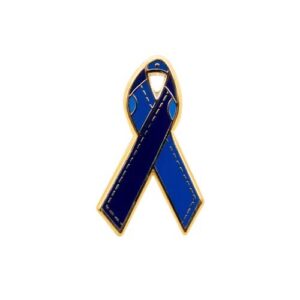

- Chromosomal Abnormalities: Chromosome abnormalities can be numerical or structural. A numerical abnormality mean an individual is either missing one of the chromosomes from a pair or has more than two chromosomes instead of a pair. A structural abnormality means the chromosome's structure has been altered in one of several ways.
- Congenital Diseases and Disorders: Congenital Diseases and Disorders or Congenital Anomalies are defined as structural or functional anomalies that occur during intrauterine life. Also called birth defects, congenital disorders, or congenital malformations, these conditions develop prenatally and may be identified before or at birth, or later in life.
- Genetic Diseases and Disorders: Genetic Diseases and Disorders are diseases or disorders caused in whole or part by a change in the DNA sequence away from the normal sequence. Genetic Disorders can be caused by a mutation in one gene, by mutations in multiple genes, by a combination of gene mutations and environmental factors, or by damage to chromosomes.
- Global Genes® - Rare and Genetic Diseases: Denim Blue Jeans Awareness Ribbon for Rare Diseases as Designated by Global Genes®.: Global Genes® is a leading rare disease patient advocacy organization with the mission to eliminate the challenges of rare diseases and disorders. Through their work, they build awareness, educate the global community, and provide critical connections and resources that equip advocates to become activists for their disease. Global Genes® promotes the needs of the rare disease community under a unifying symbol of hope – the Blue Denim Genes Ribbon™. Genes and jeans are a natural fit. Both are universal, come in pairs and are unique to the individual. The blue jeans ribbon is a simple concept that anyone can embrace and a powerful way to raise awareness for a rare disease or disorder.
- Our list of Rare Diseases and Disorders are a compilation by Orphanet and Global Genes® and appears in this link. Please search our database as we designate over 3,500 causes for which you can wear a denim blue jean ribbon.
Figure 8 Infinity Neurodiversity Awareness Ribbons: Colors and causes symbolize, stand for and support:

- Neurodiversity: Neurodivergent is a non-medical term that describes people whose brains develop or work differently for some reason. This means the person has different strengths and struggles from people whose brains develop or work more typically. While some people who are neurodivergent have medical conditions, it also happens to people where a medical condition or diagnosis has not been identified.
Fuchsia Awareness Ribbons: Colors and causes symbolize, stand for and support:
Gold Awareness Ribbons: Colors and causes symbolize, stand for and support:
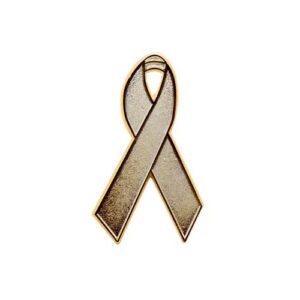

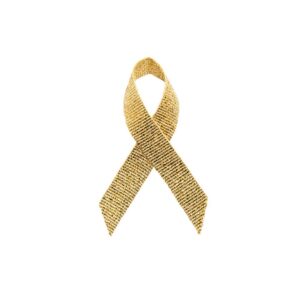



- Adolescent and Teen Cancer: Cancers in adolescents are often thought of as those that start between the ages of 15 and 19. Cancer is not common in teens, but a variety of cancer types can occur in this age group, and treating these cancers can be challenging for several reasons. The types of cancers that occur in adolescents (ages 15 to 19) are a mix of many of the types that can develop in children and adults. The types of cancers seen in adolescents are not unique to this age group, but the most common types are different from the most common types in young children or adults.
- Childhood (Pediatric) Cancer: Although pediatric cancer death rates have declined by nearly 70 percent over the past four decades, cancer remains the leading cause of death from disease among children. The types of cancers that develop in children are often different from the types that develop in adults. Childhood cancers are often the result of DNA (gene) changes in cells that take place very early in life, sometimes even before birth. Unlike many cancers in adults, childhood cancers are not strongly linked to lifestyle or environmental risk factors. The most common cancers in children are bone cancer (including both osteosarcoma and Ewing sarcoma), brain and spinal cord tumors, leukemia, lymphoma (including both Hodgkin and non-Hodgkin) neuroblastoma, retinoblastoma, rhabdomyosarcoma, and Wilms tumor. Pediatric Cancer is cancer that occurs in children between birth and age 14. It is different from adult cancers in how it grows, spreads, and responds to treatment.
- Rare Cancers of Childhood: Rare cancers in children make up fewer than 1 in 30 of all childhood cancers and can broadly be grouped as: rare cancers that only affect children, such as pancreatoblastoma, malignant rhabdoid tumors, pleuropulmonary blastomas and melanotic neuroectodermal tumors of infancy.
Graphite Awareness Ribbons: Colors and causes symbolize, stand for and support:
Gray Awareness Ribbons: Colors and causes symbolize, stand for and support:
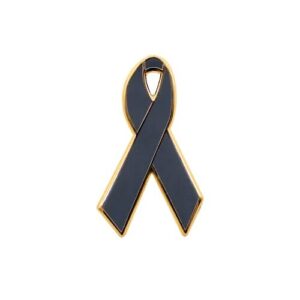



- Acoustic Neuroma: An acoustic neuroma, also known as a vestibular schwannoma, is a benign tumor that grows on the nerve that connects the ear to the brain. It is a slow-growing tumor that can cause hearing loss, dizziness, and balance problems.
- Anaplastic Astrocytoma: Anaplastic astrocytoma is a brain tumor that arises from brain cells called astrocytes, a type of glial cell. It is both a type of astrocytoma and high-grade glioma.
- Aphasia: Aphasia, a disturbance in the formulation and comprehension of language, is due to damage to brain tissue areas responsible for language. Aphasia may occur suddenly or develop over time, depending on the type and location of brain tissue damage. Causes of Aphasia are mainly due to strokes, severe head trauma, brain tumors, and brain infections.
- Asthma: Asthma is a chronic lung disease affecting people of all ages. It is caused by inflammation and muscle tightening around the airways, which makes it harder to breathe. Symptoms can include coughing, wheezing, shortness of breath and chest tightness. These symptoms can be mild or severe and can come and go over time.
- Astrocytomas, Adult: Astrocytomas are the most common brain tumors in adults, accounting for about 3.5% of all primary brain tumors. They originate from astrocytes, which are star-shaped cells that support nerve cells in the brain. Astrocytomas can affect anyone, but different grades tend to affect people at different ages: Grade 1 astrocytomas most often affect children and teens. Astrocytomas, grade 2 most often affect adults between 20 and 60. Astrocytomas, grade 3 most often affect adults between 30 and 60.
- Astrocytomas, Childhood: Astrocytomas are tumors that start in star-shaped brain cells called astrocytes. Astrocytoma is the most common type of glioma diagnosed in children. It can form anywhere in the central nervous system (brain and spinal cord). Brain and spinal cord tumors can be benign or malignant. The alternate color for Astrocytomas in children is gold.
- Atypical Teratoid / Rhabdoid Tumors, Adult: Atypical Teratoid/Rhabdoid Tumor is predominantly a childhood tumor and has only been rarely reported in adults. Therefore, treatment regimens are often extrapolated from the pediatric experience.
- Atypical Teratoid/Rhabdoid Tumor, Childhood: Brain and spinal cord tumors can be benign or malignant. Central Nervous System (CNS) Atypical Teratoid/Rhabdoid Tumor is a very rare, fast-growing tumor of the brain and spinal cord. It usually occurs in children aged three years and younger, although it can occur in older children and adults. The alternate color for Atypical Teratoid/Rhabdoid Tumor in children is gold.
- Borderline Personality Disorder: Borderline Personality Disorder is a mental illness that severely impacts a person’s ability to manage their emotions. This loss of emotional control can increase impulsivity, affect how a person feels about themselves, and negatively impact their relationships with others. People with Borderline Personality Disorder may experience intense mood swings and feel uncertainty about how they see themselves. Their feelings for others can change quickly, and swing from extreme closeness to extreme dislike. These changing feelings can lead to unstable relationships and emotional pain. The alternate color for Borderline Personality Disorder is black and white.
- Brain Cancer, Adult: Brain cancer is a life-threatening disease that can occur when abnormal cells form a mass in the brain and invade or destroy healthy brain tissue. Brain cancer can be caused by tumors that originate in the brain or spread to the brain from other parts of the body. These include primary brain tumors or metastatic brain tumors. Brain tumors can be benign (noncancerous) or malignant (cancerous). Benign tumors are slow-growing and unlikely to spread, while malignant tumors grow quickly and invade other parts of the brain.
- Brain Cancer, Childhood: Brain cancer can arise from many different types of brain cells or occur when cancer cells from another part of the body spread (metastasize) to the brain. The alternate color for Brain Cancer in children is gold.
- Brain Stem Glioma, Adult: Brainstem gliomas (BSGs) in adults are rare brain tumors that account for 1-2% of all inter-cranial gliomas. They are a heterogeneous group of tumors that can differ from those in children. Brain Stem Gliomas in adults are often associated with a better prognosis than in children and may have a less aggressive clinical course.
- Brain Stem Glioma, Childhood: Gliomas are tumors formed from glial cells. Glial cells in the brain hold nerve cells in place, bring food and oxygen to them, and help protect them from disease. The brain stem is the part of the brain that controls breathing, heart rate, and the nerves and muscles used in seeing, hearing, walking, talking, and eating. The alternate color for Childhood Brain Stem Glioma is gold.
- Brain Tumors, Adult: Primary brain tumors can be either malignant (contain cancer cells) or benign (do not contain cancer cells). A primary brain tumor is a tumor which begins in the brain tissue. If a cancerous tumor starts elsewhere in the body, it can spread cancer cells, which grow in the brain. These types of tumors are called secondary or metastatic brain tumors.
- Brain Tumors, Childhood: A brain rumor occurs when there is a genetic alteration in the normal cells in the brain. The alteration causes the cells to undergo a series of changes that result in a growing mass of abnormal cells. Primary Brain Tumors involve a growth that starts in the brain, rather than spreading to the brain from another part of the body. The alternate color for Brain Tumors in children is gold.
- Central Nervous System Germ Cell Tumors, Adult: Central nervous system (CNS) germ cell tumors (GCTs) are a rare type of cancer that can affect adults, but they primarily affect children and young adults.
- Central Nervous System Germ Cell Tumors, Childhood: Germ cells are a type of cell that form as a fetus develops. These cells later become sperm in the testicles or eggs in the ovaries. Sometimes while the fetus is forming, germ cells travel to other parts of the body and grow into Germ Cell Tumors. The alternate color for Central Nervous System Germ Cell Tumors in children is gold.
- Central Nervous System Tumors and Cancer, Adult: Unlike cancers that start in other parts of the body, tumors that start in the brain or spinal cord rarely spread to distant organs. Even so, brain or spinal cord tumors are rarely considered benign (non-cancerous). These tumors can still cause damage by growing and spreading into nearby areas, where they can destroy normal brain tissue. And unless they are completely removed or destroyed, most brain or spinal cord tumors will continue to grow and eventually be life-threatening.
- Central Nervous System Tumors and Cancer, Childhood: Central Nervous System (CNS) tumors begin when healthy cells in the brain or the spinal cord change and grow out of control, forming a mass. A tumor can be cancerous or benign. A cancerous tumor is malignant, meaning it can grow and spread to other parts of the body. A benign tumor means the tumor can grow but will not spread. The alternate color for Central Nervous System Tumors and Cancer in children is gold.
- Craniopharyngioma, Adult: Craniopharyngiomas are slow growing benign tumors of the sellar and parasellar region with an overall incidence rate of approximately 1.3 per million. During adulthood there is a peak incidence between 40 and 44 years.
- Craniopharyngioma, Childhood: Childhood Craniopharyngiomas are rare tumors usually found near the pituitary gland and the hypothalamus. The alternate color for Craniopharyngioma in children is gold.
- Embryonal Tumors, Central Nervous System, Adult: Embryonal tumors are malignant, small-cell tumors that occur in the central nervous system (CNS) of adults, but are more common in babies and young children
- Embryonal Tumors, Central Nervous System, Childhood: Central Nervous System (CNS) Embryonal Tumors form in embryonic cells that remain in the brain after birth. CNS Embryonal Tumors tend to spread through the cerebrospinal fluid (CSF) to other parts of the brain and spinal cord. The tumors may be malignant (cancer) or benign (no cancer). The alternate color for Embryonal Tumors, Central Nervous System in children, is gold.
- Ependymoma, Adult: Ependymomas in adults are rare, accounting for only 3% of all primary central nervous system tumors diagnosed each year in the United States. Although Ependymomas may arise in various regions throughout the central nervous system, the frequency of location varies by age. Spinal Cord Ependymomas are most prevalent in adults, whereas this location is quite rare in the pediatric population.
- Ependymoma, Childhood: Ependymoma is a tumor that appears most often in the brain and sometimes in the spinal cord. It is a type of glioma, meaning it starts in the support cells of the brain. This cancer occurs more frequently in children, accounting for 5-10% of all pediatric brain tumors, but it can also affect adults. The alternate color for Childhood Ependymoma is gold.
- Glioblastoma: Glioblastoma is a malignant (cancerous) brain tumor that develops from a specific type of brain cell called an astrocyte. These cells help support and nourish neurons (nerve cells of the brain) and form scar tissue that helps repair brain damage in response to injury. Glioblastomas are often very aggressive and grow into surrounding brain tissue.
- Hypoglycemia: Hypoglycemia is the medical term for low blood sugar. It typically occurs as a side effect of medications for diabetes. The normal range of blood glucose is from 70 to 100 mg/dL in an individual without diabetes. Most people will feel the effects and symptoms of low blood sugar when blood glucose levels are lower than 50 mg/dL. Symptoms and signs include nervousness, dizziness, trembling, sweating, hunger, weakness, and palpitations. The alternate color for Hypoglycemia is the blood drop pin.
- Medulloblastoma, Adult: Medulloblastoma is a rare brain tumor in adults, accounting for less than 1% of all adult brain tumors.
- Medulloblastoma, Childhood: Medulloblastoma is a rare but common malignant brain tumor. in children that occurs in the cerebellum, the part of the brain that controls balance and coordination. The alternate color for Medulloblastoma in children is gold.
- Personality Disorders: Personality disorders are a group of mental illnesses. They involve long-term patterns of thoughts and behaviors that are unhealthy and inflexible. The behaviors cause serious problems with relationships and work. People with personality disorders have trouble dealing with everyday stresses and problems. They often have stormy relationships with other people.
- Rhabdoid Tumors, Adult: Rhabdoid tumors in adults are rare and can be malignant or atypical teratoid/rhabdoid. A malignant rhabdoid tumor is a rare tumor that grows quickly and spreads to other parts of the body. MRTs are most common in babies but can also occur in adults. MRTs of the kidney in adults have a poor prognosis.
- Rhabdoid Tumors, Childhood: Rhabdoid tumors are rare, aggressive, and fast-growing cancers that can occur in children. Atypical teratoid/rhabdoid tumor (AT/RT) tumors start in the brain and spinal cord and is also known as a central nervous system (CNS) rhabdoid tumor. It usually occurs in children under 3 years old but can occur in older children and adults. Malignant rhabdoid tumors (MRT) commonly start in the kidneys but can also occur in other soft tissues. It occurs most often in infants and toddlers, with an average age of diagnosis of 15 months. The alternate color for Rhabdoid Tumors in children is gold.
Green Awareness Ribbons: Colors and causes symbolize. stand for and support:
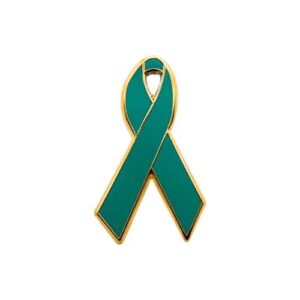

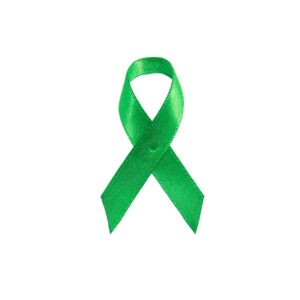
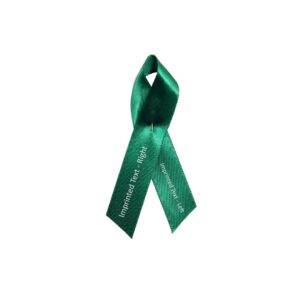


- Achondroplasia: Achondroplasia is a disorder of bone growth that prevents the changing of cartilage to bone.
- Adrenal Cancer: Adrenal cancer is a condition that occurs when abnormal cells form in or travel to the adrenal glands. A cancerous tumor of the adrenal gland is called an Adrenal Cortical Carcinoma. A noncancerous tumor of the adrenal gland is called a benign adenoma.
- Adrenocortical Carcinoma, Adult: Adrenocortical Carcinoma is a rare tumor. Although it mainly occurs in adults, children can be affected, too. Historically, only about 30% of these malignancies are confined to the adrenal gland at the time of diagnosis. However, recently, more have been diagnosed at early stages, most likely due to the widespread use of high-quality imaging techniques.
- Adrenocortical Carcinoma, Childhood: An Adrenocortical tumor is a cancer of the adrenal glands, which are triangle-shaped glands located on both kidneys. These glands produce many chemicals, called hormones. The alternate color for Adrenocortical carcinoma in children is gold.
- Adult Stem Cell Donor: Healthy adults ages 18 to 60 can donate stem cells. Children may be donors for themselves or a brother or sister. In some cases, people who are older than 60 can donate. If you wish to be a stem cell donor, a blood sample is taken and tested for tissue type. The alternate color for Adult Stem Cell Donor is lime green and aqua.
- Anencephaly: Anencephaly is a type of neural tube defect characterized by abnormal development of the brain and the bones of the skull. Anencephaly occurs when the 'cephalic' or head end of the neural tube fails to close, causing the absence of a major portion of the brain, skull, and scalp. Infants with this disorder are born without a forebrain (the front part of the brain) and a cerebrum (the thinking and coordinating part of the brain). The remaining brain tissue is often exposed (not covered by bone or skin).
- Alport Syndrome: Alport syndrome is a genetic condition characterized by kidney disease, hearing loss, and eye abnormalities. People with Alport syndrome experience progressive loss of kidney function. The kidneys gradually lose their ability to efficiently remove waste products from the body, resulting in end-stage kidney disease (ESKD).
- Anti GBM / Anti TBM Nephritis: Anti-GBM/Anti-TBM Nephritis is a rare autoimmune disorder caused by autoantibodies that attack the walls of small blood vessels (capillaries) in the kidney. Anti-GBM Disease that only affects the kidneys is called Anti-GBM Glomerulonephritis.
- Autoimmune Gastrointestinal Dysmotility: Autoimmune Gastrointestinal Dysmotility is a limited form of dysautonomia that affects digestive tract motility. Although rare, the condition can be debilitating, with individuals experiencing nausea and dramatic weight loss.
- Beckwith-Wiedemann Syndrome: Beckwith-Wiedemann Syndrome is a growth disorder that can affect several parts of the body. Babies and children are larger than normal usually until age 8, when growth slows down, resulting in an average height in adults. The alternate color for Beckwith-Wiedmemann Syndrome is yellow.
- Bile Duct Cancer: Cancer of the bile duct (also called Cholangiocarcinoma) is extremely rare. The true incidence of bile duct cancer is unknown because establishing an accurate diagnosis is difficult.
- Biliary Atresia: Biliary Atresia is a rare, progressive obliterative cholangiopathy of the extrahepatic bile ducts, occurring in the embryonic / perinatal period. This leads to severe and persistent jaundice with an unfavorable course in the absence of treatment.
- Bipolar Disorder: Bipolar Disorder, also called Bipolar I Disorder and previously called Manic Depression, is a condition that involves mood swings with at least one episode of mania and may also include repeated episodes of depression. Bipolar Disorder afflicts up to 4 million people in the United States and is the fifth leading cause of disability worldwide. The alternate color for Bipolar Disorder is lime green.
- Bone Marrow Disease: Bone Marrow Disease causes problems with the stem cells or how they develop. For example, in leukemia, a cancer of the blood, the bone marrow makes abnormal white blood cells. In Aplastic Anemia, the bone marrow doesn't make red blood cells. In Myeloproliferative Disorders, the bone marrow makes too many white blood cells. The alternate color for Bone Marrow Disease is black and red.
- Bone Marrow Donation: To become a donor, it just takes a small vial of blood or cheek swab to be typed as a bone marrow or stem cell donor. There are many people who are desperately waiting to find a donor match. You may be able to save someone’s life. There are donor registry sites throughout the country.
- Bone Marrow Donor: Bone marrow donation, or bone marrow harvesting, is the procedure healthcare providers use to obtain blood-forming cells (stem cells) for bone marrow transplant. Donating bone marrow does not hurt and may cure someone who has blood cancer or a blood disorder. Anyone can volunteer to donate bone marrow, but all donors must meet certain health requirements.
- Bone Marrow Failure: Bone marrow failure develops when the bone marrow is unable to produce enough healthy blood cells for an individual's needs. The bone marrow is the soft, spongy center of the bones that is the body's factory where all blood cells are produced. The alternate color for Bone Marrow Failure is red and white pinstripes.
- Cerebral Palsy: Cerebral Palsy refers to a group of neurological disorders that can affect the brain and/or spinal cord.
- Cholangiocarcinoma: Cholangiocarcinoma is bile duct cancer. Liver cancer includes hepatocellular carcinoma and bile duct cancer (cholangiocarcinoma). Risk factors include chronic infection with Hepatitis B or C and cirrhosis of the liver.
- Chemical Sensitivity: While certain chemicals are known to cause toxicity or adverse reactions including allergies, some people have sensitivities to a wide spectrum of environmental agents. These people have been dubbed to have Multiple Chemical Sensitivities or Idiopathic Environmental Intolerance.
- Chronic Traumatic Encephalopathy (CTE): Chronic Traumatic Encephalopathy (CTE) is a degenerative brain disease found in athletes, military veterans, and others with a history of repetitive brain trauma. In CTE, a protein called Tau forms clumps that slowly spread throughout the brain, killing brain cells. CTE has been seen in people as young as 17, but symptoms do not generally begin appearing until years after the onset of head impacts.
- Cirrhosis of the Liver: Cirrhosis is a serious degenerative disease that occurs when healthy cells in the liver are damaged and replaced by scar tissue, usually because of alcohol abuse or chronic hepatitis. As liver cells give way to tough scar tissue, the organ loses its ability to function properly.
- Climate Change: Climate change refers to long-term shifts in temperatures and weather patterns. These shifts may be natural, but since the 1800s, human activities have been the main driver of climate change, primarily due to the burning of fossil fuels (like coal, oil, and gas) which produces heat-trapping gases.
- CLOVES Syndrome: CLOVES Syndrome is a rare condition that is primarily characterized by congenital overgrowth of fatty tissue, malformations of the vascular system, epidermal nevi, and spinal or skeletal abnormalities. The severity of the condition and the associated signs and symptoms vary significantly from person to person.
- Colorado Tick Fever: Colorado tick fever is a rare viral disease spread by the bite of an infected Rocky Mountain wood tick.
- Congenital Muscular Dystrophy: Congenital muscular dystrophy is one of the variants of muscle weakness disorders presenting early in life during infancy and soon after birth. The difference between congenital myopathies and muscular dystrophies is that dystrophies are gradually progressive and are associated with increased muscle breakdown with age. The alternate color for Congenital Muscular Dystrophy is lime green.
- Cystinosis: Cystinosis is a rare, multi-system genetic disorder characterized by the accumulation of an amino acid called cystine in different tissues and organs of the body including the kidneys, eyes, muscles, liver, pancreas and brain.
- Cystinuria: Cystinuria is a rare condition in which stones made from an amino acid called cysteine form in the kidney, ureter, or bladder. Cystine is formed when two molecules of an amino acid called cysteine are bound together. The condition is passed down through families.
- Devic's Disease: Neuromyelitis optica (NMO) is a central nervous system disorder that causes inflammation in nerves of the eye and the spinal cord. NMO is also called neuromyelitis optica spectrum disorder (NMOSD) and Devic's disease. It occurs when the body's immune system reacts against its own cells.
- Dwarfism: Dwarfism is a condition that is characterized by short stature, usually resulting in an adult height of 4'10" or shorter. Dwarfism can and most often does occur in families where both parents are of average height.
- Environmental Protection: Environmental protection is the practice of protecting the natural environment by individuals, organizations and governments. Its objectives are to conserve natural resources and the existing natural environment and, where possible, to repair damage and reverse trends.
- Essential Tremor: Essential tremor is a condition that affects the nervous system, causing involuntary and rhythmic shaking or trembling. This shaking is often most obvious in the hands and forearms, but essential tremor can also affect the head, voice, face, and rarely the legs. This movement disorder is not life-threatening.
- Eye Injury Prevention: The eye protection chosen for specific work situations depends upon the nature and extent of the hazard, the circumstances of exposure, other protective equipment used, and personal vision needs. The alternate color for Eye Injury Prevention is red.
- Fibrodysplasia Ossificans Progressiva: Fibrodysplasia Ossificans Progressiva is a disorder in which skeletal muscle and connective tissue, such as tendons and ligaments, are gradually replaced by bone (ossified). This condition leads to bone formation outside the skeleton that restricts movement.
- Gallbladder Cancer: Gallbladder cancer is a rare disease in which cancer cells form in the tissues of the gallbladder.
- Gastroparesis: Gastroparesis means weakness of the muscles of the stomach. Gastroparesis results in poor grinding of food in the stomach into small particles and slows emptying of food from the stomach into the small intestine.
- Gastroschisis: Gastroschisis is a birth defect that occurs when a baby's intestines extend outside of the body through a hole next to the belly button. This type of defect is known as an abdominal wall defect. Sometimes other organs are also involved.
- Glaucoma: Glaucoma is an eye disease that is often associated with elevated intraocular pressure, in which damage to the optic nerve can lead to loss of vision and even blindness. Glaucoma is the leading cause of irreversible blindness in the world.
- Glomerulonephritis: Glomerulonephritis is inflammation of the tiny filters in the kidneys (glomeruli). The excess fluid and waste that glomeruli remove from the bloodstream exit the body as urine. Glomerulonephritis can come on suddenly (acute) or gradually (chronic).
- Glycogen Storage Disease: Glycogen storage diseases are a group of rare inherited conditions that can cause frequent low blood sugar, muscle weakness and liver damage. There are several different types based on which enzyme is missing, and each one affects a person differently. Most types are manageable with treatment.
- Hepatoblastoma: Adult: Hepatoblastoma is a rare and aggressive liver cancer that can occur in adults, but it's more common in children under two years old.
- Hepatoblastoma: Childhood: Hepatoblastoma is a very rare cancer. It is a tumor that starts in the liver. It usually affects children less than 3 to 4 years of age. It usually doesn’t spread (metastasize) to other areas of the body. The alternate color for Hepatoblastoma in children is gold.
- Hepatocellular Carcinoma: Liver cancer includes Hepatocellular Carcinoma and Bile Duct Cancer (Cholangiocarcinoma). Risk factors for Hepatocellular Carcinoma include chronic infection with Hepatitis B or C and Cirrhosis of the Liver.
- Human Rights: Human rights are fundamental rights that all people have, regardless of their race, nationality, religion, or any other status. They include the right to life, freedom from torture, freedom of speech, and the right to education.
- Ivemark Syndrome: Ivemark Syndrome is a rare congenital condition that affects multiple organ systems of the body. Ivemark Syndrome is characterized by the absence or underdevelopment of the spleen, heart malformations, and the abnormal arrangement of the internal organs of the chest and abdomen. The alternate color for Ivemark Syndrome is light green.
- Joubert Syndrome: Joubert syndrome is a rare genetic condition characterized by abnormal brain development that includes the absence or underdevelopment of the cerebellar vermis (an area of the brain that controls balance and coordination) and a malformed brain stem.
- Kabuki Syndrome: Kabuki Syndrome is a rare disorder that affects multiple parts of the body. It is present from birth. Features often include a characteristic facial appearance, skeletal abnormalities, short stature, heart defects, and intellectual disability.
- Kidney Disease: Most people who get liver cancer get it in the setting of chronic liver disease. Incidence rates of hepatocellular cancer are rising in the United States due to increasing prevalence of cirrhosis caused by chronic Hepatitis C and nonalcoholic fatty liver disease. Chronic kidney disease, also called chronic kidney failure, describes the gradual loss of kidney function.
- Literacy: Beyond its conventional concept as a set of reading, writing and counting skills, literacy is now understood as a means of identification, understanding, interpretation, creation, and communication in an increasingly digital, text-mediated, information-rich and fast-changing world.
- Liver Cancer, Adult: Primary liver cancer starts in the liver. Metastatic liver cancer starts somewhere else and spreads to the liver.
- Liver Cancer, Childhood: Childhood liver cancer is a disease in which cancer cells form in the tissues of the liver. Liver cancer is rare in children and adolescents. There are two main types of childhood liver cancer. The first is Hepatoblastoma. This is a type of liver cancer that usually does not spread outside the liver. This type usually affects children younger than 3 years old. The second is Hepatocellular Carcinoma. This type of liver cancer often spreads to other places in the body. This type usually affects children older than 14 years old. The alternate color for childhood liver cancer is gold.
- Liver Disease: Liver disease is any disturbance of liver function that causes illness. Liver disease is also referred to as hepatic disease. Liver disease is a broad term that covers all the potential problems that cause the liver to fail to perform its designated functions. Usually, more than 75% or three quarters of liver tissue needs to be affected before a decrease in function occurs.
- Liver Melanoma (Metastatic Melanoma): The most dangerous aspect of melanoma is its ability, in later stages, to spread to other parts of the body. The term metastatic melanoma, or Stage IV melanoma, is used when melanoma cells of any kind have spread through the lymph nodes to distant sites.
- Major Depressive Disorder: Major Depressive Disorder, also referred to as clinical depression, is a significant medical condition that can affect many areas of one's life. It impacts mood and behavior as well as various physical functions. Major Depressive Disorder is one of the most common mental disorders in the United States. In 2015, nearly 7% of Americans over age 18 had an episode of MDD.
- Medical Marijuana Advocate: The term medical marijuana refers to using the whole, unprocessed marijuana plant or its basic extracts to treat symptoms of illness and other conditions. The U.S. Food and Drug Administration (FDA) has not recognized or approved the marijuana plant as medicine. However, scientific study of the chemicals in marijuana, called cannabinoids, has led to two FDA-approved medications that contain cannabinoid chemicals in pill form. Continued research may lead to more medications. Because the marijuana plant contains chemicals that may help treat a range of illnesses and symptoms, many people argue that it should be legal for medical purposes. In fact, a growing number of states have legalized marijuana for medical use.
- Medullary Sponge Kidney: Medullary sponge kidney (MSK) is a congenital disorder, meaning it is present at birth. MSK occurs when small cysts (sacs) form either on tiny tubes within the kidney (known as tubules) or the collecting ducts (a channel where urine is collected for removal).
- Missing Children: The missing children issue is complex and multifaceted. Children may become missing due to abduction by non-family members or abduction by family members. Children may become missing because of running away from home. Children may also become missing involuntarily for reasons other than abduction such as becoming lost, injured or under other circumstances. Here are two important websites: Website: https://www.amberalert.gov/ and Website: https://twitter.com/AMBERAlert. Or, call 1-800-THE-LOST or 1-800-843-5678. This service is available 24/7, 365. The alternate color for Missing Children is yellow.
- Mitochondrial Diseases / Mitochondrial Disorders (Dysfunction): Mitochondrial diseases are chronic, genetic, often inherited disorders that occur when mitochondria fail to produce enough energy for the body to function properly. Mitochondrial diseases can be present at birth but can also occur at any age. Mitochondrial diseases can affect almost any part of the body, including the cells of the brain, nerves, muscles, kidneys, heart, liver, eyes, ears or pancreas. Mitochondrial dysfunction occurs when the mitochondria do not work as well as they should due to another disease or condition.
- Natural Disasters: A natural disaster is a major adverse event resulting from natural processes of the Earth. Examples include floods, hurricanes, tornadoes, volcanic eruptions, earthquakes, tsunamis, and other geologic processes. A natural disaster can cause loss of life or property damage, and typically leaves some economic damage in its wake. The severity of the situation depends on the affected population's resilience, ability to recover, and the infrastructure available.
- Nephrotic Syndrome: Nephrotic Syndrome is a kidney disorder that causes the body to excrete too much protein in the urine. Nephrotic syndrome is usually caused by damage to the clusters of small blood vessels in the kidneys that filter waste and excess water from the blood. Nephrotic syndrome causes swelling, particularly in the feet and ankles, and increases the risk of other health problems. The alternate color for Nephrotic Syndrome is lime green.
- Neuromyelitis Optica: Neuromyelitis optica (NMO) is a rare autoimmune disease that affects the central nervous system. It's also called neuromyelitis optica spectrum disorder (NMOSD) or Devic's disease. NMO specifically affects the myelin, which is the insulation around the nerves. NMO mainly affects the spinal cord and the optic nerves, which are the nerves that carry signals from the eyes to the brain. As a result, the disease can cause paralysis and blindness.
- Neural Tube Defects: Neural Tube Defects occur when the neural tube does not close properly. The neural tube forms the early brain and spine. These types of birth defects develop very early during pregnancy, often before a woman knows she is pregnant. The two most common Neural Tube Defects are Spina Bifida (a spinal cord defect) and Anencephaly (a brain defect).
- Neuromyelitis Optica Spectrum Disorder / Devic's Disease: Neuromyelitis Optica, also known as Devic's disease, is a rare condition in which the immune system damages the spinal cord and the nerves of the eyes (optic nerves). Neuromyelitis Optica can affect anyone at any age, but it is more common in women than men.
- Organ Donation / Organ Donor: A national computer system and strict standards are in place to ensure ethical and fair distribution of organs. Organs are matched by blood and tissue typing, organ size, medical urgency, waiting time and geographic location. Organs and tissue that can be donated include heart, kidneys, lungs, pancreas, liver, intestines, corneas, skin, tendons, bone, nerve and heart valves.
- Organ Transplant Recipient: Organ donation is the process of surgically removing an organ or tissue from one person (the organ donor) and placing it into another person (the recipient). Transplantation is necessary because the recipient's organ has failed or has been damaged by disease or injury.
- Pediatric Acute-Onset Neuropsychiatric Syndrome / PANS: Pediatric Acute-onset Neuropsychiatric Syndrome (PANS) is a clinical diagnosis given to children who have a dramatic – sometimes overnight – onset of neuropsychiatric symptoms including obsessions/compulsions or food restriction. They are often diagnosed with obsessive-compulsive disorder (OCD) or an eating disorder, but the sudden onset of symptoms separates PANS from these other disorders. In addition, they may have symptoms of depression, irritability, anxiety, and difficulty with schoolwork. The cause of PANS is unknown in most cases but is thought to be triggered by infections, metabolic disturbances, and other inflammatory reactions.
- Pediatric Autoimmune Neuropsychiatric Disorder Associated with Streptococcus / PANDAS: PANDAS is short for Pediatric Autoimmune Neuropsychiatric Disorders Associated with Streptococcal Infections. A child may be diagnosed with PANDAS when obsessive-compulsive disorder (OCD), tic disorder, or both suddenly appear following a streptococcal (strep) infection, such as strep throat or scarlet fever. In addition, the symptoms of OCD or tic symptoms suddenly become worse following a strep infection.
- Phelan-McDermid Syndrome: Phelan-McDermid syndrome is a rare genetic disorder that can affect many critical functions in a person’s body, from learning and communicating to eating and sleeping.
- Pheochromocytoma, Adult: Pheochromocytoma is a rare tumor that can be non-cancerous or malignant. Pheochromocytomas form in the adrenal glands. Pheochromocytoma is a rare tumor that forms in the center of the adrenal gland. Usually pheochromocytoma affects one adrenal gland, but it may affect both adrenal glands. Sometimes there is more than one tumor in one adrenal gland. The alternate color for Pheochromocytoma is zebra.
- Pheochromocytoma, Childhood: Pheochromocytoma is a rare tumor. Pheochromocytoma forms in the adrenal glands. Some pheochromocytomas release extra adrenaline and noradrenaline into the blood and cause symptoms. The alternate color for Pheochromocytoma in children is gold or zebra.
- PMM2-CDG: PMM2-CDG, formerly known as congenital disorder of glycosylation type 1a, is a rare multisystem disorder that involves a normal, but complex, chemical process known as glycosylation. Glycosylation is the process by which sugar chains (glycans) are created, altered and chemically attached to certain proteins or fats (lipids).
- Polycystic Liver Disease: Polycystic liver disease (PLD or PCLD) is a rare condition that causes cysts, which are fluid-filled sacs, to grow throughout the liver. A normal liver has a smooth, uniform appearance. A polycystic liver can look like a cluster of very large grapes. Cysts also can grow independently in different parts of the liver. The cysts, if they get too numerous or large, may cause discomfort and health complications. Most people with polycystic liver disease do not have symptoms and live a normal life.
- Primary Biliary Cholangitis / Primary Biliary Cirrhosis: Bile is a substance produced by the liver to facilitate digestion. In Primary Biliary Cirrhosis, the bile ducts develop inflammation and eventually collapse. This causes liver damage and may eventually lead to cirrhosis.
- Primary Central Nervous System (CNS) Lymphoma: Primary Central Nervous System (CNS) Lymphoma is a disease in which malignant cells form in the lymph tissue of the brain and/or spinal cord. Primary CNS Lymphoma can start in the brain, spinal cord, or meninges (the layers that form the outer covering of the brain). Because the eye is so close to the brain, Primary CNS Lymphoma can also start in the eye (called Ocular Lymphoma).
- Primary Sclerosing Cholangitis: Primary Sclerosing Cholangitis is a chronic liver disease in which the bile ducts inside and outside the liver become inflamed and scarred, and eventually narrowed or blocked. When this happens, bile builds up in the liver and causes further liver damage.
- Recycling: Recycling is the process of converting waste materials into new materials and objects. The recovery of energy from waste materials is often included in this concept. The recyclability of a material depends on its ability to reacquire the properties it had in its original state.
- Renal (Kidney) Disease: Kidney disease can affect the body’s ability to clean the blood, filter extra water out of the blood, and help control blood pressure. It can also affect red blood cell production and vitamin D metabolism needed for bone health.
- Renal Glycosuria: Renal (kidney) glycosuria is a rare condition in which too much of the simple sugar glucose is removed through the urine. This happens even though there are normal or low levels of glucose in the blood. When the kidney is working correctly, glucose is only removed into the urine when there is too much in the blood.
- Reproductive Rights: Reproductive rights are about the legal right to contraception, abortion, fertility treatment, reproductive health, and access to information about one's reproductive body. Reproductive rights secure people's freedom to decide about their body's capacities to (not) reproduce. Reproductive rights may include some or all of the following: right to abortion; birth control; freedom from coerced sterilization and contraception; the right to access good-quality reproductive healthcare; and the right to education and access in order to make free and informed reproductive choices.
- Sandhoff Disease: Sandhoff disease is a rare genetic condition that usually appears in infants. Lack of an enzyme called beta-hexosaminidase causes toxic levels of fat in the brain and spinal cord nerve cells. Sandhoff disease causes problems in muscles, organs and development, usually leading to death in early childhood.
- Scoliosis: Scoliosis is an abnormal curve in the spine. There are several types of scoliosis based on the cause and age when the curve develops. Most people have no known cause. The most common symptom of scoliosis is curvature of the spine. Scoliosis risk factors include age (9- to 15-year-olds), female sex, and family history.
- Skin Picking Disorder: Dermatillomania is a mental health condition where a person compulsively picks or scratches their skin, causing injuries or scarring. Also known as excoriation disorder or skin-picking disorder, this condition falls under the category of obsessive-compulsive disorders (OCDs).
- Sports-Related Chronic Traumatic Encephalopathy: CTE is most associated with professional athletes in contact sports, such as football, boxing, and ice hockey. However, anyone who has had repeated head injuries is at risk, including military members who have experienced blast injuries.The symptoms of CTE include memory loss, confusion, impaired judgment, impulse control problems, aggression, depression, anxiety, suicidality, Parkinsonism, and, eventually, progressive dementia. These symptoms often begin years or even decades after the last brain trauma or end of active athletic involvement.
- Stem Cell Donation: Individudals who want to donate stem cells or join a volunteer registry can speak with a health care provider or contact the National Marrow Donor Program to find the nearest donor center. Potential donors are asked questions to make sure they are healthy enough to donate and don’t pose a risk of infection to the recipient. For more information about donor eligibility guidelines, contact Be the Match or the donor center in your area. Be the Match (formerly the National Marrow Donor Program)
Toll-free number: 1-800-MARROW or (1-800-627-7692)
Website: www.bethematch.org
- Stop Pollution: A cleaner environment can reduce the adverse health impacts to local populations from illnesses, diseases, and cancer risk associated with pollution exposure. U.S. EPA considers pollution prevention to be an equivalent form of disease prevention.
- Tissue Donation: Tissue donation is a common lifesaving option for people who wish to be donors, as there are very few medical reasons a person would not be eligible to donate tissue. Corneas or whole eyes, bone, skin, tendons, ligaments, heart valves and other cardiovascular tissues can be transplanted. Great care is taken in the recovery of tissues to ensure presentation of the body for funeral purposes. Generally, donation will not delay funeral arrangements, and tissue donation does not interfere with an open-casket funeral for the donor.
- Traumatic Brain Injury / TBI: Traumatic Brain Injury (TBI) happens when a bump, blow, jolt, or other head injury causes damage to the brain. Every year, millions of people in the U.S. suffer brain injuries. More than half are bad enough that people must go to the hospital. The worst injuries can lead to permanent brain damage or death. Half of all TBIs are from motor vehicle accidents. Military personnel in combat zones are also at risk.
- Von Hippel-Lindau Syndrome (VHL): Von Hippel-Lindau Syndrome is an inherited disorder characterized by the abnormal growth of both benign and cancerous tumors and cysts in many parts of the body. Tumors usually first appear in young adulthood.
Hot Pink Awareness Ribbons: Colors and causes symbolize, stand for and support:
Kente Cloth Awareness Ribbons: Colors and causes symbolize, stand for and support:
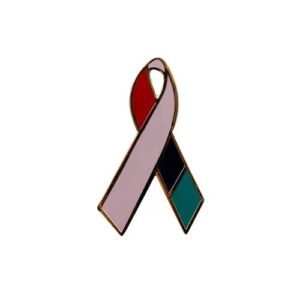

- Women of Color Breast Cancer / WOC Breast Cancer: Although the mortality rates have declined in some ethnic populations, the overall cancer incidence among African American and Hispanic populations has continued to grow. Racial disparities in breast cancer mortality among African American women is an issue that has been well documented over the past 40 years. While early studies largely attributed poor survival in this group to low socioeconomic status, cumulative evidence suggests that ethnic disparities in breast cancer survival are influenced by multiple factors existing along a continuum. The continuum ranges from breast cancer prevention to post-treatment surveillance. African American women’s mortality rates are 41% higher than their Caucasian counterparts. African American women are often diagnosed at later stages, sometimes with more aggressive forms of cancer and at younger ages. This trend is the result of compounding social, cultural, financial and geographic barriers. The alternate color for Women of Color Breast Cancer is pink.
Lavender Awareness Ribbons: Colors and causes symbolize, stand for and support:
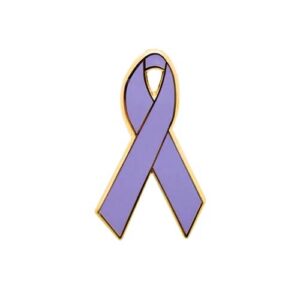





- Cancer / All types (in general and those that do not have a designated color): A term for diseases in which abnormal cells divide without control and can invade nearby tissues. Cancer cells can also spread to other parts of the body through the blood and lymph systems. There are several main types of cancer. Carcinoma is a cancer that begins in the skin or in tissues that line or cover internal organs. Sarcoma is a cancer that begins in bone, cartilage, fat, muscle, blood vessels, or other connective or supportive tissue. Leukemia is a cancer that begins in blood-forming tissue, such as bone marrow, and causes too many abnormal blood cells to be made. Lymphoma and multiple myeloma are cancers that begin in the cells of the immune system. Central nervous system cancers are cancers that begin in the tissues of the brain and spinal cord. Cancer is also called malignancy.
- Cancers That Do Not Have a Designated Color: Cancer is not just one disease but many diseases. There are more than 100 different types of cancer. Most cancers are named for where they start. For example, lung cancer starts in the lung, and breast cancer starts in the breast. The spread of cancer from one part of the body to another is called metastasis. Symptoms and treatment depend on the cancer type and how advanced it is.
- Choriocarcinoma / Placental Cancer: A malignant, fast-growing tumor that develops from trophoblastic cells (cells that help an embryo attach to the uterus and help form the placenta). Almost all choriocarcinomas form in the uterus after fertilization of an egg by a sperm, but a small number form in a testis or an ovary.
- Vulvar Cancer: Vulvar cancer commonly forms as a lump or sore on the vulva that often causes itching. Though it can occur at any age, vulvar cancer is most diagnosed in older adults.
Lavender and White Awareness Ribbons: Colors and causes symbolize, stand for and support:
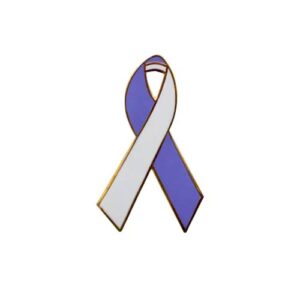

- Beta Foster Care: Beta Foster Care (BFC) is a private non-profit foster family agency licensed by the State of California Department of Social Services Community Care Licensing. BFC trains and certifies qualified adults for foster care under state regulations and manages the appropriate placement of children into these foster homes. The alternate color for Beta Foster Care is blue.
Light Blue Awareness Ribbons: Colors and causes symbolize, stand for and support:
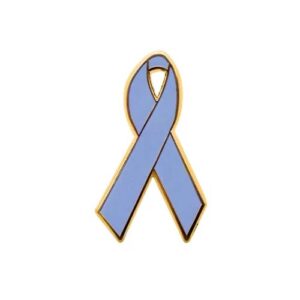

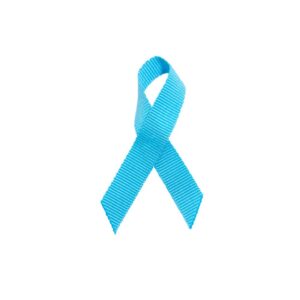
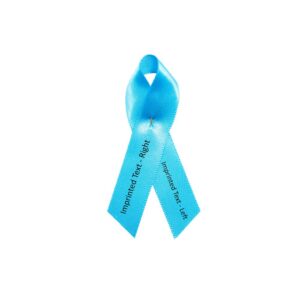


- Achalasia: Achalasia occurs when nerves in the esophagus become damaged. As a result, the esophagus becomes paralyzed and dilated over time and eventually loses the ability to squeeze food down into the stomach. Food then collects in the esophagus, sometimes fermenting and washing back up into the mouth, which can taste bitter.
- ACTH Deficiency: Adrenocorticotropic hormone (ACTH) deficiency is a rare disorder that occurs when the pituitary gland does not produce enough ACTH, a hormone that helps the adrenal glands function and the body respond to stress.
- Addison's Disease: Addison's Disease is a chronic condition that occurs when the adrenal glands do not produce any or enough of the hormones cortisol and aldosterone.
- Adrenal Insufficiency: Adrenal Insufficiency is an endocrine disorder that occurs when the adrenal glands do not produce enough of certain hormones. Secondary Adrenal Insufficiency occurs when the pituitary gland fails to produce enough adrenocorticotropin (ACTH), a hormone that stimulates the adrenal glands to produce the hormone cortisol.
- Autoimmune Dysautonomia: Autoimmune Dysautonomia is a group of disorders that occur when the body's immune system attacks the autonomic nervous system. The alternate color for Autoimmune Dysautonomia is teal.
- Behcet’s Disease / Behcet’s Syndrome: Behcet's Disease, also called Behcet's Syndrome, is a rare disorder that causes blood vessel inflammation throughout your body. The disease can lead to numerous signs and symptoms that can seem unrelated at first. They can include mouth sores, eye inflammation, skin rashes and lesions, and genital sores.
- Chronic Diseases / Chronic Illnesses: A chronic disease is one lasting three months or more, by the definition of the U.S. National Center for Health Statistics. Chronic diseases generally cannot be prevented by vaccines or cured by medication, nor do they just disappear. Spoonies can use this color to designate chronic illness.
- DiGeorge Syndrome: DiGeorge Syndrome is a primary immunodeficiency disease associated with susceptibility to infections due to decreased T cell production and function due to an absent or poorly developed thymus. The thymus is the “schoolhouse” where T-cells are educated to fight infection and prevent autoimmunity. DiGeorge Syndrome is caused by abnormal cell and tissue development during fetal growth. The alternate color for DiGeorge Syndrome is teal.
- Edwards Syndrome: Edwards Syndrome, also known as Trisomy 18, is a very severe genetic condition that affects the way a child's body develops and grows. Children diagnosed with Trisomy 18 have a low birth weight, multiple birth defects and defining physical characteristics. The alternate color for Edwards Syndrome is blue.
- Foster Care: Foster Care is a temporary arrangement in which adults provide for the care of a child or children whose birthparent is unable to care for them. Foster care can be informal or arranged through the courts or a social service agency. The goal for a child in the Foster Care system is usually reunification with the birth family but may be changed to adoption when this is seen as in the child's best interest. While foster care is temporary, adoption is permanent.
- Hyperaldosteronism: Hyperaldosteronism is a disorder in which the adrenal gland releases too much of the hormone aldosterone into the blood. Hyperaldosteronism can be primary or secondary. The alternate color for Hyperadlosteronism is blue.
- Lymphedema: Lymphedema is the name of a type of swelling. Lymphedema occurs when lymph builds up in the body's soft tissues. Lymph is a fluid that contains white blood cells that defend against germs. It can build up when the lymph system is damaged or blocked. It typically builds up in the arms or legs.
- Men's Health: Compared to women, men are more likely to smoke and drink, make unhealthy or risky choices and put off regular checkups and medical care. There are also health conditions that only affect men, such as prostate cancer and low testosterone. Many of the major health risks that men face, such as colon cancer or heart disease, can be prevented and treated with early diagnosis. Screening tests can find diseases early, when they are easier to treat. The alternate color for Men's Health is blue.
- Movember: Movember is an annual event involving the growing of moustaches during the month of November to raise awareness of men's health issues, such as prostate cancer, testicular cancer, and men's suicide. The Movember Foundation runs the Movember charity event. To learn more, go to Movember.com.
- Mutism, Selective: Selective mutism is when a child can’t speak in certain settings but can speak fine in others. For example, a child may not be able to speak at school but can speak with no problem at home. It is called selective mutism because the child is only mute in select situations. It’s a rare childhood condition.
- Penile Cancer: Penile cancer is a disease in which cancer cells form in the tissues of the penis. Penile cancer usually forms on or under the foreskin. Human papillomavirus (HPV) causes about one-third of penile cancer cases. When found early, penile cancer is usually curable.
- Pitt-Hopkins Syndrome: Pitt-Hopkins Syndrome is a genetic syndrome that causes developmental delays, moderate to severe intellectual disability, behavioral differences, distinctive facial features, and breathing problems such as episodes of rapid breathing and breath-holding. Other features may include symptoms of autism spectrum disorder, sleep disturbances, seizures, constipation, nearsightedness, and minor skeletal abnormalities.
- Pro-Choice: The United States abortion-rights movement (also known as the United States pro-choice movement) is a sociopolitical movement in the United States supporting the view that a woman should have the legal right to an elective abortion, meaning the right to terminate her pregnancy. This pro-choice stance is part of a broader global abortion-rights movement. The pro-choice movement consists of a variety of organizations, with no single centralized decision-making body. A key point in abortion rights in the United States was the U.S. Supreme Court's 1973 decision in Roe v. Wade, which struck down most state laws restricting abortion, thereby decriminalizing and legalizing elective abortion in a number of states. Roe v. Wade was overturned by the Supreme Court in 2022.
- Prostate Cancer: The prostate is a gland that is part of the male reproductive system, wrapping around the male urethra at its exit from the bladder. Prostate cancer is common in men over 50 and the risk of developing prostate cancer increases with age. Certain populations are at increased risk for developing prostate cancer, particularly African Americans and men with a father or brother diagnosed with prostate cancer at a younger age.
- Trisomy: Trisomy is a chromosomal condition where a person has an extra copy of a chromosome in some or all their cells. This means that the person has 47 chromosomes instead of the normal 46.
- Trisomy 18 Syndrome / Edwards Syndrome: Trisomy 18, also known as Edwards Syndrome, is a chromosome disorder characterized by having three copies of chromosome 18 instead of the usual two copies.
Light Green Awareness Ribbons: Colors and causes symbolize, stand for and support:
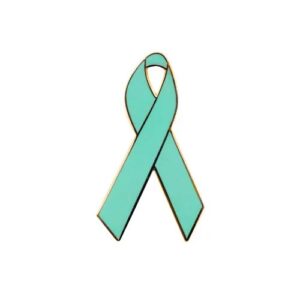



- Celiac Disease: In people with Celiac Disease, inflammation occurs in the small intestinal mucosa when it is exposed to gluten in the diet. Celiac disease is thought to be an autoimmune disorder and may have a familial or genetic component. Because the intestine becomes inflamed, it may also lose its ability to absorb nutrients from the diet, leading to other associated illnesses.
- Chronic Pelvic Pain: Chronic Pelvic Pain is pain in the pelvic area that lasts for six months or longer. Chronic pain can come and go, or it can be constant. Sometimes chronic pelvic pain follows a regular cycle. For example, it may occur during menstruation. It also can occur only at certain times, such as before or after eating, while urinating, or during sex.
- Congenital Hepatic Fibrosis: Congenital Hepatic Fibrosis is characterized by abnormal formation of the bile ducts and the blood vessels of the hepatic portal system. Bile ducts carry bile (a fluid that helps to digest fats) from the liver to the gallbladder and small intestine.
- Human Papilloma Virus (HPV): Human Papilloma Virus, or HPV, is the most common sexually transmitted infection (STI) in the United States. About 80% of women will get at least one type of HPV at some point in their lifetime. It is usually spread through vaginal, oral, or anal sex. Many women do not know they have HPV, because it usually has no symptoms and typically goes away on its own. Some types of HPV can cause illnesses such as genital warts or cervical cancer. There is a vaccine to help prevent HPV. The alternate color for Human Papilloma Virus (HPV) is teal.
- Sexually Transmitted Diseases / STDs / Sexually Transmitted Infections / STIs: Sexually transmitted diseases are characteristically transmitted by sexual contact, such as gonorrhea, syphilis, genital herpes, and chlamydia.
Lime Green awareness ribbons colors and causes symbolize, stand for and support:
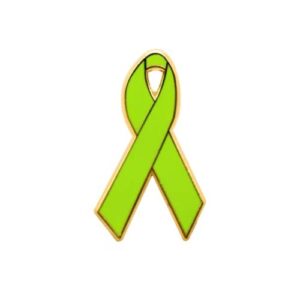

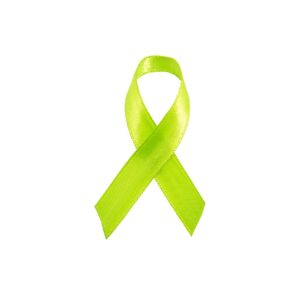


- AIDS-Related Lymphoma: AIDS-related lymphoma is a type of cancer that affects the lymph system, which is part of the body's immune system.
- AIDS-Related Primary Central Nervous System Lymphoma: Lymphoma is a broad term for cancer that begins in cells of the lymph system. The two main types are Hodgkin lymphoma and Non-Hodgkin Lymphoma. Primary CNS lymphoma may occur in patients who have Acquired Immunodeficiency Syndrome (AIDS) or other disorders of the immune system or who have had a kidney transplant.
- Anhedonia: Anhedonia refers to the reduced ability to experience pleasure. It is a feature of several types of psychiatric disorders and maladaptive behaviors. The alternate color for Anhedonia is green.
- Auditory Processing Disorder: Auditory Processing Disorder is a hearing problem that affects about 5% of school-aged children. Children with this condition cannot process what they hear in the same way other children do because their ears and brain do not fully coordinate. Something interferes with the way the brain recognizes and interprets sounds, especially speech.
- Babesiosis: Babesiosis is caused by microscopic parasites that infect red blood cells and are spread by certain ticks. In the United States, tick-borne transmission is most common in particular regions and seasons. It mainly occurs in parts of the Northeast and upper Midwest and usually peaks during the warm months.
- Burkitt Lymphoma: Burkitt Lymphoma is a form of Non-Hodgkin's Lymphoma in which cancer starts in immune cells called B-cells. Recognized as the fastest growing human tumor, Burkitt Lymphoma is associated with impaired immunity.
- CDKL5 Deficiency Disorder: CDKL5 Deficiency Disorder is a rare developmental epileptic encephalopathy caused by mutations in the CDKL5 gene. This can manifest in a broad range of clinical symptoms and severity. The hallmarks are early-onset, intractable epilepsy and neuro developmental delay impacting cognitive, motor, speech, and visual function.
- Cholecystitis: Cholecystitis is a condition that causes the gallbladder to become inflamed, swollen, and red. It occurs when bile, a digestive juice produced in the liver, becomes trapped in the gallbladder. The gallbladder is a small organ located beneath the liver on the right side of the body. The alternate color for Cholecystitis is green.
- Cutaneous T-Cell Lymphoma: Mycosis Fungoides and Sezary Syndrome are diseases in which lymphocytes (a type of white blood cell) become malignant and affect the skin. Mycosis Fungoides and Sezary Syndrome are types of Cutaneous T-Cell Lymphoma.
- Depression: A Depressive Disorder is a clinical syndrome, meaning a group of symptoms. Depressive disorders feature not only negative thoughts, moods, and behaviors but also specific changes in bodily functions (like, eating, sleeping, energy and sexual activity, as well as potentially developing aches or pains). Because depression can lead to self-harm including suicide, it is important to note that one of every 25 suicide attempts results in death. Some types of depression, especially Bipolar Depression, run in families. While there are many social, psychological, and environmental risk factors for developing depression, some are particularly prevalent in one gender or the other, or in particular age or ethnic groups. There can be some differences in signs and symptoms of depression depending upon age, gender, and ethnicity. The alternate color for Depression is green.
- Distal Myopathy: Distal myopathy, also known as distal muscular dystrophy, is a rare genetic disorder that causes muscle weakness and atrophy in the distal muscles. Distal muscles are the muscles further from the center of the body, such as those in the hands, feet, lower arms, and legs. The alternate color for Distal Myopathy is green.
- Duchenne Muscular Dystrophy: Duchenne Muscular Dystrophy is a progressive form of Muscular Dystrophy that occurs primarily in males, though in rare cases may affect females. Duchenne Muscular Dystrophy causes progressive weakness and loss of skeletal and heart muscles. The alternate color for Duchenne Muscular Dystrophy is green.
- Lyme Disease: Lyme Disease is a tick-borne disease. Lyme Disease is not contagious from an affected person to someone else. Lyme Disease can cause abnormalities in the skin, joints, heart, and nervous system.
- Lymphoma: Lymphoma is a general term for a group of cancers that originate in the lymph system (the tissues and organs that produce, store, and carry white blood cells that fight infections and other diseases). The two main kinds of lymphoma are Hodgkin Lymphoma, which spreads in an orderly manner from one group of lymph nodes to another and Non-Hodgkin Lymphoma, which spreads through the lymphatic system in a non-orderly manner. Hodgkin Lymphoma and Non-Hodgkin Lymphoma can occur in children, teens, and adults. Non-Hodgkin Lymphoma becomes more common as people get older. Unlike most cancers, rates of Hodgkin Lymphoma are highest among teens and young adults (ages 15 to 39 years) and again among older adults (ages 75 years or older). White people are more likely than black people to develop Non-Hodgkin Lymphoma, and men are more likely than women to develop lymphoma.
- Maternal Mental Health: Worldwide about 10% of pregnant women and 13% of women who have just given birth experience a mental disorder, primarily depression. In developing countries this is even higher. In severe cases mothers’ suffering might be so severe that they may even commit suicide. Maternal Mental Disorders are treatable. Effective interventions can be delivered even by well-trained non-specialist health providers. The alternate color for Maternal Mental Health is green.
- Mental Health: Mental health is defined as a state of well-being in which individuals realize their own potential, can cope with the normal stresses of life, can work productively and are able to contribute to the community. The alternate color for Mental Health is green.
- Mental Health Disorders: Mental Health Disorders, also known as mental illnesses or mental health conditions, are conditions that affect a person's thinking, feeling, behavior or mood. There are more than 200 types of mental health disorders. The alternate color for Mental Health Disorders is green.
- Mental Health, Childhood: Many mental disorders can begin in childhood. Examples include anxiety disorders, attention-deficit/hyperactivity disorder (ADHD), depression and other mood disorders, eating disorders, and post-traumatic stress disorder (PTSD). Early treatment can help children manage their symptoms and support their social and emotional well-being. Many adults reflect on how mental disorders affected their childhood and wish they had received help sooner. The alternate color for Childhood Mental Health is green.
- Mental Illness, Childhood: Mental health conditions in children are most often defined as delays or changes in thinking, behaviors, social skills or control over emotions. It can be hard to detect mental health conditions in children because typical childhood growth is a process that involves change. Also, the symptoms of a condition may depend on a child's age. Young children may not be able to express how they feel or explain why they are behaving a certain way. Concerns might keep parents from getting care for a child who might have a mental illness. Concerns may be about the stigma linked to mental illness, the use of medicines, the cost of treatment or problems getting help. The alternate color for Childhood Mental Illness is green.
- Minority Mental Health: As hard as it is for anyone to get proper mental health care in the United States, it’s even harder for racial, ethnic, religious and gender minorities. Not only are there the problems most of us experience, including issues with insurance, long wait times, difficulty finding specialists, deductibles and co-pays, but there are added burdens of access and quality-of-care.
- Mood Disorders: Mood Disorder, also known as mood (affective) disorders, is a group of conditions where a disturbance in the person's mood is the main underlying feature. Mood disorders fall into the basic groups of elevated mood, such as mania or hypomania; depressed mood, of which the best-known and most researched is major depressive disorder (commonly called clinical depression), unipolar depression, or major depression and moods which cycle between mania and depression, known as Bipolar Disorder. There are several sub-types of Depressive Disorders or psychiatric syndromes featuring less severe symptoms such as Dysthymic Disorder and Cyclothymic Disorder. Mood disorders may also be substance-induced or occur in response to a medical condition. The alternate color for Mood Disorders is green.
- Muscular Dystrophy / MD: Muscular Dystrophy is a term that refers to several diseases that cause progressive loss of muscle mass resulting in weakness and, sometimes, loss of mobility. There are many kinds of Muscular Dystrophy, each affecting different groups of muscles. In some types of Muscular Dystrophy, symptoms begin in childhood. In other forms, symptom onset doesn’t occur until adulthood.
- Mycosis Fungoides: Mycosis Fungoides and Sezary Syndrome are types of Cutaneous T-Cell Lymphoma. In Mycosis Fungoides, T-cell lymphocytes become cancerous and affect the skin. In Sezary Syndrome, cancerous T-cell lymphocytes affect the skin and are in the blood. Mycosis Fungoides and Sezary Syndrome are the two most common types of cutaneous T-cell lymphoma.
- Myotonic Muscular Dystrophy: Myotonic Dystrophy is a form of Muscular Dystrophy that affects muscles and many other organs in the body. The word myotonic is the adjective for the word myotonia, an inability to relax muscles at will. The term Muscular Dystrophy means progressive muscle degeneration, with weakness and shrinkage of the muscle tissue.
- Non-Hodgkin Lymphoma / Non-Hodgkin's Lymphoma, Adult: Non-Hodgkin Lymphoma is cancer that originates in the lymphatic system, the disease-fighting network spread throughout the body. In Non-Hodgkin Lymphoma, tumors develop from lymphocytes, a type of white blood cell. Non-Hodgkin Lymphoma is more common than the other general type of lymphoma, Hodgkin Lymphoma. Many different subtypes of Non-Hodgkin Lymphoma exist. Diffuse large B-cell lymphoma and follicular lymphoma are among the most common subtypes.
- Non-Hodgkin Lymphoma / Non-Hodgkin’s Lymphoma, Childhood: Non-Hodgkin Lymphoma (sometimes called NHL, or just lymphoma) is a cancer that starts in cells called lymphocytes, which are part of the body’s immune system. NHL is not common in children, but it can occur. The alternate color for childhood Non-Hodgkin Lymphoma is gold.
- Poverty: Poverty is said to exist when people lack the means to satisfy their basic needs. In this context, the identification first requires a determination of what constitutes basic needs.
- Psychosis: Psychosis refers to a collection of symptoms that affect the mind, where there has been some loss of contact with reality. During an episode of psychosis, a person's thoughts and perceptions are disrupted and they may have difficulty recognizing what is real and what is not. The alternate color for Psychosis is green.
- Sezary Syndrome: Mycosis Fungoides and Sezary Syndrome are diseases in which lymphocytes (a type of white blood cell) become malignant and affect the skin. Mycosis Fungoides and Sezary Syndrome are types of Cutaneous T-Cell Lymphoma. In Sezary Syndrome, cancerous T-cells are found in the blood.
- Spasticity: Spasticity is a state of increased tone of a muscle and an increase in the deep tendon reflexes. For example, with spasticity of the legs (spastic paraplegia) there is an increase in tone of the leg muscles, so they feel tight and rigid and the knee jerk reflex is exaggerated.
- Spinal Cord Injury: Spinal Cord Injury involves damage to any part of the spinal cord. It also can include damage to nerves at the end of the spinal cord, known as the cauda equina. The spinal cord sends and receives signals between the brain and the rest of the body. A spinal cord injury often causes permanent changes in strength, feeling and other body functions below the site of the injury. The alternate color for Spinal Cord Injury is green.
- Stress-Induced Illnesses (Mental Health): When stress becomes overwhelming and prolonged, the risks for mental health problems and medical problems increase. Long-term stress increases the risk of mental health problems such as anxiety and depression, substance use problems, sleep problems, pain and bodily complaints such as muscle tension. The alternate color for Stress-Induced Illnesses cause by mental health is green.
- Trichotillomania: Trichotillomania, also called Hair-Pulling Disorder, is a mental disorder that involves recurrent, irresistible urges to pull out hair from the scalp, eyebrows or other areas of the body, despite trying to stop. The alternate color for Trichotillomania is olive green.
Lime Green and Aqua Awareness Ribbons: Colors and causes symbolize, stand for and support:
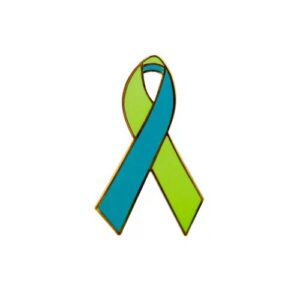

- Healthy Aging: Many factors influence healthy aging. Some of these, such as genetics, are not in our control. Others, like exercise, a healthy diet, going to the doctor regularly, and taking care of our mental health, are within our reach.
Lime Green and Fuchsia Awareness Ribbons: Colors and causes symbolize, stand for and support:
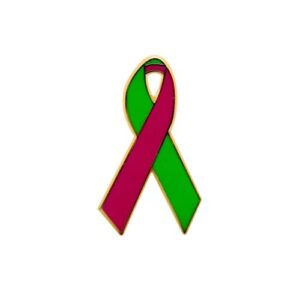

-
Flu - Get Your Flu Shot: Flu is a common viral infection that can be deadly, especially in high-risk groups. The flu attacks the lungs, nose, and throat. Young children, older adults, pregnant women, and people with chronic disease or weak immune systems are at high risk. Symptoms include fever, chills, muscle aches, cough, congestion, runny nose, headaches, and fatigue.The flu is treated primarily with rest and fluid to let the body fight the infection on its own. An annual vaccine can help prevent the flu and limit its complications. Flu is spread by airborne respiratory droplets (coughs or sneezes), touching a contaminated surface, saliva (kissing or shared drinks), skin- to-skin contact (handshakes or hugs).
- Flu Prevention / Flu Vaccine: Flu vaccination can reduce flu illnesses, doctors' visits, and missed work and school due to flu, as well as prevent flu-related hospitalizations. CDC recommends that everyone six months of age and older get a flu vaccine every year. An annual flu vaccine is the first and best way to protect against flu.
Maroon and Gray Awareness Ribbons: Colors and causes symbolize, stand for and support:
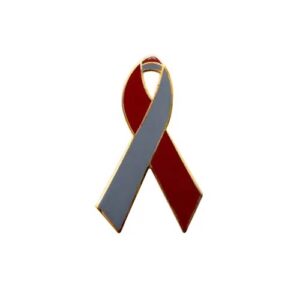

- Arachnoid Cysts: Arachnoid Cysts are cerebrospinal fluid covered by arachnoid cells and collagen that may develop between the surface of the brain and the cranial base or on the arachnoid membrane. The arachnoid membrane is one of the three meningeal layers that cover the brain and spinal cord.
Olive Green Awareness Ribbons: Colors and causes symbolize, stand for and support:
Orange Awareness Ribbons: Colors and causes symbolize, stand for and support:
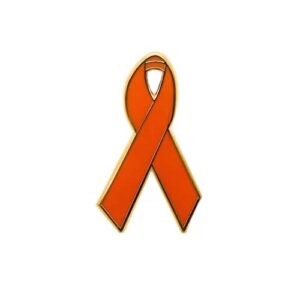
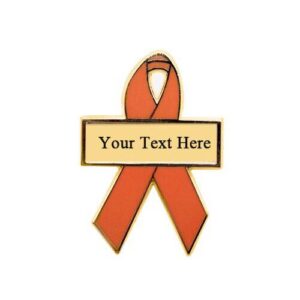
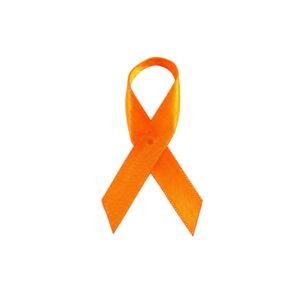



- Acute Lymphoblastic Leukemia, Adult: Adult Acute Lymphoblastic Leukemia, also called Acute Lymphocytic Leukemia, is a cancer of the blood and bone marrow.
- Acute Lymphoblastic Leukemia, Childhood: Childhood Acute Lymphoblastic Leukemia is a cancer of the blood and bone marrow. This type of cancer usually gets worse quickly if it is not treated. Childhood Acute Lymphoblastic Leukemia is a type of cancer in which the bone marrow makes too many immature lymphocytes (a type of white blood cell). Leukemia may affect red blood cells, white blood cells, and platelets. The alternate color for Childhood Acute Lymphoblastic Leukemia is gold.
- Acute Myeloid Leukemia, Adult: Adult Acute Myeloid Leukemia is a cancer of the blood and bone marrow. It is the most common type of acute leukemia in adults. Acute Myeloid Leukemia is also called Acute Myelogenous Leukemia, Acute Myeloblastic Leukemia, Acute Granulocytic Leukemia, and Acute Non-Lymphocytic Leukemia.
- Acute Myeloid Leukemia, Childhood: Childhood Acute Myeloid Leukemia, also called Acute Myelogenous Leukemia or AML, is a type of blood cancer. It is a quickly progressing disease in which too many abnormal white blood cells are found in the bone marrow, the soft, spongy center of long bones. In Acute Myeloid Leukemia, myeloid stem cells (a type of blood stem cell) become immature white blood cells called myeloblasts or “blasts.” These blasts do not become healthy white blood cells. Instead, they build up in the bone marrow, so there is less room for healthy white blood cells, red blood cells and platelets. In addition, these abnormal cells are unable to fight off infection. The alternate color for Childhood Acute Myeloid Leukemia is gold.
- Amniotic Band Syndrome: Amniotic Band Syndrome refers to a condition in which bands develop from the inner lining of the amnion. The amnion is the sac that surrounds the baby in the womb. As the baby develops in the womb, the bands may attach to and affect the development of different areas of the body.
- Asylum Seekers: An asylum seeker is a person who flees his or her home country, spontaneously enters another country and applies for asylum, (i.e. the right to international protection, in this other country.) An asylum seeker may be a refugee, a displaced person or a migrant, such as an economic migrant. The alternate color for Asylum Seekers is yellow.
- Attention Deficit Disorder / ADD: ADD, or Attention-Deficit Disorder, is an old term, now out of date, for the disorder now called ADHD, or Attention-Deficit Hyperactivity Disorder. It was called ADD up until 1987, when the word “hyperactivity” was added to the name.
- Attention Deficit Hyperactivity Disorder (ADHD): Attention Deficit Hyperactivity Disorder is a chronic condition including attention difficulty, hyperactivity (ADHD), and impulsiveness.
- Basal Cell Carcinoma of the Skin: Skin cancer is the most common type of cancer. The main types of skin cancer are Squamous Cell Carcinoma, Basal Cell Carcinoma, and Melanoma. Squamous cells are thin, flat cells that form the top layer of the epidermis. Basal cells are the round cells under the squamous cells. Melanoma is much less common than the other types but much more likely to invade nearby tissue and spread to other parts of the body. Most deaths from skin cancer are caused by melanoma.
- Bowen Disease: Bowen's disease is a very early form of skin cancer that's easily treatable. The main sign is a red, scaly patch on the skin. It affects the squamous cells, which are in the outer layer of skin, and is sometimes referred to as squamous cell carcinoma in situ. The patch is usually very slow growing.
- Cat Eye Syndrome: Cat eye syndrome (CES) is a rare chromosomal disorder that may be evident at birth. The name “cat eye syndrome” is derived from a distinctive eye (ocular) abnormality that is present in a little over half affected individuals.
- Chronic Lung Disease: Chronic lung disease (CLD) is a general term for a group of disorders that affect the lungs and the respiratory system. CLD can develop slowly and worsen over time.
- Chronic Lymphocytic Leukemia: Chronic Lymphocytic Leukemia is a type of cancer in which the bone marrow makes too many lymphocytes (a type of white blood cell). Chronic Lymphocytic Leukemia is a blood and bone marrow disease that usually gets worse slowly. It is one of the most common types of leukemia in adults. It often occurs during or after middle age. It rarely occurs in children.
- Chronic Myelogenous Leukemia: Chronic Myelogenous Leukemia (also called CML or chronic granulocytic leukemia) is a slowly progressing blood and bone marrow disease that usually occurs during or after middle age, and rarely occurs in children.
- Chronic Obstructive Pulmonary Disease: COPD, or Chronic Obstructive Pulmonary Disease, is a long-term lung disease that refers to both chronic bronchitis and emphysema. COPD symptoms include persistent cough with mucus and shortness of breath.
- Complex Regional Pain Syndrome / CRPS / Reflex Sympathetic Dystrophy Syndrome / RSDS: Complex Regional Pain Syndrome, also known as Reflex Sympathetic Dystrophy Syndrome, is a rare disorder of the sympathetic nervous system that is characterized by chronic, severe pain. The sympathetic nervous system is the part of the autonomic nervous system that regulates involuntary functions of the body such as increasing heart rate, constricting blood vessels, and increasing blood pressure. Excessive or abnormal responses of portions of the sympathetic nervous system are thought to be responsible for the pain associated with Reflex Sympathetic Dystrophy Syndrome.
- COPD: COPD is a group of diseases that damage the lungs and airways, making it harder for air to flow in and out.
- Cultural Diversity: Cultural diversity is the inclusion of diverse people. The phrase cultural diversity can also refer to having different cultures respect each other's differences.
- Emphysema: Emphysema is a lung condition that causes shortness of breath. In people with emphysema, the air sacs in the lungs (alveoli) are damaged. Over time, the inner walls of the air sacs weaken and rupture, creating larger air spaces instead of many small ones. This reduces the surface area of the lungs and, in turn, the amount of oxygen that reaches the bloodstream.
- End Gun Violence (Wear Orange): We deserve more than to live in a country where firearms are the leading cause of death for children and teens in the United States. But as incidents of gun violence have grown, so too has the movement to stop it. By participating in Wear Orange online and in your community, we will organize, advocate, and rally for safer communities. Together we can build a future free from gun violence.
- Facioscapulohumeral Muscular Dystrophy: Facioscapulohumeral muscular dystrophy (FSHD) is a genetic muscle disorder in which the muscles of the face, shoulder blades, and upper arms are among the most affected.
- Familial Mediterranean Fever: Familial Mediterranean fever (FMF) is an autoinflammatory genetic disorder that mainly affects people of Mediterranean origin. FMF is characterized by recurrent episodes of fever and serositis (chest, abdomen, joints), leading to painful attacks early during childhood. Amyloidosis is the most fatal complication of FMF.
- Food Insecurity and Hunger / Food Deserts: The U.S. Department of Agriculture defines food deserts as areas where people live more than 1 mile from a supermarket in urban areas, or ten miles away in rural areas. This often translates into families shopping at ‘mini marts’ or gas stations for their routine groceries. These local businesses generally sell ‘junk’ food and have significantly higher prices for this food, which is rarely fresh. Food deserts have a disproportionate impact on urban Latino and African American communities, and rural Indigenous Peoples and Caucasian communities. Food insecurity is much more profound within these food deserts.
- Functional Neurological Disorder: Functional neurologic disorder (FND) refers to a neurological condition caused by changes in how brain networks work, rather than changes in the structure of the brain itself, as seen in many other neurological disorders. Physical symptoms of FND are genuine but cannot be explained by changes in the brain structure. The exact cause of FND is unknown.
- Gun Control: Gun control is a broad term that covers any sort of restriction on what kinds of firearms can be sold and bought, who can possess or sell them, where and how they can be stored or carried, what duties a seller has to vet a buyer, and what obligations both the buyer and the seller have to report transactions to the government. Sometimes, the term is also used to cover related matters, like limits on types of ammunition and magazines, or technology, like the type that allows guns to fire only when gripped by their owners. In recent years, gun control debates have focused primarily on background checks for buyers, allowing people to carry weapons in public, and whether to allow the possession of assault rifles. Firearm injuries are a serious public health problem. In 2020, there were 45,222 firearm-related deaths in the United States. That is about 124 people dying from a firearm-related injury each day. More than half of firearm-related deaths were suicides and more than 4 out of every 10 were firearm homicides.
- Hairy Cell Leukemia: Hairy Cell Leukemia is a cancer of the blood and bone marrow. This rare type of leukemia gets worse slowly or does not get worse at all. The disease is called Hairy Cell Leukemia because the leukemia cells look "hairy" when viewed under a microscope.
- Hernia: A hernia is a condition where an organ or tissue pushes through a weak area in the muscle or tissue wall that surrounds it. Hernias can occur in many parts of the body, but most commonly in the abdomen. They can be caused by a combination of muscle weakness and straining, such as from heavy lifting, coughing, urinating, or constipation.
- Humane Treatment of Refugees: Today, intense and unrelenting conflicts have driven more people from their homes than ever before. 65 million people are displaced globally, including 21 million refugees, half of them children. The immense scale of the global refugee crisis is challenging policymakers across the world to offer protection and dignity to a dramatically higher number of people while preventing deaths at sea and addressing local concerns about border protection.
- Hunger: 821 million people in the world do not get the food they need to live a healthy life. 66 million primary school-age children attend classes hungry across the developing world. Malnutrition in all its forms, from wasting to obesity, directly affects one in three people.
- Kidney Cancer (Renal Cell): Kidney cancer is a disease in which the cells in certain tissues of the kidney start to grow uncontrollably and form tumors. Renal cell carcinoma, which occurs in the cells lining the kidneys (epithelial cells), is the most common type of kidney cancer.
- Leukemia: Leukemia is a malignant progressive disease in which the bone marrow and other blood-forming organs produce increased numbers of immature or abnormal leukocytes. These suppress the production of normal blood cells, leading to anemia and other symptoms.
- Limb Difference: Limb Difference is the partial or complete absence of or malformation of limbs (arms and legs). There are two main types of limb difference: congenital limb difference and acquired limb difference. Congenital Limb Difference is also referred to as "limb reduction" or congenital amputation or amelia and occurs when someone is born missing all or part of the upper and/or lower limbs. Acquired Limb Differences is also known as Amputation and occurs when someone has a limb removed for medical reasons, or accidentally due to trauma.
- Limb Loss: Limb loss, also known as amputation, is the surgical removal of a limb or part of a limb. It can be caused by a number of factors.
- Malnutrition: Malnutrition refers to deficiencies, excesses or imbalances in a person’s intake of energy and/or nutrients. The term malnutrition covers two broad groups of conditions. One is undernutrition, which includes stunting (low height for age), wasting (low weight for height), underweight (low weight for age) and micronutrient deficiencies or insufficiencies (a lack of important vitamins and minerals). The other is overweight, obesity and diet-related noncommunicable diseases (such as heart disease, stroke, diabetes and cancer).
- Merkel Cell Carcinoma (Skin Cancer): Merkel Cell Carcinoma is a rare type of skin cancer that usually appears as a flesh-colored or bluish-red nodule, often on the face, head or neck. Merkel Cell Carcinoma is also called Neuroendocrine Carcinoma of the skin. Merkel Cell Carcinoma most often develops in older people. Long-term sun exposure or a weak immune system may increase the risk of developing Merkel Cell Carcinoma. Merkel Cell Carcinoma tends to grow fast and to spread quickly to other parts of the body.
- Motorcycle Safety: In 2020, 82,528 motorcyclists were recorded injured, 5,579 motorcyclists were killed, totaling 14% of all traffic fatalities in that same year according to the National Highway Traffic Safety Administration (NHTSA). Riding a motorcycle is not without risk. Injuries and fatalities are not uncommon. But taking precautions on the road and preparing properly can reduce the severity of the risk. In states without universal helmet laws, 57% of motorcyclists killed were not wearing helmets compared to 11% in states with helmet laws. The NHTSA estimates that 1,872 motorcyclists’ lives were saved by wearing a helmet in 2017. Practicing responsible riding and wearing the appropriate protective gear can help you keep riding for many years to come.
- Multiple Sclerosis (MS): Multiple Sclerosis (MS) is a potentially disabling disease of the brain and spinal cord (Central Nervous System). In MS, the immune system attacks the protective sheath (myelin) that covers nerve fibers and causes communication problems between the brain and the rest of the body. Eventually, the disease can cause the nerves themselves to deteriorate or become permanently damaged.
- Myelogenous Leukemia, Chronic / CML: Chronic Myelogenous Leukemia, also called CML, is an uncommon type of cancer of the bone marrow. Bone marrow is the spongy tissue inside bones where blood cells are made. CML causes an increased number of white blood cells in the blood. The term "chronic" in Chronic Myelogenous Leukemia means this cancer tends to progress more slowly than severe forms of leukemia. The term "myelogenous" refers to the type of cells affected by this cancer. Chronic Myelogenous Leukemia also can be called Chronic Myeloid Leukemia and Chronic Granulocytic Leukemia. It typically affects older adults and rarely occurs in children, though it can occur at any age.
- Myeloid Leukemia, Acute: Adult Acute Myeloid Leukemia is a type of cancer in which the bone marrow makes abnormal myeloblasts (a type of white blood cell), red blood cells, or platelets. This type of cancer usually gets worse quickly if it is not treated. It is the most common type of acute leukemia in adults. Acute Myeloid Leukemia is also called Acute Myelogenous Leukemia, Acute Myeloblastic Leukemia, Acute Granulocytic Leukemia, and Acute Nonlymphocytic Leukemia.
- No Kids or Pets Unattended in Cars: Every day, children and pets are left unattended in or around vehicles, a danger most people greatly underestimate. This emerging public health issue causes death and injury due to the dangerous social practice of leaving children and pets unattended in or around vehicles.
- Non-Melanoma Skin Cancer, Adult: Non-melanoma skin cancer refers to all the types of cancer that occur in the skin that are not melanoma. Several types of skin cancer fall within the broader category of non-melanoma skin cancer, with the most common types being basal cell carcinoma and squamous cell carcinoma.
- Non-Melanoma Skin Cancer, Childhood: Risk factors for childhood Basal Cell Carcinoma and Squamous Cell Carcinoma of the skin include being exposed to natural sunlight or artificial sunlight (such as from tanning beds), having a fair complexion, actinic keratosis, Gorlin Syndrome, past treatment with radiation, and a weakened immune system. The alternate color for Childhood Non-Melanoma Skin Cancer is gold.
- Orange Ribbon for At-Risk Animals: Registered with the US Patent and Trademark Office, the Orange Ribbon for Animals is the official awareness ribbon for at-risk animals in the United States.
- Parkland Hill School Shooting: The Parkland high school shooting was a mass shooting that occurred on February 14, 2018, at Marjory Stoneman Douglas High School in the Miami city of Parkland, Florida.
- Prader-Willi Syndrome: Prader-Willi Syndrome is a genetic condition that affects many parts of the body. Infants with Prader-Willi Syndrome have severe hypotonia, feeding difficulties, and slow growth. In later infancy or early childhood, affected children typically begin to eat excessively and become obese. Other signs and symptoms often include short stature, hypogonadism, developmental delays, cognitive impairment, and distinctive behavioral characteristics such as temper tantrums, stubbornness, and obsessive-compulsive tendencies.
- Primary Ciliary Dyskinesia: Primary Ciliary Dyskinesia is a disorder characterized by chronic respiratory tract infections, abnormally positioned internal organs, and the inability to have children (infertility).
- Racial Tolerance: Racial tolerance can be described as “a respect, acceptance and appreciation of the rich diversity of our world's cultures, forms of expression and ways of being human. Tolerance is harmony in difference.”
- Reflex Sympathetic Dystrophy Syndrome: Complex Regional Pain Syndrome (CRPS), also known as Reflex Sympathetic Dystrophy Syndrome (RSDS), involves a disturbance in the sympathetic nervous system. The sympathetic nervous system is the network of nerves located alongside the spinal cord that controls certain bodily functions, such as opening and closing blood vessels or sweat glands. CRPS causes musculoskeletal pain and skin changes, primarily in the hands and feet.
- Renal Cell Cancer (Kidney Cancer): Renal Cell Cancer (also called kidney cancer or renal cell adenocarcinoma) is a disease in which malignant (cancer) cells are found in the lining of tubules (very small tubes) in the kidney. Kidney cancer can develop in adults and children. The main types of kidney cancer are Renal Cell Cancer, Transitional Cell Cancer, and Wilms' Tumor. Certain inherited conditions increase the risk of kidney cancer. Cancer that starts in the ureters or the renal pelvis (the part of the kidney that collects urine and drains it to the ureters) is different from Renal Cell Cancer.
- Renal Cell Carcinoma: Renal cell carcinoma (RCC) is a type of kidney cancer that develops in the lining of the kidney's small tubes. It's the most common type of kidney cancer in adults, accounting for about 90–95% of cases.
- Self-Harm (Self-Injury): Self-Harm or Self-Injury means hurting oneself on purpose. One common method is cutting oneself with a knife. But any time someone deliberately hurts herself is classified as self-harm. Some people feel an impulse to burn themselves, pull out hair or pick at wounds to prevent healing. Extreme injuries can result in broken bones. The alternate color for Self-Harm or Self-Injury is gold.
- Squamous Cell Carcinoma of the Skin: Skin cancer is the most common type of cancer. The main types of skin cancer are Squamous Cell Carcinoma, Basal Cell Carcinoma, and Melanoma. Melanoma is much less common than the other types but much more likely to invade nearby tissue and spread to other parts of the body. Most deaths from skin cancer are caused by melanoma.
- Thymoma and Thymic Carcinoma: Thymomas and thymic carcinomas are rare tumors that form in cells on the thymus. Thymomas grow slowly and rarely spread beyond the thymus. Thymic carcinoma grows faster, often spreads to other parts of the body, and is harder to treat. The alternate color for Thymoma and Thymic Carcinoma is pearl.
- Transitional Cell Cancer of the Renal Pelvis and Ureter Cancer: Kidney cancer can develop in adults and children. The main types of kidney cancer are Renal Cell Cancer, Transitional Cell Cancer, and Wilms' Tumor. Certain inherited conditions increase the risk of kidney cancer. Renal Cell Cancer is a more common type of kidney cancer.
- Wilms' Tumor / Childhood Kidney Tumors: Kidney cancer can develop in adults and children. The main types of kidney cancer are Renal Cell Cancer, Transitional Cell Cancer, and Wilms' Tumor. Certain inherited conditions increase the risk of kidney cancer. Childhood kidney tumors are diseases in which malignant (cancer) cells form in the tissues of the kidney. There are many types of childhood kidney tumors, which include: Wilms' Tumor, Renal Cell Cancer, Rhabdoid Tumor of the Kidney, Clear Cell Sarcoma of the Kidney, Congenital Mesoblastic Nephroma, Ewing Sarcoma of the Kidney, Primary Renal Myoepithelial Carcinoma, Cystic Partially Differentiated Nephroblastoma, Multiocular Cystic Nephroma, Primary Renal Synovial Sarcoma, and Anaplastic Sarcoma of the Kidney. Nephroblastomatosis is not cancer but may become Wilms' Tumor. The alternate color for Wilms' Tumor in children is gold.
- World Hunger: Although the number of undernourished people has dropped by over 20% since 1992 (216 million fewer than in 1990-92) today there are 821 million people who do not have enough to eat. This is more than the 795 million in 2014, although still down from about 900 million in 2000. 98% of the world’s undernourished people live in developing countries. 767 million people, or 1 in 10 people in the world, live under $1.90 a day, and half of the extreme poor (389 million) live in Sub-Saharan Africa. 328 million children are living in extreme poverty.
Orange and Blue Awareness Ribbons: Colors and causes symbolize, stand for and support:
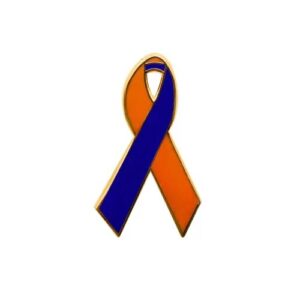
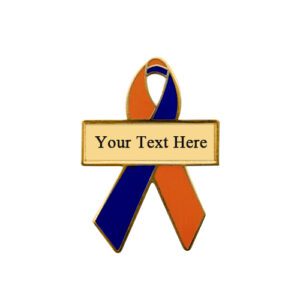
- Arthritis, Psoriatic: Psoriatic arthritis is a chronic inflammatory disease that affects the joints and entheses, the points where tendons and ligaments connect to bones. The alternate color for Psoriatic Arthritis is orange and lavender.
- Marshall County HS Shooting: The Marshall County High School shooting occurred at Marshall County High School in Benton, Kentucky, on January 23, 2018.
- Union for International Cancer Control, World Cancer Day: The Union for International Cancer Control (UICC) unites and supports the cancer community to reduce the global cancer burden, to promote greater equity, and to ensure that cancer control continues to be a priority in the world health and development agenda. Every year on February 4th, World Cancer Day galvanizes the global community to raise awareness, improve education, and ignite personal, collective, and government action in the fight against cancer.
Orange and Green Awareness Ribbons: Colors and causes symbolize, stand for and support:
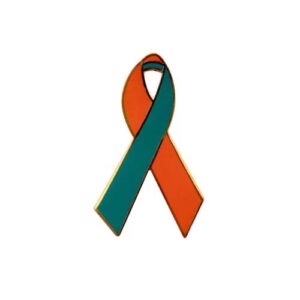
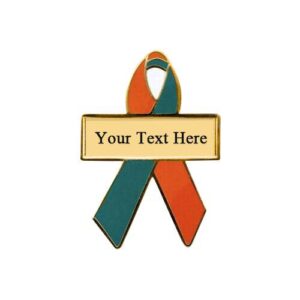
- Dual Diagnosis: Dual diagnosis (also referred to as co-occurring disorders) is a term for when someone experiences a mental illness, and a substance use disorder simultaneously. Either disorder, substance use or mental illness, can develop first. People experiencing a mental health condition may turn to alcohol or other drugs as a form of self-medication to improve the mental health symptoms they experience. However, research shows that alcohol and other drugs worsen the symptoms of mental illnesses.
Orange and Lavender Awareness Ribbons: Colors and causes symbolize, stand for and support:
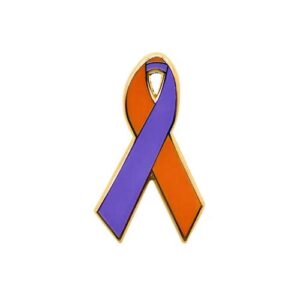

- Eczema: Eczema is a common skin condition marked by itchy and inflamed patches of skin. It is also known as Atopic Dermatitis. It is more common in babies and young children, and often occurs on the faces of infants. It also often appears inside the elbows and behind the knees of children, teenagers, and adults. In rare cases, Atopic Dermatitis can first appear during puberty or adulthood. It affects males and females equally.
- Psoriasis: Psoriasis is a chronic, inflammatory skin disease. Psoriasis is related to inherited genes and the immune system. Plaque Psoriasis is the most common form of psoriasis.
- Psoriatic Arthritis: Psoriatic Arthritis is a form of arthritis that affects some people who have psoriasis, a condition that features red patches of skin topped with silvery scales. Most people develop psoriasis first and are later diagnosed with Psoriatic Arthritis, but the joint problems can sometimes begin before skin lesions appear. The alternate color for Psoriatic Arthritis is orange and blue.
Orange and Purple Awareness Ribbons: Colors and causes symbolize, stand for and support:
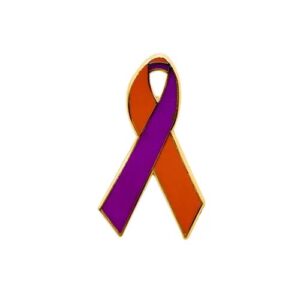
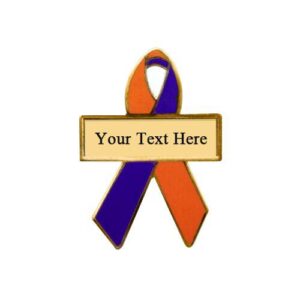
- Failed Back Surgery Syndrome: Failed Back Surgery Syndrome refers to a subset of patients who have new or persistent pain after spinal surgery for back or leg pain. The pain can be reduced but still present or may get worse within a few months after surgery due to a buildup of scar tissue around spinal nerve roots, along with persistent tissue pain and muscle spasm. The term refers to a condition of continuing pain and is not meant to imply there was necessarily a problem during surgery. While published reports estimate the incidence of Failed Back Surgery Syndrome to be between 20 – 40%, the likelihood is considered greater with repeated surgery, and the condition will be more prevalent in regions where spinal surgery is more common.
Orange and Red Awareness Ribbons: Colors and causes symbolize, stand for and support:
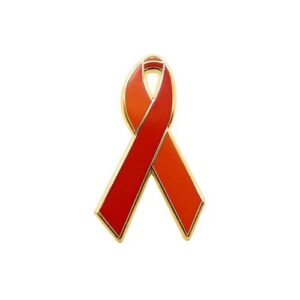

- Adiposis Dolorosa: Adiposis Dolorosa, also known as Dercum disease, is a rare disorder that causes painful fatty tissue growths or benign fatty tumors called lipomas.
- Dercum's Disease: Dercum's Disease is a rare disorder characterized by multiple, painful growths of fatty tissue (lipomas). Fat tissue is known as loose connective tissue, hence Dercum's disease is a loose connective tissue disease.
- Essential Thrombocythemia: Essential Thrombocythemia Is a rare blood disease in which the bone marrow produces too many platelets. High numbers of platelets may lead to a thrombus, a blood clot that forms in a blood vessel. This can cause serious health problems such as a stroke, heart attack or pulmonary embolism. Essential thrombocythemia is one of a related group of blood cancers known as myeloproliferative neoplasms (MPNs) in which cells in the bone marrow that produce the blood cells develop and function abnormally. On average, individuals with ET have a normal life expectancy if they are properly monitored and treated. In a small number of patients, the disease may transform to Myelofibrosis, Acute Myeloid Leukemia or, less frequently, Myelodysplastic Syndrome. The alternate color for Essential Thrombocythemia is burgundy.
- Kawasaki Disease: Kawasaki Disease is a rare childhood condition that involves inflammation of the blood vessels, especially the coronary arteries. It is a disease of infants and young children, usually age 2 years and younger, with boys afflicted more often than girls. Although all racial groups are affected, children of Asian ancestry are more likely to develop the disease. The alternate color for Kawasaki Disease is red.
- Myelofibrosis: Myelofibrosis is a disorder of the spongy tissue inside the bone (bone marrow) that contains the stem cells that will form blood cells. In Myelofibrosis, the bone marrow is replaced by fibrous (scar) tissue. When the bone marrow is scarred, it cannot make enough blood cells. This leads to anemia, weakness, fatigue, and often, swelling of the liver and spleen.
- Myeloproliferative Disorders: Myeloproliferative Disorders are blood cancers caused by changes in the stem cells inside bone marrow, the tissue that makes blood cells. These changes cause the body to make too many blood cells. This excess can be any type of blood cell including white, red, or platelets. A MPD diagnosis depends on which blood cell, or cells, the body overproduces. MPDs usually affect only one type of blood cell. Rarely do they affect more than one.
- Myeloproliferative Neoplasms / MPN, Chronic including ET, MF, and PV: Chronic Myeloproliferative Neoplasms are blood cancers that occur when the body makes too many white or red blood cells, or platelets. This overproduction of blood cells in the bone marrow can create problems for blood flow and lead to various symptoms. MPNs were called Myeloproliferative Diseases until 2008 when the World Health Organization reclassified them as cancers and renamed them Myeloproliferative Neoplasms. There are three main types of MPNs: Polycythemia Vera (PV), Essential Thrombocythemia (ET), Myelofibrosis (MF). Certain Leukemias, including Chronic Myelogenous Leukemia, are also now considered Myeloproliferative Neoplasms. The alternate colors for Chronic Myeloproliferative Neoplasms is red.
- Polycythemia Vera: Polycythemia Vera, or PV, is a rare, chronic blood cancer in which a person’s body makes too many red blood cells, white blood cells, and platelets. Polycythemia Vera is part of a group of diseases called Myeloproliferative Neoplasms. Too many red blood cells can cause the blood to thicken. Thicker blood does not flow normally through arteries and veins. The alternate color for Polycythemia Vera is red.
- Primary Myelofibrosis: Primary Myelofibrosis is a rare bone marrow disorder that is characterized by abnormalities in blood cell production (hematopoiesis) and scarring (formation of fibrous tissue) within the bone marrow. Bone marrow is the soft, spongy tissue that fills the center of most bones.
Orange and Yellow Awareness ribbons colors and causes symbolize, stand for and support:
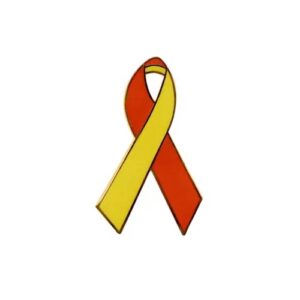

- Stiff Person Syndrome: Stiff Person Syndrome, also known as stiff-man syndrome, is a rare neurologic disorder of unclear cause characterized by progressive rigidity and stiffness. The stiffness primarily affects the trunk muscles and is superimposed by spasms, resulting in postural deformities. The alternate color for Stiff Person Syndrome is zebra.
Orchid Awareness Ribbons: Colors and causes symbolize, stand for and support:
Paisley Awareness Ribbons: Colors and causes symbolize, stand for and support:
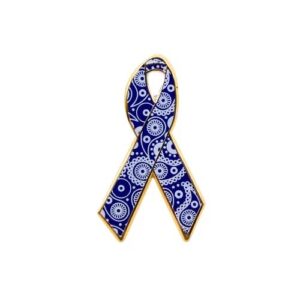

- Goiter: A goiter commonly develops because of iodine deficiency or inflammation of the thyroid gland. Not all goiters cause symptoms. Symptoms that do occur might include swelling, and cough. Rarely, symptoms may include throat tightness or trouble breathing.
- Graves' Disease: Graves' Disease is an immune system disorder that results in the overproduction of thyroid hormones (hyperthyroidism). Although several disorders may result in hyperthyroidism, Graves' Disease is a common cause. Thyroid hormones affect many body systems, so signs and symptoms of Graves' Disease can be wide ranging.
- Hashimoto's Thyroid Disease: Hashimoto's Disease is an autoimmune disorder. The immune system creates antibodies that attack thyroid cells as if they were bacteria, viruses or some other foreign body.
- Hashimoto's Thyroiditis: Hashimoto's Thyroiditis is also called Hashimoto's Disease. Hashimoto's Thyroiditis is an autoimmune disease, a disorder in which the immune system turns against the body's own tissues. In people with Hashimoto's, the immune system attacks the thyroid. This can lead to hypothyroidism, a condition in which the thyroid does not make enough hormones for the body's needs.
- Hyperthyroidism: Hyperthyroidism (overactive thyroid) occurs when the thyroid gland produces too much of the hormone thyroxine. Hyperthyroidism can accelerate your body's metabolism, causing unintentional weight loss and a rapid or irregular heartbeat. Several treatments are available for hyperthyroidism.
- Hypothyroidism: Hypothyroidism (under active thyroid) is a condition in which the thyroid gland does not produce enough of certain important hormones. Women, especially those older than age 60, are more likely to have hypothyroidism. Hypothyroidism upsets the normal balance of chemical reactions in the body. It seldom causes symptoms in the early stages, but over time, untreated hypothyroidism can cause health problems, such as obesity, joint pain, infertility and heart disease.
- Ord’s Thyroiditis: Ord's Thyroiditis is also known as Ord's Disease. This autoimmune condition is characterized by atrophy of the thyroid gland and hypothyroidism. It is very similar to Hashimoto's Disease, apart from the shrinking of the thyroid gland instead of the development of a goiter.
- Thyroiditis: Thyroiditis is swelling (inflammation) of the thyroid gland. It causes either unusually high or low levels of thyroid hormones in the blood. The thyroid is a butterfly-shaped gland in the neck. It produces hormones that control the body's growth and metabolism.
- Thyroid Disease: Thyroid disease is a medical condition that affects the thyroid gland's ability to produce hormones. The thyroid is a butterfly-shaped gland in the neck that produces hormones that regulate many bodily functions, including metabolism, heart rate, and body temperature.
- Thyroid Nodules: The term thyroid nodule refers to an abnormal growth of thyroid cells that forms a lump within the thyroid gland. Although most thyroid nodules are benign (noncancerous), a small proportion of thyroid nodules do contain thyroid cancer. In order to diagnose and treat thyroid cancer at the earliest stage, most thyroid nodules need some type of evaluation.
Peach Awareness Ribbons: Colors and causes symbolize, stand for and support:
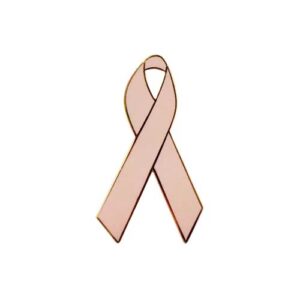



- Autoimmune Progesterone Dermatitis: Autoimmune Progesterone Dermatitis is a rare autoimmune response to endogenous progesterone that usually occurs in fertile females. Cutaneous or mucosal lesions develop cyclically during the luteal phase of the menstrual cycle when progesterone levels are elevated.
- Endometrial Cancer: Endometrial Cancer is cancer that starts in the endometrium, the lining of the uterus (womb). Endometrial cancer is the most common type of uterine cancer.
- Endometrial Stromal Cancer: Endometrial Stromal Sarcoma is the rarest type of uterine cancer that accounts for less than 1% of cancers of the female reproductive organs. These tumors tend to occur more often in premenopausal women between 40-50 years of age. This is younger than the average for uterine cancer in general (early 60s).
- Gynecologic (Gynecological) Cancer: Gynecologic cancer is a disease that occurs when cells in a woman's reproductive organs grow out of control. The five main types of gynecological cancer are cervical cancer, ovarian cancer, uterine cancer, vaginal cancer, and vulvar cancer.
- Progesterone Dermatitis: Progesterone Dermatitis, also known as autoimmune progesterone dermatitis, is a rare skin reaction to progesterone that occurs in women of childbearing age.
- Uterine Cancer: There are two primary types of uterine cancer, which develop in different parts of the uterus. Endometrial Cancer develops in the lining of the uterus, called the endometrium. This is the most common type of uterine cancer, accounting for more than 95% of cases. Uterine Sarcoma is a more rare type of uterine cancer, and forms in the muscles or other tissues of the uterus.
- Uterine Sarcoma: Uterine Sarcoma is a disease in which malignant (cancer) cells form in the muscles of the uterus or other tissues that support the uterus. Uterine cancers can be of two types: Endometrial Cancer (common) and Uterine Sarcoma (rare). Uterine Sarcoma is different from cancer of the endometrium, a disease in which cancer cells start growing inside the lining of the uterus. Endometrial Cancer can often be cured. Uterine Sarcoma is often more aggressive and harder to treat.
- Uterine Leiomyosarcoma: Uterine Leiomyosarcoma is a rare, aggressive, and malignant tumor that develops in the smooth muscles of the uterus. It is the most common type of leiomyosarcoma in the body, accounting for 2–5% of all uterine malignancies.
- Uterine Sarcoma: Uterine Sarcoma is a cancer that starts in the muscle and supporting tissues of the uterus (womb). Compared to other types of uterine cancers, uterine sarcomas are rare.
- Vaginal Cancer, Adult: Vaginal cancer is a rare cancer that affects the female reproductive system. It usually develops in the vaginal lining and is more common in older women, but it can also occur in younger women.
- Vaginal Cancer, Childhood: Childhood cervical cancer and vaginal cancer are very rare types of childhood cancer. The alternate color for vaginal cancer in children is gold.
Peach and Gray Awareness Ribbons: Colors and causes symbolize, stand for and support:
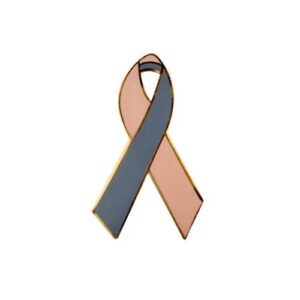

- Clergy Sexual Abuse: Sexual abuse happens when someone in a ministerial role (clergy, religious or lay) engages in sexual contact or sexualized behavior with a congregant, employee, student or counseling client in the ministerial relationship. The alternate color for Clergy Sexual Abuse is gold.
Pearl Awareness Ribbons: Colors and causes symbolize, stand for and support:
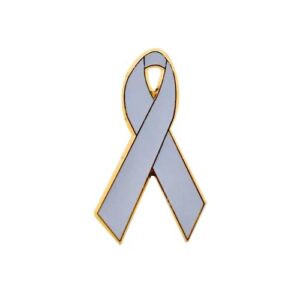

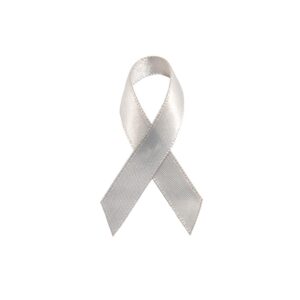


- Bronchial Adenoma, Adult: Bronchial Adenoma is a rare type of cancer that starts in the mucous glands and ducts of the lung airways (bronchi) or windpipe (trachea), and in the salivary glands. Although the word adenoma means a noncancerous tumor, most Bronchial Adenomas are cancer and can spread to other parts of the body.
- Bronchial Adenoma, Childhood: Bronchial Adenoma is rare in children, but it is the most common primary lung tumor. The alternate color for Bronchial Adenoma in children is gold.
- Bronchial Cancer: Bronchial Adenoma is a rare type of cancer that starts in the mucous glands and ducts of the lung airways (bronchi) or windpipe (trachea), and in the salivary glands. Although the word adenoma means a noncancerous tumor, most Bronchial Adenomas are cancer and can spread to other parts of the body. The alternate color for Bronchial Cancer is white.
- Bronchial Tumors, Adult: Most of the tumors that form in the trachea and bronchi in adults are cancerous, but a few are noncancerous. Squamous Cell Carcinoma, which usually arises in the lower part of the trachea, is the most common type of malignant Tracheal Tumor.
- Bronchial Tumors, Childhood: Tracheobronchial Tumors begin in the cells that line the surface of the lung. Most Tracheobronchial Tumors in children are benign and occur in the trachea or large airways of the lung. Sometimes, a slow-growing Tracheobronchial Tumor becomes cancer that may spread to other parts of the body. The alternate colors for Bronchial Tumors in childhood is white or gold.
- Bronchiectasis: Bronchiectasis is a chronic condition that causes the walls of the bronchi to thicken from inflammation and infection. People with Bronchiectasis have periodic flare-ups of breathing difficulties, called exacerbations. The alternate colors for Bronchiectasis are white or blue.
- Bronchogenic Carcinoma, Adult: Cancer that begins in the tissue that lines or covers the airways of the lungs, including Small Cell and Non-Small Cell Lung Cancer. The alternate color for Bronchogenic Carcinoma is white.
- Bronchogenic Carcinoma, Childhood: Pleuropulmonary Blastoma is a type of childhood lung cancer that forms in the tissues of the lung and pleura or the organs between the lungs. The alternate colors for Bronchogenic Carcinoma in childhood is gold or white.
- Interstitial Lung Disease: Interstitial lung disease is a chronic condition that refers to a group of diseases that cause inflammation, irritation, or scarring in the lungs and air sacs. The alternate color for Interstitial Lung Disease is white.
- Lung Cancer (Non-Small Cell and Small Cell Lung Cancer): Lung Cancer begins in the lungs and may spread to lymph nodes or other organs in the body. Lung cancers usually are grouped into two main types called Small Cell and Non-Small Cell. These types of lung cancer grow differently and are treated differently. Non-Small Cell Lung Cancer is more common than Small Cell Lung Cancer.
- Lung Cancer, Adult: Lung Cancer often has no symptoms until it has spread (metastasized). This is because there are few specialized nerves (pain receptors) in the lungs. When symptoms do occur, they vary depending on the type of lung cancer and location and size of the tumor. A series of tests are necessary to diagnose lung cancer. Further testing can identify the type and stage of cancer, which help determine treatment options.
- Lung Cancer, Childhood: In children, the most common lung tumors are Tracheobronchial Tumors and Pleuropulmonary Blastoma. Tracheobronchial Tumors begin in the cells that line the surface of the lung. Most Tracheobronchial Tumors in children are benign and occur in the trachea or large airways of the lung. Sometimes, a slow-growing Tracheobronchial Tumor becomes cancer that may spread to other parts of the body. Pleuropulmonary Blastomas form in the tissue of the lung and pleura. The alternate color for lung cancer in children is gold.
- Lung Disease: The term lung disease refers to many disorders affecting the lungs, such as asthma, COPD, infections like influenza, pneumonia and tuberculosis, lung cancer, and many other breathing problems. Some lung diseases can lead to respiratory failure.
- Mesothelioma, Adult: Mesothelioma is an aggressive cancer that affects the lining of the lungs, heart, or abdomen. Caused by the inhalation of asbestos fibers, mesothelioma is often diagnosed in older individuals who worked with asbestos products.
- Mesothelioma, Childhood: Mesothelioma is a rare cancer most diagnosed in people in their 60s and 70s, but doctors have reported roughly 300 cases worldwide in young adults, children and even infants. In most cases of Mesothelioma diagnosed in childhood, there is no history of exposure to asbestos, which is a much more common cancer among adults. The alternate color for Mesothelioma in children is gold.
- Non-Small Cell Lung Cancer: Non-Small Cell Lung Cancer is a disease in which malignant (cancer) cells form in the tissues of the lungs. Lung Cancer includes two main types: Non-Small Cell Lung Cancer and Small Cell Lung Cancer. Smoking causes most lung cancers, but nonsmokers can also develop lung cancer.
- Small Cell Lung Cancer: Lung Cancer includes two main types: Non-Small Cell Lung Cancer and Small Cell Lung Cancer. The types of Small Cell Lung Cancer are named for the kinds of cells found in the cancer and how the cells look when viewed under a microscope.
- Waldenstrom Macroglobulinemia: Waldenstrom Macroglobulinemia is a rare type of cancer that begins in the white blood cells. With Waldenstrom Macroglobulinemia, the bone marrow produces too many abnormal white blood cells that crowd out healthy blood cells. The abnormal white blood cells produce a protein that accumulates in the blood, impairs circulation and causes complications. Waldenstrom Macroglobulinemia is considered a type of Non-Hodgkin's Lymphoma. It is sometimes called Lymphoplasmacytic Lymphoma.
Pearl and White Awareness Ribbons: Colors and causes symbolize, stand for and support:
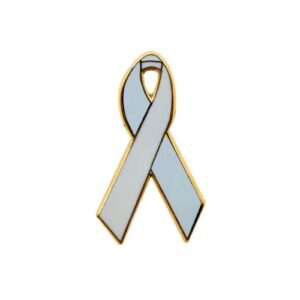

- Lung Cancer Acquired in Ways Other Than Smoking: While cigarette smoking is an undisputed cause of lung cancer, not all cases of lung cancer occur in smokers or former smokers. Each year, over 170,000 Americans develop lung cancer, and approximately 10% of lung cancers, or 17,000 cases, occur in non-smokers. Although not every non-smoker suffering from lung cancer will have an identifiable risk factor for development of the disease, other conditions and circumstances have been identified that will increase a non-smoker's chance of developing lung cancer. These include passive smoking, radon gas, exposure to asbestos, hereditary factors, and air pollution.
- Passive Smoking: When others breathe in secondhand smoke, or passive smoking, it is not just unpleasant for them, it can damage their health too. People who regularly breathe in secondhand smoke are more likely to get the same diseases as smokers, including lung cancer and heart disease.
- Secondhand Smoke: Secondhand Smoke exposure occurs when people who do not smoke breathe in smoke exhaled by people who smoke or from burning tobacco products. Since the 1964 Surgeon General's Report, 2.5 million adults who do not smoke have died from health problems caused by secondhand smoke exposure.
Periwinkle Blue Awareness Ribbons: Colors and causes symbolize, stand for and support:
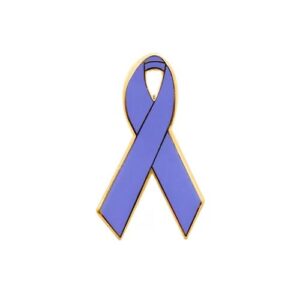
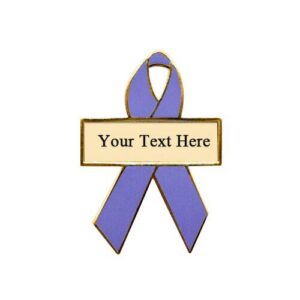


- Anorexia Nervosa: Anorexia Nervosa is an eating disorder characterized by weight loss (or lack of appropriate weight gain in growing children); difficulties maintaining an appropriate body weight for height, age, and stature; and, in many individuals, distorted body image. People with anorexia generally restrict the number of calories and the types of food they eat. Some people with the disorder also exercise compulsively, purge via vomiting and laxatives, and/or binge eat.
- Binge Eating Disorders: Binge Eating Disorder is an eating disorder characterized by frequent and recurrent binge eating episodes with associated negative psychological and social problems, but without the compensatory behaviors common to Bulimia Nervosa, OSFED, or the Binge-Purge Subtype of Anorexia Nervosa. The alternate color for Binge Eating Disorders is purple.
- Duodenal Cancer: Duodenal Cancer is a mass of irregular, fast-growing cells (tumor) in the first portion of the small intestine. This tumor may prevent the intestine from properly digesting food and block food from passing through the intestines. In early stages, Duodenal Cancer may present with no symptoms.
- Duodenal Stenosis: Duodenal Atresia or Stenosis occurs when the intestine does not develop normally and leads to a blockage in the continuity of the intestine. The incidence of duodenal atresia or stenosis in infants occurs in 1 in 6,000 births and is seen more frequently in infants with Down's syndrome or Trisomy 21.
- Esophageal Cancer, Adult: Esophageal Cancer is cancer that forms in tissues lining the esophagus. Two types of Esophageal Cancer are Squamous Cell Carcinoma (cancer that begins in flat cells lining the esophagus) and Adenocarcinoma (cancer that begins in cells that make and release mucus and other fluids).
- Esophageal Cancer, Childhood: Esophageal Cancer is a disease in which malignant cells form in the tissues of the esophagus. Most Esophageal Tumors in children begin in the thin, flat cells that line the esophagus. The alternate color for Esophageal Cancer in children is gold.
- Gastric Cancer (Stomach Cancer), Adult: Gastric Cancer, also called Stomach Cancer, is a malignant tumor of the stomach. Gastric Cancer can develop in any part of the stomach and can spread from the stomach to other organs.
- Gastric Cancer (Stomach Cancer), Childhood: Gastric (stomach) Cancer occurs when cancer cells form in the lining of the stomach. The alternate color for Gastric (Stomach) Cancer in children is gold.
- Gastroesophageal Reflux Disease / GERD: Gastroesophageal Reflux Disease (GERD) occurs when stomach acid repeatedly flows back into the tube connecting your mouth and stomach (esophagus). This backwash (acid reflux) can irritate the lining of the esophagus. Many people experience acid reflux from time to time.
- Irritable Bowel Syndrome (IBS): Irritable Bowel Syndrome, or IBS, or Spastic Colon, is a type of gastrointestinal disorder. There are different forms of this functional disease. IBS with diarrhea (IBS-D) is characterized by chronic or recurrent diarrhea, while IBS with constipation (IBS-C) is characterized by abdominal pain or discomfort associated with constipation. Some people experience alternating symptoms of diarrhea or constipation.
- Pulmonary Hypertension: Pulmonary Hypertension is a type of high blood pressure that affects the arteries in the lungs and the right side of the heart. In one form of Pulmonary Hypertension, tiny arteries in the lungs, called pulmonary arterioles, and capillaries become narrowed, blocked or destroyed. This makes it harder for blood to flow through the lungs and raises pressure within the lungs' arteries. As the pressure builds, the heart's lower right chamber (right ventricle) must work harder to pump blood through the lungs, eventually causing the heart muscle to weaken and fail. Some forms of pulmonary hypertension are serious conditions that become progressively worse and sometimes fatal. The alternate color for Pulmonary Hypertension is purple.
- Small Intestine Cancer: Small Intestine Cancer starts when cells in the small intestine start to grow out of control. The small intestine is part of the gastrointestinal (GI) tract, also known as the digestive tract. The GI tract processes food for energy and rids your body of solid waste. Although the small intestine makes up the largest part of the GI tract, small intestine cancers are much less common than most other types of GI cancers (such as colon, rectal, stomach, and esophagus cancers) in the United States.
- Stomach Cancer / Gastric Cancer, Adult: Stomach Cancer occurs when cancer cells form in the lining of the stomach. Risk factors include smoking, infection with H. pylori bacteria, and certain inherited conditions. Gastric cancer begins in the cells lining the mucosal layer and spreads through the outer layers as it grows.
- Stomach Cancer / Gastric Cancer, Childhood: Stomach Cancer is a disease in which malignant (cancer) cells form in the lining of the stomach. The alternate color for Stomach (Gastric) Cancer in children is gold.
- Tracheoesophageal Fistula: A Tracheoesophageal Fistula (TEF) is an abnormal connection between the esophagus and trachea. The condition is often congenital, which means it happened during fetal development. TEF may also be acquired in adulthood due to cancer, infection or trauma. Treatment involves surgery to close the fistula.
Pink Awareness Ribbons: Colors and causes symbolize, stand for and support:
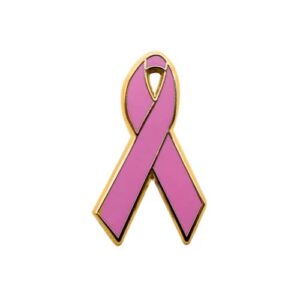





- Breast Cancer, Adult: Breast Cancer starts when cells in the breast begin to grow out of control. These cells usually form a tumor that can often be seen on an x-ray or felt as a lump. The tumor is malignant (cancer) if the cells can grow into (invade) surrounding tissues or spread (metastasize) to distant areas of the body. Breast cancer occurs almost often in women, but men can get breast cancer, too.
- Breast Cancer, Childhood: Breast Cancer is a disease in which malignant (cancer) cells form in the tissues of the breast. Breast cancer may occur in both male and female children. Breast cancer is the most common cancer among females aged 15 to 39 years. Breast cancer in this age group is more aggressive and more difficult to treat than in older women. Most breast tumors in children are fibroadenomas, which are benign (not cancer). Rarely, these tumors become large Phyllodes Tumors (cancer) and begin to grow quickly. The alternate color for Breast Cancer in children is gold.
- Ductal Carcinoma in Situ: Ductal Carcinoma in Situ is non-invasive breast cancer. Ductal means that the cancer starts inside the milk ducts, carcinoma refers to any cancer that begins in the skin or other tissues (including breast tissue) that cover or line the internal organs, and in situ means "in its original place." Ductal Carcinoma in Situ is called non-invasive because it has not spread beyond the milk duct into any normal surrounding breast tissue.
- Metastatic Breast Cancer: Metastatic Breast Cancer (also called stage IV) is breast cancer that has spread to another part of the body, most commonly the liver, brain, bones, or lungs.
- Paget's Disease of the Breast: Paget's Disease of the Breast (also known as Paget's Disease of the Nipple and Mammary Paget Disease) is a rare type of cancer involving the skin of the nipple and, usually, the darker circle of skin around it, which is called the areola. Most people with Paget Disease of the breast also have one or more tumors inside the same breast. These breast tumors are either Ductal Carcinoma in Situ or invasive breast cancer.
- Women's Health: Women's health refers to the branch of medicine that focuses on the treatment and diagnosis of diseases and conditions that affect a woman's physical and emotional well-being.
Pink and Blue Awareness Ribbons: Colors and causes symbolize, stand for and support:
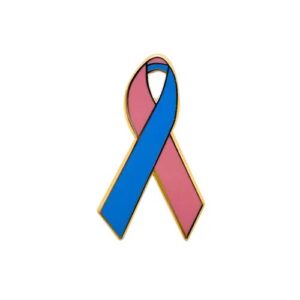

- Amniotic Fluid Embolism: Amniotic Fluid Embolism is a rare but serious condition that occurs when amniotic fluid, the fluid that surrounds a baby in the uterus during pregnancy or fetal material such as fetal cells, enters the mother's bloodstream.
- Apnea, Infantile: Apnea is a pause in breathing that lasts 20 seconds or longer for full-term infants. Most infants outgrow this problem by the time they are a year old.
- Baby or Infant Sleeping Suffocation: Bed-sharing increases a baby's risk of dying from SIDS, especially in preterm infants (preemies), babies who had a low birth weight, and healthy full-term infants younger than four months old. Other things that increase this risk of death while bed-sharing include a baby sleeping on a couch alone or with a parent.
- Baby Safe Haven: Safe Haven Infant Protection Laws enable a person to give up an unwanted infant anonymously. As long as the baby has not been abused, the person may do so without fear of arrest or prosecution. The purpose of Safe Haven is to protect unwanted babies from being hurt or killed because they were abandoned. Abandoning a baby puts the child in extreme danger. Too often, it results in the child’s death. It is also illegal, with severe consequences. But with Baby Safe Haven, this tragedy does not ever have to happen again.
- Birth Defects: A birth defect is a problem that happens while a baby is developing in the mother's body. Most birth defects happen during the first three months of pregnancy. One out of every 33 babies in the United States is born with a birth defect.
- Breast Cancer, Male: Male Breast Cancer is a rare cancer that forms in the breast tissue of men. Though Breast Cancer is most thought of as a disease that affects women, breast cancer does occur in men. Male breast cancer is most common in older men, though it can occur at any age. A history of breast cancer in a close male relative (father, brother or uncle) increases a woman's risk of breast cancer.
- Genital Integrity: The primary goals of advocating for genital integrity are protecting human rights and advocating for those who feel they have been violated. The genital integrity movement may someday enable humans to see themselves better, and to see how certain perceptions of "male" and "female” directly lead to forced genital cutting. In nearly every case of forced genital cutting – male, female, and intersex – a child or adolescent is forced by an adult to endure an alteration of his or her body. For example, intersex babies born with "ambiguous genitalia" are not unhealthy; they merely do not conform to cultural definitions of male or female genital norms.
- Hyperemesis Gravidarum: Hyperemesis Gravidarum is a condition characterized by severe nausea, vomiting, weight loss, and electrolyte disturbance. Most pregnant women experience some type of morning sickness (70 – 80%). Recent studies show that at least 60,000 cases of extreme morning sickness called Hyperemesis Gravidarum are reported by those who treated in a hospital. However, the numbers may be much higher than this since many women are treated at home or by outpatient care with their health care provider. The alternate color for Hyperemesis Gravidarum is teal and purple.
- In Memory of an Infant / Baby / Child
- Infant Diseases: Childhood diseases and disorders are described as an illness, impairment, or abnormal condition that primarily affects infants and children. This includes those in the age span that begins with the fetus and extends through adolescence.
- Infertility: Infertility means not being able to become pregnant after a year of trying. If a woman can get pregnant but keeps having miscarriages or stillbirths, that's also called infertility. After one year of having unprotected sex, about 15% of couples are unable to get pregnant. About a third of the time, infertility can be traced to the woman. In another third of cases, it is because of the man. The rest of the time, it is because of both partners or no cause can be found. The alternate color for Infertility is orange.
- Male Breast Cancer: Male Breast Cancer is a rare cancer that begins as a growth of cells in the breast tissue of men. Breast cancer is typically thought of as a condition that happens in women. But everyone is born with some breast tissue. So, anyone can get breast cancer. Male breast cancer is rare. It happens most often in older men, though it can occur at any age. Treatment for male breast cancer typically involves surgery to remove the breast tissue. Other treatments, such as chemotherapy and radiation therapy, may be recommended as well.
- Miscarriage: Miscarriage is the spontaneous loss of a pregnancy before twenty weeks. About 10-20% of known pregnancies end in miscarriage. But the actual number is likely higher because many miscarriages occur so early in pregnancy that a woman does not realize she is pregnant.
- Mourning the Loss of an Infant / Mourning the Loss of a Baby: In the United States, a miscarriage is usually defined as the loss of a baby before the 20th week of pregnancy. Stillbirth is further classified as early, late, or term: Early is the loss of a baby between 20 and 27 weeks of pregnancy. Late is the loss of a baby between 28 and 36 weeks of pregnancy.
- Pro-Life: Pro-Life is defined as opposed to legalized abortion or right-to-life.
- Prostate and Breast Cancer (Combined): A history of prostate cancer in one or more first-degree relatives (father or brother) may also increase a woman's risk of breast cancer, especially if the prostate cancer was found at a young age.
- Pyloric Stenosis: Pyloric Stenosis is an uncommon condition in infants that blocks food from entering the small intestine. Normally, a muscular valve (pylorus) between the stomach and small intestine holds food in the stomach until it is ready for the next stage in the digestive process.
- Stillbirth: A stillbirth is the death or loss of a baby before or during delivery. Both miscarriage and stillbirth describe pregnancy loss, but they differ according to when the loss occurs. In the United States, a miscarriage is usually defined as loss of a baby before the 20th week of pregnancy, and a stillbirth is loss of a baby after 20 weeks of pregnancy.
- Sudden Infant Death Syndrome / SIDS: Sudden Infant Death Syndrome (SIDS) is the unexplained death, usually during sleep, of a seemingly healthy baby less than a year old. SIDS is sometimes known as crib death or cot death because the infants often die in their cribs. Although the cause is unknown, it appears that SIDS might be associated with defects in the portion of an infant's brain that controls breathing and arousal from sleep.
- Twin-Twin Transfusion Syndrome: In twin-twin transfusion syndrome, there is an unequal sharing of blood that passes between twins through blood vessel connections on the surface of the placenta. One twin (called the donor twin) pumps blood to the other twin (called the recipient). This causes the recipient twin to receive too much blood and the donor twin to receive too little.
Pink and Gold Awareness Ribbons: Colors and causes symbolize, stand for and support:
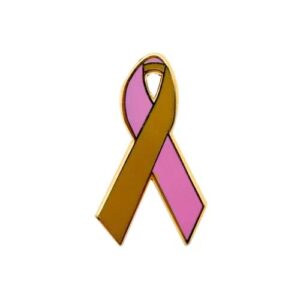

- Phyllodes Tumor: Phyllodes Tumors of the breast are rare, accounting for less than 1% of all breast tumors. The name "phyllodes," which is taken from the Greek language and means "leaflike," refers to that fact that the tumor cells grow in a leaflike pattern. Other names for these tumors are Phylloides Tumor and Cystosarcoma Phyllodes. Phyllodes Tumors tend to grow quickly, but they rarely spread outside the breast. Although most Phyllodes Tumors are benign (not cancerous), some are malignant (cancerous) and some are borderline (in between noncancerous and cancerous). All three kinds of Phyllodes Tumors tend to grow quickly, and they require surgery to reduce the risk of a Phyllodes Tumor coming back in the breast (local recurrence). Phyllodes Tumors can occur at any age, but they tend to develop when a woman is in her 40s. Benign Phyllodes Tumors are usually diagnosed at a younger age than malignant Phyllodes Tumors. Phyllodes Tumors are extremely rare in men.
Pink and Red Awareness Ribbons: Colors and causes symbolize, stand for and support:
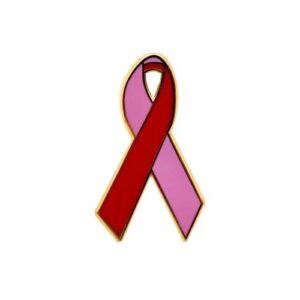

- Gum Disease: In its early stage, called gingivitis, the gums can become swollen and red, and they may bleed. In its more serious form, called periodontitis, the gums can pull away from the tooth, bone can be lost, and the teeth may loosen or even fall out. Periodontal disease is mostly seen in adults.
Pink and Teal Awareness Ribbons: Colors and causes symbolize, stand for and support:
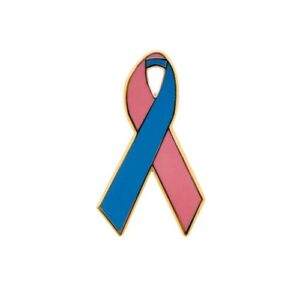

- BRCA1/2 (BReast CAncer Genes 1 and 2): BRCA1 and BRCA2 (BReast CAncer genes 1 and 2) are the best-known genes linked to breast cancer risk. Everyone has these genes, but some people have an inherited mutation in one or both that increases the risk of breast cancer. BRCA1/2 mutations can be passed from either parent and can affect the risk of cancers in both women and men. A person who has a BRCA1/2 mutation is sometimes called a BRCA1/2 carrier. Like other gene mutations, BRCA1/2 mutations are rare in the general population. In the U.S., about 1 in 400 people have a BRCA1/2 mutation. However, prevalence varies by ethnic group. Among Ashkenazi Jewish women and men, about 1 in 40 carry a BRCA1/2 mutation.
- Hereditary Breast and Ovarian Cancer: Hereditary Breast and Ovarian Cancer is an inherited genetic condition. This means that the cancer risk is passed from generation to generation in a family. Two genes are associated with the majority of HBOC families: BRCA1 and BRCA2. BRCA stands for BReast CAncer. Other, less common genes have also been associated with an increased risk of developing breast and other cancers. Men with these gene mutations also have an increased risk of Breast Cancer and Prostate Cancer. Not all families with multiple cases of Breast and Ovarian Cancer have mutations in BRCA1 or BRCA2.
- Hereditary Breast Cancer: A small percentage of all breast cancers cluster in families. These cancers are described as hereditary and are associated with inherited gene mutations. Hereditary Breast Cancers tend to develop earlier in life than non-inherited (sporadic) cases, and new (primary) tumors are more likely to develop in both breasts.
- Ovarian and Breast Cancer Combined: There is a genetic link between the ovaries and the breasts. The ovaries and breasts are also connected through a genetic component. Most notably, researchers have established that BRCA1 and BRCA2 gene mutations can increase the risk of both breast cancer and ovarian cancer.
Purple Awareness Ribbons: Colors and causes symbolize, stand for and support:
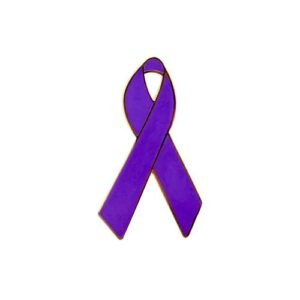

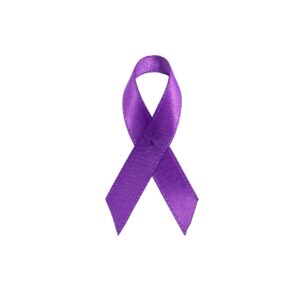
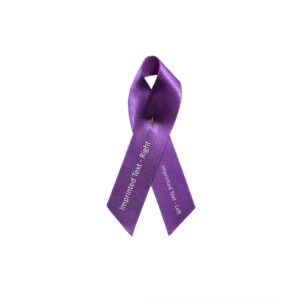


- Aicardi Syndrome: Aicardi Syndrome is a rare neurological disorder. The severity of the syndrome and the associated signs and symptoms vary from person to person. The three main features of Aicardi Syndrome are: Complete or partial absence of the nerve tissue that allows the right and left sides of the brain to communicate (corpus callosum); Seizures beginning in infancy (infantile spasms), that may become hard to control (refractory epilepsy); Defects or holes in the light sensitive tissue at the back of the eye (retina) known as chorioretinal lacunae.
- ALAD Porphyria: ALAD porphyria is a very rare genetic metabolic disease characterized by almost complete deficiency of the enzyme delta-aminolaevulinic acid (ALA) dehydratase.
- Alpha-1 Antitrypsin Deficiency: Alpha-1 Antitrypsin Deficiency is an inherited disorder that may cause lung disease and liver disease. The signs and symptoms of the condition and the age at which they appear vary among individuals.
- Alternating Hemiplegia of Childhood: Alternating hemiplegia of childhood is a neurological condition characterized by recurrent episodes of temporary paralysis, often affecting one side of the body (hemiplegia). During some episodes, the paralysis alternates from one side of the body to the other or affects both sides at the same time.
- Alzheimer's Disease: Alzheimer’s Disease is an irreversible, progressive brain disorder that slowly destroys memory and thinking skills and, eventually, the ability to carry out the simplest tasks. In most people with the disease, those with the late-onset type, symptoms first appear in their mid-60s. Early-onset Alzheimer’s occurs between a person’s 30s and mid-60s and is very rare. Alzheimer’s Disease is the most common cause of dementia among older adults.
- Arnold Chiari Malformation: Chiari Malformation is a condition in which brain tissue extends into the spinal canal. It occurs when part of the skull is misshapen or smaller than is typical, pressing on the brain and forcing it downward.
- Asherman's Syndrome: Asherman's Syndrome (intrauterine adhesions or intrauterine synechiae) occurs when scar tissue forms inside the uterus and/or the cervix. These adhesions occur after surgery of the uterus or after a dilatation and curettage with tuberculosis and schistosomiasis being a less common cause.
- Autoimmune Enteropathy: Autoimmune Enteropathy is a rare disorder in which the immune system causes damage to the lining of the intestines. Symptoms can occur shortly after birth with poor growth as well as severe and long-lasting diarrhea.
- Autoimmune Inner Ear Disease: Autoimmune Inner Ear Disease is an inflammatory condition of the inner ear. It occurs when the body's immune system attacks cells in the inner ear that are mistaken for a virus or bacteria. Autoimmune Inner Ear Disease is a rare disease occurring in less than one percent of the 28 million Americans with a hearing loss.
- Autoimmune Lymphoproliferative Syndrome: Autoimmune Lymphoproliferative Syndrome is a rare genetic disorder of the immune system first described by NIH scientists in the mid-1990s that affects both children and adults. In Autoimmune Lymphoproliferative Syndrome, unusually high numbers of white blood cells called lymphocytes accumulate in the lymph nodes, liver, and spleen and can lead to enlargement of these organs. Autoimmune Lymphoproliferative Syndrome can also cause anemia (low level of red blood cells), thrombocytopenia (low level of platelets), and neutropenia (low level of neutrophils, the most common type of white blood cell in humans). These problems can increase the risk of infection and hemorrhage.
- Autoimmune Neutropenia: Autoimmune Neutropenia is described as a reduced number of neutrophils resulting from increased peripheral destruction by antineutrophil antibodies from autoimmune disorders.
- Autoimmune Oophoritis: Autoimmune Oophoritis is a rare cause of primary ovarian insufficiency. It happens when the body's immune system mistakenly attacks the ovaries causing inflammation, atrophy and fibrosis. These changes stop the ovaries from working normally.
- Autoimmune Orchitis: Autoimmune Orchitis is a relevant cause of decreased fecundity in males, and it is defined as a direct aggression to the testis with the concomitant presence of anti-sperm antibodies (ASA). The presence of these specific antibodies has been observed in approximately 5-12% of infertile male partners.
- Autoimmune Pancreatitis: Autoimmune Pancreatitis is a chronic inflammation that is thought to be caused by the body's immune system attacking the pancreas and that responds to steroid therapy.
- Autoimmune Polyendocrine Syndrome: Autoimmune Polyendocrine Syndrome is a rare, inherited disease in which the immune system mistakenly attacks many of the body's tissues and organs. The mucous membranes and adrenal and parathyroid glands are commonly affected, though other tissues and organs may become involved as well.
- Autoimmune Retinopathy: Autoimmune Retinopathy is a rare and still poorly understood immune-mediated disease that may cause inflammation from circulating autoantibodies against the retina. It may be related to a history of autoimmune disease in the patient or in a family member or the presence of neoplastic disease in the individual.
- Autoimmune Thrombocytopenic Purpura / ATP: Immune Thrombocytopenic Purpura is a blood disorder characterized by a decrease in the number of platelets in the blood. Platelets are cells in the blood that help stop bleeding. A decrease in platelets can cause easy bruising, bleeding gums, and internal bleeding.
- Autoimmune Thyroiditis: Thyroiditis occurs when the thyroid gland becomes irritated. Hashimoto's Thyroiditis is the most common type of this health problem. It is an autoimmune disease. It occurs when the body makes antibodies that attack the cells in the thyroid. The thyroid then can't make enough of the thyroid hormone. The alternate color for Autoimmune Thyroiditis is paisley.
- Autoimmune Urticaria: Chronic Autoimmune Urticaria is caused by anti-FcεRI and less frequently, by anti-IgE autoantibodies that lead to mast cell and basophil activation, thereby giving rise to the release of histamine and other pro-inflammatory mediators.
- Autoimmune Uveitis: Uveitis often happens in people who have an autoimmune condition. An autoimmune condition is when the immune system mistakenly attacks healthy tissue. Autoimmune conditions known to cause uveitis include Ankylosing Spondylitis, a condition where the spine and other areas of the body become inflamed.
- Back Pain: Back pain is one of the most common reasons people seek medical help or miss work. Back pain is a leading cause of disability worldwide. Fortunately, measures can help prevent or relieve most back pain episodes, especially for people younger than age 60. If prevention fails, simple home treatment and using the body correctly often can heal the back within a few weeks. The alternate color for Back Pain is black.
- Body Shaming: Body Shaming occurs among both men and women of all different shapes and body sizes. Body Shaming has included both criticisms of being “too fat” or “too skinny”, often picking on flaws that are completely irrelevant. Many magazines, social media platforms, and advertisements contribute to body shaming in ways that have started to normalize these damaging behaviors. Many TV shows and movies have fallen into this pattern as well, where the “fat” character is often the subject of criticism and comic relief. With the trending behaviors of celebrity fat shaming on social media, it is important to understand the potential consequences that may arise.
- Bulimia Nervosa: Bulimia Nervosa, commonly called Bulimia, is a serious, potentially life-threatening eating disorder. People with bulimia may secretly binge, eating large amounts of food with a loss of control over the eating, and then purge, trying to get rid of the extra calories in an unhealthy way. To get rid of calories and prevent weight gain, people with bulimia may use different methods. For example, people may regularly self-induce vomiting or misuse laxatives, weight-loss supplements, diuretics or enemas after bingeing. Or one may use other ways to eliminate calories and prevent weight gain, such as fasting, strict dieting or excessive exercise. The alternate color for Bulimia Nervosa is periwinkle blue.
- Cancer Survivors: The American Cancer Society uses the term Cancer Survivor to refer to anyone who has ever been diagnosed with cancer no matter where they are in the course of their disease. The alternate color for Cancer Survivors is periwinkle.
- Caregiver Appreciation: Currently, over one-third of the United States population is composed of caregivers and the numbers are rising. Family caregivers are the foundation of long-term care nationwide. November is recognized as National Caregiver Appreciation Month, a month-long tribute to recognize those individuals providing caregiving support to a family member or loved one.
- Cerebral Spinal Fluid Leak: Cerebral Spinal Fluid Leak results when the fluid around the brain (called cerebral spinal fluid) leaks through a hole through the skull bone. This fluid can either drain from the ear or the nose, depending on where the skull bone is damaged.
- Chiari Malformations: Chiari Malformations are structural defects in the cerebellum, the part of the brain that controls balance. When the indented bony space at the lower rear of the skull is smaller than normal, the cerebellum and brainstem can be pushed downward. The resulting pressure on the cerebellum can block the flow of cerebrospinal fluid (the liquid that surrounds and protects the brain and spinal cord) and can cause a range of symptoms including dizziness, muscle weakness, numbness, vision problems, headache, and problems with balance and coordination.
- Chronic and Intractable Pain: Intractable Pain is typically considered to be a severe form of Chronic Pain. But unlike chronic pain from arthritic knees or similar cause, intractable pain is not easily treated or relieved.
- Chronic Pain: Usually, pain is regarded as chronic when it lasts or recurs for more than 3 to 6 months. Chronic pain is a frequent condition, affecting an estimated 20% of people worldwide and accounting for 15% - 20% of physician visits.
- Chronic Pancreatitis: Chronic Pancreatitis is inflammation of the pancreas that does not heal or improve. Instead, it gets worse over time and leads to permanent damage. Chronic pancreatitis eventually impairs a patient’s ability to digest food and make pancreatic hormones. Industrialized countries have estimated an annual incidence rate of 5-12/100,000 people will develop chronic pancreatitis. The prevalence of chronic pancreatitis is 50/100,000 people. Chronic pancreatitis often develops in patients between the ages of 30 and 40 and is more common in men than women.
- Chronic Recurrent Multifocal Osteomyelitis: Chronic Recurrent Multifocal Osteomyelitis is a disease that causes pain and damage in bones due to inflammation. CRMO is a severe form of Chronic Nonbacterial Osteomyelitis. It may affect one or more bones. The alternate color for Chronic Recurrent Multifocal Osteomyelitis is blue.
- Chronic Vestibular Migraine: A Vestibular Migraine is a nervous system problem that causes repeated dizziness (or vertigo) in people who have a history of migraine symptoms. Unlike traditional migraines, one may not always have a headache. There are many names for this type of problem, which include Migraine-Associated Vertigo, Migrainous Vertigo, and Migraine-Related Vestibulopathy.
- Cluster Headache: A cluster headache is an uncommon type of headache. It is one-sided head pain that may involve tearing of the eyes, a droopy eyelid, and a stuffy nose. Attacks last from 15 minutes to 3 hours, occur daily or almost daily for weeks or months.
- Colitis: Colitis means inflammation of the colon. The colon, also known as the large intestine or large bowel, constitutes the last part of the digestive tract. The colon is a long, muscular tube that receives digested food from the small intestine. It removes water from the undigested food, stores the undigested food, and then eliminates it from the body through bowel movements.
- Cornelia de Lange Syndrome / CdLS: Cornelia de Lange Syndrome is a developmental disorder that affects many parts of the body. The severity of the condition and the associated signs and symptoms can vary widely, but may include distinctive facial characteristics, growth delays, intellectual disability and limb defects.
- Craniosynostosis: Craniosynostosis is a birth defect in which one or more of the fibrous joints between the bones of the baby's skull (cranial sutures) close prematurely (fuse), before the baby's brain is fully formed. Brain growth continues, giving the head a misshapen appearance. Craniosynostosis usually involves fusion of a single cranial suture but can involve more than one of the sutures in the baby's skull (complex craniosynostosis). In rare cases, craniosynostosis is caused by certain genetic syndromes (syndromic craniosynostosis).
- Creutzfeldt-Jakob Disease: Creutzfeldt-Jakob is a rare brain disorder that leads to dementia. It belongs to a group of human and animal diseases known as prion disorders. Symptoms of Creutzfeldt-Jakob Disease can be similar to those of Alzheimer's disease. The alternate color for Creutzfeldt-Jakob Disease is orange.
- Crohn's Disease: Crohn’s Disease causes inflammation in part of the digestive system. Crohn's disease can affect any part of it, but most often it affects the small intestine and colon. Crohn's disease and another disease, called Ulcerative Colitis, belong to a group of diseases known as Inflammatory Bowel Disease.
- Cystic Fibrosis: Cystic Fibrosis is an inherited disorder that causes severe damage to the lungs, digestive system and other organs in the body. Cystic Fibrosis affects the cells that produce mucus, sweat and digestive juices. These secreted fluids are normally thin and slippery. But in people with Cystic Fibrosis, a defective gene causes the secretions to become sticky and thick. Instead of acting as a lubricant, the secretions plug up tubes, ducts and passageways, especially in the lungs and pancreas.
- Dementia: Dementia is not a specific disease. Instead, dementia describes a group of symptoms affecting memory, thinking and social abilities severely enough to interfere with daily functioning. Though dementia generally involves memory loss, memory loss has different causes. So, memory loss alone does not mean one has dementia. Alzheimer's Disease is the most common cause of a progressive dementia in older adults, but there are a number of causes of dementia. Depending on the cause, some dementia symptoms can be reversed.
- Diabetic Neuropathy: Diabetic Neuropathy is a type of nerve damage that can occur if a person has diabetes. High blood sugar (glucose) can injure nerves throughout the body. Diabetic neuropathy most often damages nerves in the legs and feet. Depending on the affected nerves, symptoms of diabetic neuropathy can range from pain and numbness in the legs and feet to problems with the digestive system, urinary tract, blood vessels and heart. Some people have mild symptoms. But for others, diabetic neuropathy can be quite painful and disabling.
- Discoid Lupus Erythematosus: Discoid Lupus Erythematosus is a type of Cutaneous Lupus Erythematosus. Cutaneous refers to the skin. Cutaneous Lupus Erythematosus includes types of lupus that affect the skin. People with Discoid Lupus get round sores, usually on their face or scalp. Another name for Discoid Lupus is Chronic Cutaneous Lupus.
- Domestic Violence: Domestic Violence and emotional abuse are behaviors used by one person in a relationship to control the other. Partners may be married or not married; heterosexual, gay, or lesbian; living together, separated or dating. Violence can be criminal and includes physical assault (hitting, pushing, shoving, etc.), sexual abuse (unwanted or forced sexual activity), and stalking. Although emotional, psychological and financial abuse are not criminal behaviors, they are forms of abuse and can lead to criminal violence.
- Dravet Syndrome: Dravet Syndrome is a severe form of epilepsy that is part of a group of diseases known as SCN1A-Related Seizure Disorders. The condition appears during the first year of life as frequent fever-related seizures. As the condition progresses, other types of seizures typically occur, including Myoclonus and Status Epilepticus. A family history of either epilepsy or febrile seizures exists in 15 - 25% of cases. Intellectual development begins to deteriorate around age 2, and affected individuals often have a lack of coordination, poor development of language, hyperactivity, and difficulty relating to others.
- Drowning Impact: Drowning Impact Awareness Month began in August 2004. June, July, and August are peak times for child drownings. Back-to-school distractions in August make it a high-risk month for child drowning. Drowning is a top cause of injury-related death for children, especially the one-to-five-year-old age group. Every child drowning is preventable. Prevention is the cure, and awareness is free.
- Drug Overdose: Drug Overdoses can be accidental or intentional. They occur when a person takes more than a medically recommended dose of medication. However, some people may be more sensitive to certain medications, so the low (more dangerous) end of a drug may be toxic for them. This is a dose that is still within the range of acceptable medical use but may be too much for their bodies to handle. Illicit drugs, used to get high, may be taken in overdose amounts when a person's metabolism cannot detoxify the drug fast enough to avoid unintended side effects.
- Eating Disorders: Eating Disorders are serious conditions related to persistent eating behaviors that negatively impact one's health, emotions and ability to function in important areas of life. The most common eating disorders are Anorexia Nervosa, Bulimia Nervosa and Binge-Eating Disorder.
- Elder Abuse: Elder Abuse is an intentional act, or failure to act, by a caregiver or another person in a relationship involving an expectation of trust that causes or creates a risk of harm to an older adult. (An older adult is defined as someone age 60 or older.)
- Epilepsy: Epilepsy is a central nervous system disorder in which brain activity becomes abnormal, causing seizures or periods of unusual behavior, sensations, and sometimes loss of awareness. Seizure symptoms can vary widely. Some people with epilepsy simply stare blankly for a few seconds during a seizure, while others repeatedly twitch their arms or legs. Having a single seizure does not mean you have epilepsy. At least two unprovoked seizures are generally required for an epilepsy diagnosis.
- Fentanyl Overdose Awareness: On Wednesday, August 21, the Drug Enforcement Administration recognizes National Fentanyl Prevention and Awareness Day by joining the many voices dedicated to educating the public on the serious dangers of fentanyl poisoning from fake pills and other illicit drugs.
- Fibromyalgia: Fibromyalgia is a condition associated with widespread chronic pain, fatigue, memory problems and mood changes. Fibromyalgia is not a single disease, but a constellation of symptoms that can be managed. It is not life threatening and does not lead to muscle or joint damage. Researchers suspect that different factors, alone or in combination, may contribute to the development of the disease. An infectious illness, physical trauma, emotional trauma or hormonal changes may trigger the development of generalized pain, fatigue and sleep disturbances that characterize the condition.
- Gastrointestinal Stromal Tumors / GIST: Gastrointestinal Stromal Tumors may be malignant (cancer) or benign (not cancer). They are most common in the stomach and small intestine but may be found anywhere in or near the GI tract. Soft tissue sarcoma is a broad term for cancers that start in soft tissues (muscle, tendons, fat, lymph and blood vessels, and nerves). These cancers can develop anywhere in the body but are found mostly in the arms, legs, chest and abdomen.
- Glanzmann Thrombasthenia: Glanzmann thrombasthenia is a bleeding disorder that is characterized by prolonged or spontaneous bleeding starting from birth. People with Glanzmann thrombasthenia tend to bruise easily, have frequent nosebleeds (epistaxis), and may bleed from the gums. They may also develop red or purple spots on the skin caused by bleeding underneath the skin (petechiae) or swelling caused by bleeding within tissues (hematoma). Glanzmann thrombasthenia can also cause prolonged bleeding following injury, trauma, or surgery (including dental work). Women with this condition can have prolonged and sometimes abnormally heavy menstrual bleeding. Affected women also have an increased risk of excessive blood loss during pregnancy and childbirth.
- Headache: Headache is pain in any region of the head. Headaches may occur on one or both sides of the head, be isolated to a certain location, radiate across the head from one point, or have a viselike quality. A headache may appear as a sharp pain, a throbbing sensation or a dull ache.
- Hemicrania Continua: Hemicrania Continua is a type of primary headache disorder, which means the headache is not caused by another medical condition. Symptoms of Hemicrania Continua include constant mild to moderate pain on one side of the head (unilateral) with periods of more intense, severe, migraine-like pain (exacerbations). These severe pain periods can last from twenty minutes to days. The frequency of exacerbations also varies greatly. The headache stays on the same side of the head and usually without pain free periods.
- Hidradenitis Suppurativa: Hidradenitis suppurativa (HS) is a painful, long-term skin condition that causes skin abscesses and scarring on the skin. The exact cause of Hidradenitis Suppurativa is unknown, but it occurs near hair follicles where there are sweat glands, usually around the groin, bottom, breasts and armpits.
- Homeless College Students: Homelessness is a significant issue among college students, and many students may not disclose their situations due to shame or stigma. According to the 2023 National Postsecondary Student Aid Study (NPSAS), 8% of undergraduates and 5% of graduate students experience homelessness. However, other studies have found higher rates. The alternate color for Homeless College Students is green.
- Homelessness: The definition of homelessness is divided into four categories. These categories include: 1) literally homeless; 2) imminent risk of homelessness; 3) homeless under other Federal statues; and 4) fleeing/attempting to flee domestic violence.
- Hurler Syndrome: Hurler Syndrome is the most severe form of Mucopolysaccharidosis Type 1, a rare lysosomal storage disease, characterized by skeletal abnormalities, cognitive impairment, heart disease, respiratory problems, enlarged liver and spleen, characteristic facies and reduced life expectancy.
- Hurler-Scheie Syndrome: Hurler-Scheie Syndrome is the intermediate form of Mucopolysaccharidosis Type 1 between the two extremes Hurler Syndrome and Scheie Syndrome. It is a rare lysosomal storage disease, characterized by skeletal deformities and a delay in motor development.
- Idiopathic Thrombocytopenic Purpura / ITP: Idiopathic Thrombocytopenic Purpura (ITP) is a disorder that can lead to easy or excessive bruising and bleeding. The bleeding results from unusually low levels of platelets, the cells that help blood clot. Idiopathic Thrombocytopenic Purpura, which is also called Immune Thrombocytopenia, affects children and adults. Children often develop ITP after a viral infection and usually recover fully without treatment. In adults, the disorder is often long term.
- Infantile Spasms: Infantile Spasms is a rare seizure disorder that occurs in young children, usually under one year of age. About 1,200 children in the US are diagnosed each year with Infantile Spasms. It often has a very subtle appearance, so it is difficult for parents to recognize that it is a serious problem. A young child having Infantile Spasms may just have little head drops that do not appear to be anything serious. However, it is a much more serious seizure disorder than the generalized convulsion. Not only is it difficult for the parent to realize that this is a seizure disorder, but it is also challenging for pediatricians. Infantile Spasms are so uncommon that most pediatricians will see only one or two Infantile Spasm cases during all their years of practice.
- Inflammatory Bowel Disease / IBD: Inflammatory Bowel Disease is an umbrella term used to describe disorders that involve chronic inflammation of the digestive tract. Types of IBD include Ulcerative Colitis and Crohn's Disease. Both Ulcerative Colitis and Crohn's Disease usually involve severe diarrhea, abdominal pain, fatigue and weight loss.
- International Overdose Awareness Day: International Overdose Awareness Day (Overdose Day) is a global event held on August 31 each year since 2001. Its purpose is to raise awareness of overdoses, reduce the stigma of drug-related deaths and acknowledge the grief felt by families and friends.
- International Women's Day: International Women's Day (March 8) is a global day celebrating the social, economic, cultural and political achievements of women. The day also marks a call to action for accelerating gender parity. Internationally, purple is a color for symbolizing women.
- Keratoconus: Keratoconus is a condition of the eye in which the normally rounded cornea bulges outward into a cone shape. The cornea is the clear, central part of the front surface of the eye. It protects the eye and helps focus for clear vision.
- Leiomyosarcoma: Leiomyosarcoma is an aggressive tumor of smooth muscle origin and one of the most common subtypes of sarcoma. The retroperitoneum and uterus are most involved, and less often, the extremities and trunk.
- Lennox-Gastaut Syndrome: Lennox-Gastaut syndrome is a severe condition characterized by repeated seizures (epilepsy) that begin early in life. Affected individuals have multiple types of seizures, developmental delays, and particular patterns of brain activity measured by a test called an electroencephalogram (EEG).
- Leprosy: Leprosy, also known as Hansen's disease, is a chronic infectious disease caused by Mycobacterium leprae. The disease affects the skin, the peripheral nerves, mucosal surfaces of the upper respiratory tract and the eyes. Leprosy is known to occur at all ages ranging from early childhood to old age.
- Lewy Body Dementia: Lewy Body Dementia, also known as dementia with Lewy bodies, is the second most common type of progressive dementia after Alzheimer's Disease Dementia. Protein deposits, called Lewy bodies, develop in nerve cells in the brain regions involved in thinking, memory and movement (motor control). Lewy Body Dementia causes a progressive decline in mental abilities. People with Lewy Body Dementia may experience visual hallucinations, and changes in alertness and attention. Other effects include Parkinson's Disease-like symptoms such as rigid muscles, slow movement and tremors.
- Lupus / Systemic Lupus Erythematosus / SLE Lupus: Lupus is a chronic, autoimmune disease that affects various parts of the body, including joints, kidneys and other organs, skin, blood and even the brain. Symptoms can come on quickly or slowly. They can get worse for a while, then get better, which is called a flare. A common sign is a rash over the cheeks and nose in the shape of a butterfly. But not everyone gets the rash. Treatment for Systemic Lupus Erythematosus depends on symptoms. Medicines include pain relievers, medicines used to treat malaria, steroids, biologics and medicines that lower immune system responses.
- Lupus Nephritis: Lupus Nephritis occurs when lupus autoantibodies affect structures in the kidneys that filter out waste. This causes kidney inflammation and may lead to blood in the urine, protein in the urine, high blood pressure, impaired kidney function or even kidney failure.
- Lupus Vasculitis: The word vasculitis means inflammation of the blood vessels. Vasculitis can be a diagnosis but more often it coexists with lupus or another autoimmune disease and is then considered to be a component of that illness. Blood vessel inflammation is common to all the rheumatic autoimmune illnesses. When it occurs in a patient who has lupus, vasculitis may simply confirm a diagnosis for lupus but cause no specific additional health problems itself. Sometimes its occurrence represents a change in the course of the lupus, with vasculitis becoming a serious complication. The alternate color for Lupus Vasculitis is red and purple.
- Macular Degeneration: Macular Degeneration is the leading cause of vision loss, affecting more than 10 million Americans. This is more than cataracts and glaucoma combined. At present, Macular Degeneration is considered an incurable eye disease. Macular Degeneration is caused by the deterioration of the central portion of the retina, the inside back layer of the eye that records the images one sees and sends them via the optic nerve from the eye to the brain. The retina’s central portion, known as the macula, is responsible for focusing central vision in the eye, and it controls one's ability to read, drive a car, recognize faces or colors, and see objects in fine detail.
- Mast Cell Diseases: Mast cell diseases are rare conditions that occur when mast cells are abnormal or overly active. A mast cell is a type of white blood cell that is part of the immune system, primarily located in connective tissues throughout the body, and is known for its role in allergic reactions by releasing chemicals like histamine when activated by allergens. Mast cells essentially act as a first responder to potential threats like bacteria or parasites by triggering inflammatory responses.
- Microscopic Colitis: Microscopic Colitis is an inflammation of the large intestine (colon) that causes persistent watery diarrhea. The disorder gets its name from the fact that it's necessary to examine colon tissue under a microscope to identify it, since the tissue may appear normal with a colonoscopy or flexible sigmoidoscopy.
- Moebius Syndrome: Moebius Syndrome is a rare neurological condition that primarily affects the muscles that control facial expression and eye movement. The signs and symptoms of this condition are present from birth. Weakness or paralysis of the facial muscles is one of the most common features of Moebius Syndrome.
- Morquio Syndrome: Morquio Syndrome is a rare inherited birth defect that is estimated to occur in one of every 200,000 births. The disease may not be visible at birth. Symptoms usually begin between ages 1 and 3. Morquio Syndrome is a progressive disease. Morquio Syndrome is part of a group of diseases called mucopolysaccharidosis (MPS). Morquio is also known as MPS IV. In children with Morquio Syndrome, the body cannot break down sugar chains called glycosaminoglycans that help build bone, cartilage, eye corneas, skin and connective tissue.
- Mosaic Trisomy 9: Mosaic Trisomy 9 is a rare chromosomal disorder in which the entire 9th chromosome appears three times (trisomy) rather than twice in some cells of the body. The term “mosaic” indicates that some cells contain the extra chromosome 9, while others have the typical chromosomal pair. Mosaic trisomy 9 may be caused by errors during the division of a parent’s egg or sperm or during the division of body tissue cells (somatic cells) early in the development of the fetus.
- Mucopolysaccharidoses / MPS: Mucopolysaccharidoses are a group of metabolic disorders caused by the absence or malfunctioning of lysosomal enzymes needed to break down molecules called glycosaminoglycans. These long chains of sugar carbohydrates occur within the cells that help build bone, cartilage, tendons, corneas, skin and connective tissue.
- Multiple System Atrophy: Multiple System Atrophy is a progressive neurodegenerative disorder characterized by a combination of symptoms that affect both the autonomic nervous system (the part of the nervous system that controls involuntary action such as blood pressure or digestion) and movement.
- Myofascial Pain Syndrome: Myofascial Pain Syndrome is a chronic condition that causes pain in the musculoskeletal system. This pain is confined to a particular area. For example, you might only feel the pain and tenderness in your right shoulder and neck. The pain is typically associated with trigger points in muscles. These trigger points radiate pain to the affected area when pressure is applied to them, and sometimes spontaneously with no pressure. Sometimes this pain can be in what seems to be an unrelated part of the body.
- Myopathy, Congenital, Batten Turner Type: Beginning in childhood, people with this condition experience bouts of sustained muscle tensing (myotonia) that prevent muscles from relaxing normally. Although myotonia can affect any skeletal muscles, including muscles of the face and tongue, it occurs most often in the legs.
- Neonatal Lupus: Neonatal lupus is an autoimmune disease in which passive transfer of autoantibodies from the mother to the fetus results in fetal and neonatal disease. The major manifestations are cardiac and cutaneous findings.
- Neuropathy: Neuropathy is a form of nerve damage that is estimated to affect more than 20 million Americans. It often accompanies other health problems including diabetes, cancer, shingles, autoimmune disease or injury.
- Opioid Epidemic: The opioid epidemic goes back to the 1990s, with the release of OxyContin and mass marketing of prescription painkillers, as well as campaigns like "Pain as the Fifth Vital Sign" that pushed doctors to treat pain as a serious medical problem. Doctors subsequently prescribed opioids in droves, leading to a proliferation of pills that eventually ended up with not just patients but also teens rummaging through their parents' medicine cabinets, other family and friends of patients, and the black market. This contributed to the spread of opioid painkiller misuse and addiction, which over time also led to greater misuse of illicitly produced opioids like heroin and fentanyl. Drug overdose deaths have climbed every year since the late 1990s as a result. During the State of the Union address in 2018, lawmakers wore purple ribbons in an effort to raise awareness of the opioid epidemic.
- Pancreatic Cancer, Adult: Pancreatic cancer is a disease in which malignant cells are found in the tissues of the pancreas. Pancreatic Cancer is also called exocrine cancer.
- Pancreatic Cancer, Childhood: Pancreatic Cancer is a disease in which malignant (cancer) cells form in the tissues of the pancreas. Many kinds of tumors can form in the pancreas. Some tumors are benign (not cancer). There are four types of Pancreatic Cancer in children including: Solid Pseudopapillary tumor of the pancreas, Pancreatoblastoma, Islet Cell Tumors, and Pancreatic Carcinoma. The alternate color for Pancreatic Cancer in children is gold.
- Pancreatitis, Chronic: Pancreatitis is inflammation in the pancreas. It is usually temporary (acute) but can also be a life-long (chronic) condition. The most common symptom is abdominal pain. The most common causes are alcohol use and gallstones.
- Pediatric Hemiplegia: Infantile or Congenital Hemiplegia refers to brain injuries that occur before or at birth and lead to Hemiplegia. Juvenile Hemiplegia is seen in patients who sustained injuries above the age of one year. Hemiplegia is the physical manifestation of an injury to a specific area of the brain that controls motor function. The color for Pediatric Hemiplegia is purple and blue.
- Pediatric Rheumatic Diseases: Pediatric Rheumatic Diseases refer to a range of musculoskeletal, arthritic, and connective tissue disorders that can develop in childhood. These diseases can affect a child’s eyes, joints, skin, muscles and gastrointestinal tract. Although these autoimmune and inflammatory conditions share some common symptoms such as pain, heat and swelling, each also has specific symptoms. Rheumatic diseases can affect children of any age and any ethnic background. The color for Pediatric Rheumatic Diseases is purple and blue.
- Pediatric System Lupus Erythematosus / Pediatric SLE: Lupus is a chronic, autoimmune disease that affects various parts of the body, including joints, kidneys and other organs, skin, blood and even the brain. Children and teens with SLE may have fatigue, pain or swelling in joints, skin rashes, fevers, hair loss, mouth sores or skin color changes due to the cold (Raynaud's phenomenon). Fatigue is one of the most prominent and life-affecting symptoms. Joint pain, another prominent symptom, is what most commonly initiates the first doctor visit.
- Peripheral Neuropathy: Peripheral Neuropathy refers to the conditions that result when nerves that carry messages to and from the brain and spinal cord from and to the rest of the body are damaged or diseased. The peripheral nerves make up an intricate network that connects the brain and spinal cord to the muscles, skin, and internal organs. These include Bernard-Soulier Syndrome, Gray Platelet Syndrome, Platelet Dysfunction Disorders, Thrombocytosis or Thrombocythemia, and Von Willebrand Disease.
- Porphyria: Porphyria refers to a group of rare disorders that result from a buildup of natural chemicals called porphyrins in the body. Porphyrins are needed to make heme, a part of hemoglobin. Hemoglobin is a protein in red blood cells.
- Prematurity: A preterm, premature or “preemie” baby is a baby born too early, or about three weeks before their due date. A full-term pregnancy (fetal development) lasts about 40 weeks. Preterm birth occurs when a baby is born at 37 weeks or earlier. Premature or early birth can pose serious health risks to a newborn baby.
- Primary Craniosynostosis: Primary craniosynostosis is a general term for the improper development of the bones of the skull, which can result in an abnormal head shape in affected individuals. Craniosynostosis refers to the premature fusion of the fibrous joints (sutures) between certain bones of the skull. The severity of primary craniosynostosis can vary from one person to another.
- Progressive Myoclonus Epilepsy: Progressive myoclonus epilepsy (PME) is a rare group of inherited neurodegenerative diseases that cause neurological deterioration, myoclonus, and are resistant to treatment. The cause of PME depends on the type of PME but is usually caused by autosomal dominant or recessive and mitochondrial mutations.
- Pudendal Neuralgia: Pudendal Neuralgia is chronic pelvic pain caused by an irritated or damaged pudendal nerve. The pudendal nerve runs from the back of the pelvis to all the muscles and skin in the genital area, including your anus, vagina and penis. Treatment options include medication, physical therapy, lifestyle changes or surgery.
- Pulmonary Arterial Hypertension: Pulmonary Arterial Hypertension is one form of a broader condition known as pulmonary hypertension, which means high blood pressure in the lungs. In Pulmonary Arterial Hypertension, increased pressure in the vessels is caused by obstruction in the small arteries in the lung for a variety of reasons.
- Relay for Life: Relay for Life is a community based fundraising event of the American Cancer Society. Each year, more than 5,000 Relay for Life events take place in over twenty countries. Events are held in local communities, campus universities and in virtual worlds.
- Retinitis Pigmentosa: Retinitis Pigmentosa is a group of rare eye diseases that affect the retina (the light-sensitive layer of tissue in the back of the eye). Retinitis Pigmentosa makes cells in the retina break down slowly over time, causing vision loss. RP is a genetic disease that people are born with.
- Rett Syndrome: Rett Syndrome is a rare genetic neurological and developmental disorder that affects the way the brain develops, causing a progressive inability to use muscles for eye and body movements and speech. It occurs almost exclusively in girls. Most babies with Rett Syndrome seem to develop normally at first, but after about 6 months of age, they lose skills they previously had, such as the ability to crawl, walk, communicate or use their hands. Over time, children with Rett Syndrome have increasing problems with the use of muscles that control movement, coordination and communication. Rett Syndrome can also cause seizures and intellectual disability.
- Reye Syndrome: Reye's Syndrome is a serious condition that causes swelling in the liver and brain. It can occur at any age but usually affects children and teenagers after a viral infection, most commonly the flu or chickenpox. Reye's Syndrome is rare. The condition also is known as Reye Syndrome. Symptoms such as confusion, seizures and loss of consciousness need emergency treatment. Early diagnosis and treatment of Reye's Syndrome can save a child's life.
- Sanfilippo Syndrome: Sanfilippo Syndrome is a rare genetic condition that causes fatal brain damage. It is referred to as a childhood disease because most patients never reach adulthood. The lack of enzyme prevents the body from going through its natural recycling process, causing cellular malfunction. The disease has four subtypes (A, B, C and D). Each subtype corresponds to a specific deficient enzyme.
- Sarcoidosis: Sarcoidosis, also called Sarcoid, is an inflammatory disease marked by the formation of granulomas (small nodules of immune cells) in the lungs, lymph nodes, and other organs. Sarcoidosis may be acute and go away by itself, or it may be chronic and progressive.
- Scheie Syndrome: Scheie Syndrome is the mildest form of Mucopolysaccharidosis Type 1, a rare lysosomal storage disease, characterized by skeletal deformities and a delay in motor development.
- Schinzel-Giedion Syndrome: Schinzel-Giedion syndrome is a severe condition that is apparent at birth and affects many body systems. Signs and symptoms of this condition include distinctive facial features, neurological problems, and organ and bone abnormalities. Because of their serious health problems, most affected individuals do not survive past childhood.
- Seizure Disorders: A seizure is a sudden, uncontrolled burst of electrical activity in the brain. It can cause changes in behavior, movements, feelings and levels of consciousness. Having two or more seizures at least 24 hours apart that do not have a known cause is considered to be epilepsy. There are many types of seizures, and they have a range of symptoms and severity. Seizure types vary by where they begin in the brain and how far they spread. Most seizures last from 30 seconds to two minutes. A seizure that lasts longer than five minutes is a medical emergency. Seizures can happen after a stroke or a head injury. They also may be caused by an infection such as meningitis or another illness. Many times, though, the cause is unknown.
- Sjogren's Syndrome: Sjögren’s Syndrome is a chronic, autoimmune disease that causes dryness of the eyes, mouth and other body parts. In an autoimmune disease, the immune system mistakenly attacks healthy tissue, leading to inflammation in the body. In Sjögren’s Syndrome, the infection-fighting cells of the immune system (lymphocytes) attack the normal cells of glands that produce moisture in the eyes, mouth and other tissues. These are called exocrine glands. This action damages these glands, making them unable to produce moisture.
- Sly Syndrome: Sly Syndrome is a disorder of mucopolysaccharide metabolism characterized by short stature, coarsening of the facial features, clouding of the cornea, striking enlargement of the liver and spleen, skeletal abnormalities, and intellectual deterioration resulting in moderately severe mental retardation.
- Superior Mesenteric Artery Syndrome: Superior Mesenteric Artery Syndrome is a rare digestive system disorder. The superior mesenteric artery provides blood to the small intestine, cecum, and colon. It crosses over the first part of the small intestine, called the duodenum. Symptoms occur when the artery obstructs the duodenum. Superior mesenteric artery syndrome may be referred to at SMA Syndrome or as SMAS, and by a variety of other names including Cast Syndrome, Wilkie Syndrome, Arteriomesenteric Duodenal Obstruction, and Chronic Duodenal Ileus.
- Turner Syndrome: Turner Syndrome is a chromosomal condition that alters development in females. Women with this condition tend to be shorter than average and are usually unable to conceive a child (infertile) because of an absence of ovarian function.
- Ulcerative Colitis: Ulcerative Colitis is an inflammatory bowel disease that causes long-lasting inflammation and ulcers (sores) in the digestive tract. Ulcerative Colitis affects the innermost lining of the large intestine (colon) and rectum. Symptoms usually develop over time, rather than suddenly.
- Uveitis: Uveitis damages the part of the eye called the uvea, but it often affects other parts of the eye, too. Sometimes uveitis goes away quickly, but it can come back. And sometimes it’s a chronic (long-term) condition. It can affect one eye or both eyes.
- Victims of Homophobia: Hate crimes and incidents can range from insults to inciting others to hatred, serious physical assault and murder. Perpetrators of homophobic hate incidents are motivated by prejudice or hostility towards their victim’s actual or perceived lesbian, gay and bisexual (LGB) sexual orientation. Homophobic hate crimes and incidents occur commonly in the everyday lives of LGB people. Too many LGB people worry about being the victim of crime and feel at risk of being a victim of hate crime. Both the experience and fear of homophobic hate crimes and incidents have a dramatic impact on the quality of life of millions of LGB people.
- Vitiligo: Vitiligo is a disease that causes the loss of skin color in blotches. The extent and rate of color loss from vitiligo is unpredictable. It can affect the skin on any part of the body. It may also affect hair and the inside of the mouth. Normally, the color of hair and skin is determined by melanin. Vitiligo occurs when the cells that produce melanin die or stop functioning. Vitiligo affects people of all skin types, but it may be more noticeable in people with darker skin.
- Women's Rights: Women’s rights are human rights that all women have. But in practice, these rights are often not protected to the same extent as the rights of men. Among others, women’s rights include physical integrity rights, such as being free from violence and making choices over their own body; social rights, such as going to school and participating in public life; economic rights, such as owning property, working a job of their choice, and being paid equally for it; and political rights, such as voting for and holding public office. The protection of these rights allows women to live the lives they want and to thrive in them.
Purple and Black Awareness Ribbons: Colors and causes symbolize, stand for and support:
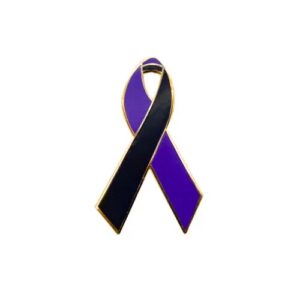

- Animal Loss Due to Animal Abuse: Animal abuse can take many forms: it includes not only obvious forms of abuse such as killing or physically hurting animals, but also includes keeping wild animals in captivity. It’s possible to abuse animals through our actions, as well through our lack of action. Cats and dogs linger in shelters and may be euthanized before ever finding homes;,many species of wildlife face hunting pressure from humans, and are increasingly affected by climate change; most animals in the food system are kept in crowded, filthy conditions, and are killed after only a fraction of their natural lifespans. These are just a few examples of what animal abuse is. The alternate color for Animal Loss Due to Animal Abuse is Animal Paw Prints.
- Fentanyl Abuse and Overdose Death: Spread the word to save a life. Illicit fentanyl is driving the recent increase in US drug overdose deaths. Deaths involving synthetic opioids other than methadone (primarily fentanyl) continued to rise with 56,516 overdose deaths reported in 2020.
Purple and Blue Awareness Ribbons: Colors and causes symbolize, stand up and support:
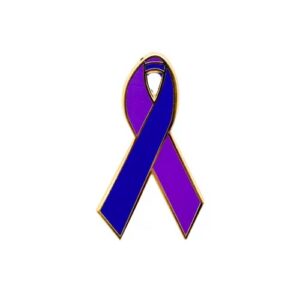

- Acute Motor Axonal Neuropathy: Acute Motor Axonal Neuropathy is a variant type of Guillain-Barre Syndrome. Acute Motor Axonal Neuropathy is a non-inflammatory disease whereby axons of motor nerve cells are selectively targeted and destroyed by the body's own immune system. The myelin sheath surrounding the axon is unaffected.
- Dyspraxia: Dyspraxia, also known as Developmental Coordination Disorder (DCD), is a neuro-developmental disorder that affects a person's ability to coordinate physical movements. It is caused by the brain not accurately transmitting messages to the body. Dyspraxia can affect people of all intellectual abilities, and it's four times more likely to affect males than females.
- Inflammatory Arthritis: Inflammatory Arthritis is a group of diseases characterized by inflammation of the joints and often other tissues. These include Rheumatoid Arthritis (RA), Psoriatic Arthritis, Ankylosing Spondylitis, Juvenile Idiopathic Arthritis (JIA) and Systemic Lupus Erythematosus (SLE) (lupus), among others.
- Mixed Connective Tissue Disease / MCTD: Mixed Connective Tissue Disease (MCTD) has signs and symptoms of a combination of disorders. These are primarily lupus, scleroderma, and polymyositis. Many people with this uncommon disease also have Sjogren's syndrome. For this reason, mixed connective tissue disease (MCTD) is sometimes called an overlap disease. In mixed connective tissue disease, the symptoms of the separate diseases usually don't appear all at once. Instead, they tend to occur over a number of years, which can complicate diagnosis. Early signs and symptoms often involve the hands. Fingers might get puffy, and the fingertips become white and numb, often in response to cold exposure. In later stages, some organs, such as the lungs, heart and kidneys, can be affected.
- Preeclampsia: Preeclampsia is a pregnancy complication characterized by high blood pressure and signs of damage to another organ system, most often the liver and kidneys. Preeclampsia usually begins after twenty weeks of pregnancy in women whose blood pressure had been normal. Left untreated, preeclampsia can lead to serious, even fatal, complications for both the mother and baby.
- Relapsing Polychondritis: Relapsing Polychondritis is an immune-mediated condition associated with inflammation in cartilaginous structures and other tissues throughout the body, particularly the ears, nose, eyes, joints, and respiratory tract.
- Rheumatoid Arthritis / RA: Rheumatoid Arthritis (RA) is an autoimmune disease in which the body’s immune system, which normally protects its health by attacking foreign substances like bacteria and viruses, mistakenly attacks the joints. This creates inflammation that causes the tissue that lines the inside of joints (the synovium) to thicken, resulting in swelling and pain in and around the joints. The synovium makes a fluid that lubricates joints and helps them move smoothly.
- Rheumatic Diseases: Rheumatic Diseases are an umbrella term that refers to arthritis and several other conditions that affect the joints, tendons, ligaments, bones, and muscles (arthritis refers to disorders that mainly affect the joints). Rheumatic diseases, like Osteoarthritis, can lead to severe joint pain from the breakdown of cartilage, the firm but soft tissue that protects a joint, when not managed well.
- Smith-Magenis Syndrome: Smith-Magenis Syndrome is a developmental disorder that affects many parts of the body. The major features of this condition include mild to moderate intellectual disability, delayed speech and language skills, distinctive facial features, sleep disturbances, and behavioral problems. Most people with SMS have a deletion of genetic material in each cell from a specific region of chromosome 17.
- Stroke, Childhood or Pediatric: Pediatric Stroke is a rare condition affecting one in every 4,000 newborns and an additional 2,000 older children each year. Stroke is a type of blood vessel (cerebrovascular) disorder. Strokes can be categorized as ischemic (caused by insufficient blood flow) and hemorrhagic (caused by bleeding into the brain). When a blood vessel in the brain is injured, the brain tissue around it loses blood supply and suffers injury, as well. Treatments and long-term outcome in children are different for each type.
- Undifferentiated Connective Tissue Disease: Undifferentiated Connective Tissue Disease (UCTD) is a systemic autoimmune disease. This means the body’s natural immune system does not behave normally. Instead of serving to fight infections such as bacteria and viruses, the body’s own immune system attacks itself. In UCTD, autoimmunity may cause the immune system to attack specific parts of the body resulting in a variety of problems. Examples of connective tissue diseases include lupus, scleroderma, rheumatoid arthritis, Sjögren’s syndrome, myositis, and vasculitis. There are many people who have features of connective tissue disease; however, they do not fulfill the diagnostic criteria established for any one disease. In such circumstances, they are often considered to have “undifferentiated” connective tissue disease. Over time, people with UCTD may evolve into one of the more specific connective tissue diseases, such as lupus, Sjögren’s or scleroderma.
Purple, Blue and Marigold Awareness Ribbons: Colors and causes symbolize, stand for and support:
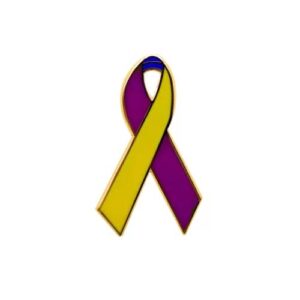

- Bladder Cancer, Adult: Bladder Cancer is cancer that forms in tissues of the bladder (the organ that stores urine). Most bladder cancers are Transitional Cell Carcinomas (cancer that begins in cells that normally make up the inner lining of the bladder). Other types include Squamous Cell Carcinoma (cancer that begins in thin, flat cells) and Adenocarcinoma (cancer that begins in cells that make and release mucus and other fluids). The cells that form Squamous Cell Carcinoma and Adenocarcinoma develop in the inner lining of the bladder because of chronic irritation and inflammation.
- Bladder Cancer, Childhood: In children, Bladder Cancer is usually low grade (not likely to spread) and the prognosis is usually excellent after surgery to remove the tumor. The alternate color for Bladder Cancer in children is gold.
Purple and Green Awareness Ribbons: Colors symbolize, stand for and support:
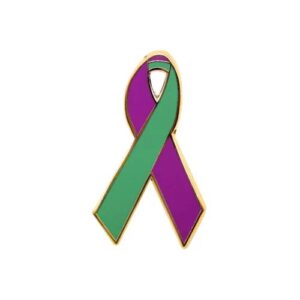

- Anal Cancer: Anal Cancer is a type of cancer that forms in the tissues of the anus. Most anal cancers are related to human papillomavirus (HPV) infection. Signs of anal cancer include bleeding from the anus or rectum or a lump near the anus. Tests that examine the rectum and anus are used to diagnose anal cancer.
- Hemiplegic Migraine: Hemiplegic Migraine is a rare subtype of migraine with aura, characterized by the presence of motor weakness as an aura manifestation at the time of migraine attack. Typically, migraine aura has visual symptoms as aura, but occasionally impairment in sensation or speech may also be seen.
- Hospice Care / Palliative Care: While the objective of both hospice and palliative care is pain and symptom relief, the prognosis and goals of care tend to be different. Hospice is comfort care without curative intent; the patient no longer has curative options or has chosen not to pursue treatment because the side effects outweigh the benefits. Palliative care is comfort care with or without curative intent. Hospice care is like palliative care, but there are important differences. Because more than 90 percent of hospice care is paid for through the Medicare hospice benefit, hospice patients must meet Medicare’s eligibility requirements; palliative care patients do not have to meet the same requirements.
- Stickler Syndrome: Stickler Syndrome is a genetic condition that affects connective tissues in the face and joints, leading to problems with vision, hearing and movement. This hereditary condition is usually diagnosed in babies and children, and early treatment leads to a positive outcome.
Purple, Red and White Awareness Ribbons: Colors and causes symbolize, stand for and support:
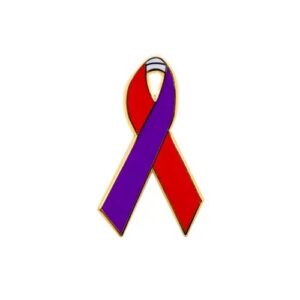

- Raynaud's Disease / Raynaud's Phenomenon / Raynaud's Syndrome: Raynaud's Disease / Raynaud’s Phenomenon / Raynaud's Syndrome is a condition that affects blood flow to the arms and legs, also called the extremities. It occurs when the blood vessels that feed the fingers and toes get smaller in reaction to cold or emotional stress (this event is called a vasospastic attack).
Purple, Teal and Magenta Awareness Ribbons: Colors and causes symbolize, stand for and support:
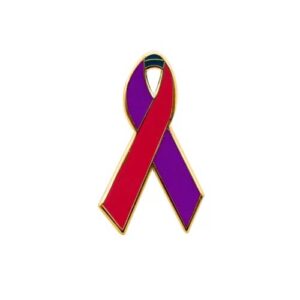

- Parathyroid Cancer: Parathyroid Cancer is a rare disease in which malignant (cancer) cells form in the tissues of a parathyroid gland. Having certain inherited disorders can increase the risk of developing parathyroid cancer. Signs and symptoms of parathyroid cancer include weakness, feeling tired, and a lump in the neck.
- Thyroid Cancer: Thyroid cancer is a growth of cells that starts in the thyroid. The thyroid is a butterfly-shaped gland located at the base of the neck, just below the Adam's apple. The thyroid produces hormones that regulate heart rate, blood pressure, body temperature and weight. Thyroid cancer might not cause any symptoms at first. But as it grows, it can cause signs and symptoms, such as swelling in the neck, voice changes and difficulty swallowing. Several types of thyroid cancer exist. Most types grow slowly, though some types can be very aggressive. Most thyroid cancers can be cured with treatment.
- Urethral Cancer: Urethral Cancer is a disease in which malignant (cancer) cells form in the tissues of the urethra. There are different types of urethral cancer that begin in cells that line the urethra. A history of bladder cancer can affect the risk of urethral cancer.
Purple and Yellow Awareness Ribbons: Colors and causes symbolize, stand for and support:
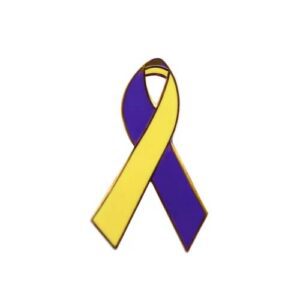

- Autoimmune Hepatitis: Autoimmune Hepatitis is liver inflammation that occurs when your body's immune system turns against liver cells. The exact cause of autoimmune hepatitis is unclear, but genetic and environmental factors appear to interact over time in triggering the disease. Untreated autoimmune hepatitis can lead to scarring of the liver (cirrhosis) and eventually to liver failure. When diagnosed and treated early, however, autoimmune hepatitis often can be controlled with drugs that suppress the immune system.
- Connection Between Lupus and Endometriosis: An increased risk for Systemic Lupus Erythematosus (SLE) was found among patients with endometriosis, according to study results published in Scientific Reports. The Taiwan study authors pointed to evidence showing that the immune system may be involved in the development of endometriosis with potential increases in the levels of inflammatory chemicals called cytokines and the presence of anti-nuclear antibodies (ANA). They conducted this study to investigate other recent studies showing a higher rate of allergies and autoimmune diseases among patients with endometriosis. They conclude that this increased risk for lupus among women with endometriosis be taken into consideration by physicians treating women with either condition.
- Intersex: People who are intersex have genitals, chromosomes or reproductive organs that don not fit into a male/female sex binary. Their genitals might not match their reproductive organs, or they may have traits of both. Being intersex may be evident at birth, childhood, later in adulthood or never.
- Sotos Syndrome: Sotos Syndrome is a condition characterized mainly by distinctive facial features; overgrowth in childhood; and learning disabilities or delayed development. Facial features may include a long, narrow face; a high forehead; flushed (reddened) cheeks; a small, pointed chin; and down-slanting palpebral fissures. Affected infants and children tend to grow quickly; they are significantly taller than their siblings and peers and have a large head. Other signs and symptoms may include intellectual disability; behavioral problems; problems with speech and language; and/or weak muscle tone (hypotonia).
Puzzle Pieces Awareness Ribbons: Colors and causes symbolize, stand for and support:
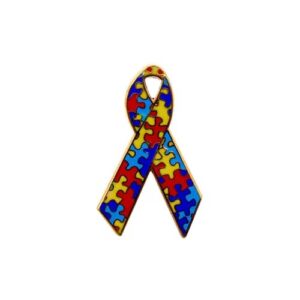
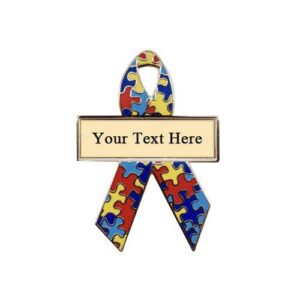
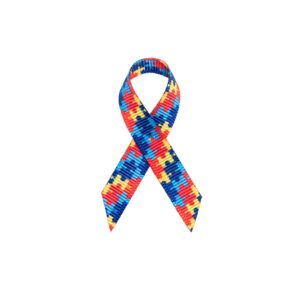
- Asperger's Syndrome: Asperger Syndrome is part of the Autism Spectrum Disorder, a group of disorders that affects the development of social and communication skills. Unlike many children with Autism Spectrum Disorder, children with Asperger Syndrome do not have early language delays, and often have well developed language skills and normal to above average intelligence. However, they may use unusual speech patterns and have a hard time understanding irony, humor, and sarcasm or gestures and social cues important to normal conversation. Many children with Asperger Syndrome develop an obsessive interest in one topic or object. They may use high-level vocabulary or complex statistics in conversation.
- Autism: Autism, or Autism Spectrum Disorder, refers to a broad range of conditions characterized by challenges with social skills, repetitive behaviors, speech and nonverbal communication. There is not one autism but many subtypes, and each person with autism can have unique strengths and challenges. A combination of genetic and environmental factors influences the development of autism. Autism affects an estimated 1 in 59 children. Many people with autism also have sensory issues. These can include aversions to certain sights, sounds and other sensations. Autism’s hallmark signs usually appear by age 2 to 3. Often, it can be diagnosed as early as 18 months. Some associated developmental delays can appear even earlier.
- Autism Spectrum Disorders: Autism Spectrum Disorder is a developmental disability caused by differences in the brain. Some people with Autism Spectrum Disorder have a known difference, such as a genetic condition. Other causes are not yet known. Scientists believe there are multiple causes of Autism Spectrum Disorder that act together to change the most common ways people develop.
Rainbow Awareness Ribbons: Colors and causes symbolize, stand for and support:
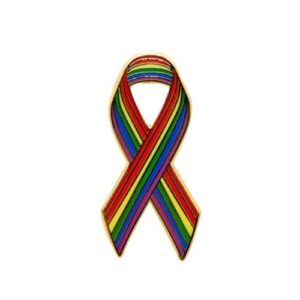


- LGBTQ+ Pride: Pride, as opposed to shame and social stigma, is the predominant outlook that bolsters most LGBTQ+ rights movements throughout the world. LGBT is an acronym meaning lesbian, gay, bisexual and transgender. The term sometimes is extended to LGBTQ, or even LGBTQIA, to include queer, intersex and asexual groups. Queer is an umbrella term for non-straight people; intersex refers to those whose sex is not clearly defined because of genetic, hormonal or biological differences; and asexual describes those who don't experience sexual attraction. These terms may also include gender fluid people, or those whose gender identity shifts over time or depending on the situation.
- Marriage Equality: Marriage Equality is the fundamental human right and equal rights of men and women of legal adult age of any nationality, race or religion to marry and found a family with the free and full consent of their intended spouse of their chosen sex. In addition, they are entitled to equal rights to marriage, during marriage and if a marriage should end, in marriage law and legislation.
- National Coming Out Day: Each year, National Coming Out Day on October 11 serves as a powerful reminder of the strength, vulnerability and authenticity it takes to embrace one's true self. First observed in 1988, the day serves as an opportunity for the LGBTQ+ community to celebrate their authentic selves and advocate for their rights. The day is held on October 11 because it is the anniversary of the Second National March on Washington for Lesbian and Gay Rights in 1987.
Red Awareness Ribbons: Colors and causes symbolize, stand for and support:
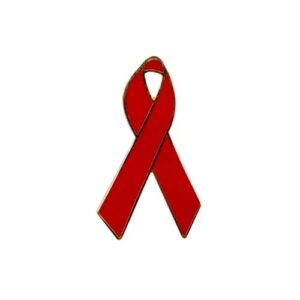

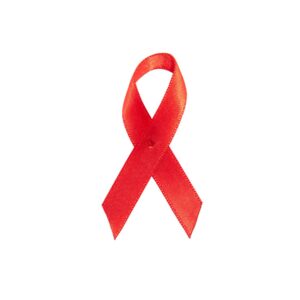
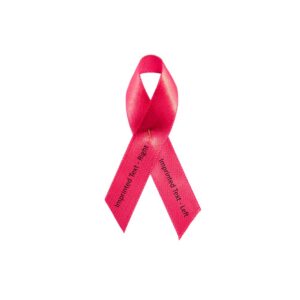


- Adult-Onset Still's Disease: Adult-Onset Still's Disease s a form of Still's Disease, a rare systemic auto-inflammatory disease characterized by the classic triad of persistent high spiking fevers, joint pain, and a distinctive salmon-colored bumpy rash. The disease is considered a diagnosis of exclusion.
- AIDS (Acquired Immunodeficiency Syndrome): Acquired Immunodeficiency Syndrome (AIDS) is a chronic, potentially life-threatening condition caused by the human immunodeficiency virus (HIV). By damaging the immune system, HIV interferes with the body's ability to fight the organisms that cause disease. HIV is a sexually transmitted infection (STI). It can also be spread by contact with infected blood or from mother to child during pregnancy, childbirth or breast-feeding. Without medication, it may take years before HIV weakens the immune system to the point of AIDS. There's no cure for HIV/AIDS, but there are medications that can dramatically slow the progression of the disease. These drugs have reduced AIDS deaths in many developed nations.
- AIDS Dysmorphic Syndrome: AIDS dysmorphic syndrome, also called HIV embryopathy, is a cluster of facial malformations seen in children with perinatal HIV infection.
- Alcohol Dependence: Alcohol Dependence may include a drinker's increase in tolerance, withdrawal syndrome, unsuccessful attempts to cut down or even quit drinking altogether, lose control of their alcohol use and consistently drink more and for longer than intended. The cardinal features of alcohol dependence are compulsion (inability to refrain from taking that drink), loss of control over alcohol (can't quit) and continued drinking no matter what the consequences.
- Alpha Thalassemia: Alpha thalassemia is an inherited blood disorder in which the body does not make as much alpha globin. Alpha globin is a building block of hemoglobin. Hemoglobin is the part of red blood cell (RBC) that carries oxygen throughout the body.The alternate color for Alpha Thalassemia is red and white pinstripes.
- Ameloblastoma: Ameloblastoma is a rare, noncancerous (benign) tumor that develops most often in the jaw near the molars. Ameloblastoma begins in the cells that form the protective enamel lining on the teeth. The most common type of ameloblastoma is aggressive, forming a large tumor and growing into the jawbone.
- Anemia: Anemia is a blood disorder that happens when a person does not have enough red blood cells or the red blood cells do not work as they should. Some types of anemia are inherited, but people may also acquire or develop the condition during their lifetimes. The alternate color for Anemia is burgundy.
- Antithrombin Deficiency: Antithrombin deficiency (or antithrombin III deficiency) is a blood clotting disorder that makes a person more likely to get abnormal blood clots. People with this problem are at a high risk for deep vein thrombosis (a blood clot in any deep vein of the body) and pulmonary embolism (a clot that ends up in the lungs). The alternate color for Antithrombin Deficiency is burgundy.
- Apert Syndrome: Apert syndrome, also known as acrocephalosyndactyly, is a genetic disorder that causes fusion of the skull, hands, and feet bones. It is characterized by deformities of the skull, face, teeth, and limbs. Apert syndrome occurs in one out of every 65,000 to 88,000 births. The alternate color for Apert Syndrome is burgundy.
- Autoimmune Hemolytic Anemia: Autoimmune Hemolytic Anemia is a rare immune disorder. It happens when the body mistakes red blood cells for foreign substances and attacks them. Treatments include medication, surgery or, in rare cases, a blood transfusion. Autoimmune Hemolytic Anemia is highly manageable but can be fatal if left untreated. Prompt care is critical.
- Benign Mucosal Pemphigoid: Cicatricial Pemphigoid (also known as Benign Mucosal Pemphigoid, Mucous Membrane Pemphigoid, or Benign Mucous Membrane Pemphigoid) is a rare chronic autoimmune blistering disease characterized by erosive skin lesions of the mucous membranes and skin that results in scarring of at least some sites of involvement.
- Beta Thalassemia: Beta Thalassemia is a blood disorder that reduces the production of hemoglobin . Hemoglobin is the iron-containing protein in red blood cells that carries oxygen to cells throughout the body. In people with beta thalassemia, low levels of hemoglobin reduce oxygen levels in the body. Beta Thalassemia is a genetic disease inherited from one or both parents. The only risk factor is having a family history of the disease.
- Bleeding Disorders: Bleeding Disorders are a group of conditions that result when the blood cannot clot properly. In normal clotting, platelets, a type of blood cell, stick together and form a plug at the site of an injured blood vessel. Proteins in the blood called clotting factors then interact to form a fibrin clot, essentially a gel plug, which holds the platelets in place and allows healing to occur at the site of the injury while preventing blood from escaping the blood vessel. While too much clotting can lead to conditions such as heart attacks and strokes, the inability to form clots can be very dangerous as well, as it can result in excessive bleeding. Bleeding can result from either too few or abnormal platelets, abnormal or low amounts of clotting proteins, or abnormal blood vessels.
- Blood Cancer: Blood Cancer, also called Hematologic Cancer, is cancer that begins in blood-forming tissue, such as the bone marrow, or in the cells of the immune system. Examples of Blood Cancer are leukemia, lymphoma, and Multiple Myeloma.
- Blood Clotting Disorders: Coagulation Disorders (blood clotting) are disruptions in the body’s ability to control blood clotting. Coagulation Disorders can result in either a hemorrhage (too little clotting that causes an increased risk of bleeding) or thrombosis (too much clotting that causes blood clots to obstruct blood flow). These Clotting Disorders develop due to several conditions.
- Bronchopulmonary Dysplasia: Bronchopulmonary Dysplasia is a serious lung condition that affects newborns. Most newborns who develop BPD are born more than 10 weeks before their due dates, weigh less than 2 pounds at birth, and have breathing problems. Babies are not born with BPD. Instead, they develop it as a complication of another breathing condition. Newborns are diagnosed with BPD if they still need breathing support 28 days after birth, or around the time they would have reached their original due date.
- Burn Victims: Burns are tissue damage that results from heat, overexposure to the sun or other radiation, or chemical or electrical contact. Burns can be minor medical problems or life-threatening emergencies.
- Cardiac Tumors / Heart Tumors, Adult: The majority of diagnosed Cardiac Tumors are benign. In adults, a somewhat mushy, gelatinous type of tumor called a Myxoma is the most common.
- Cardiac Tumors, / Heart Tumors, Childhood: Most tumors that form in the heart are benign (not cancer). Before birth and in newborns, the most common benign heart tumors are Teratomas. In infants and children, Rhabdomyomas predominate, typically associated with the syndrome Tuberous Sclerosis. An inherited condition called Tuberous Sclerosis can cause heart tumors to form in a fetus or newborn. Malignant tumors that begin in the heart are even more rare than benign heart tumors in children. The alternate color for Cardiac Tumors / Heart Tumors in children is gold.
- Cardiomyopathy: Cardiomyopathy is a disease of the heart muscle that makes it harder for the heart to pump blood to the rest of the body. Cardiomyopathy can lead to heart failure. The main types of cardiomyopathies include Dilated, Hypertrophic and Restrictive Cardiomyopathy. Treatment, which might include medications, surgically implanted devices or, in severe cases, a heart transplant, depends on which type of cardiomyopathy a person has and how serious it is.
- Cardiovascular Disease: Cardiovascular Disease generally refers to conditions that involve narrowed or blocked blood vessels that can lead to a heart attack, chest pain (angina) or stroke. Other heart conditions, such as those that affect your heart's muscle, valves or rhythm, also are considered forms of heart disease.
- Cavernous Angioma: A Cavernous Angioma is a blood vessel abnormality characterized by large, adjacent capillaries with little or no intervening brain. The blood flow through these vessels is slow. Cavernous angiomas can occur anywhere in the central nervous system. The disease occurs in 0.4 percent of the population, and 18.7 percent of these patients have multiple lesions. The alternate color for Cavernous Angioma is burgundy.
- Churg Strauss Syndrome / Eosinophilic Granulomatosis: Churg-Strauss Syndrome is a disorder marked by blood vessel inflammation. This inflammation can restrict blood flow to organs and tissues, sometimes permanently damaging them. This condition is also known as Eosinophilic Granulomatosis with Polyangiitis.
- Clotting Factor Deficiencies: Rare Clotting Factor Deficiencies are a group of inherited bleeding disorders caused by a problem with one or several clotting factors. Clotting factors are proteins in the blood that control bleeding. Many different clotting factors work together in a series of chemical reactions to stop bleeding. This is called the clotting process. Problems with Factor VIII and Factor IX are known as hemophilia A and B, respectively. Rare clotting factor deficiencies are bleeding disorders in which one of the other clotting factors (i.e. factors I, II, V, V + VIII, VII, X, XI, or XIII) is missing or not working properly. Less is known about these disorders because they are diagnosed so rarely. In fact, many have only been discovered in the last forty years. The alternate color for Clotting Factor Deficiencies is burgundy.
- Coagulation Disorders: Coagulations Disorders are conditions that affect the blood's clotting activities. Hemophilia, Von Willebrand Disease, Clotting Factor Deficiencies, Hypercoagulable States and Deep Venous Thrombosis are all Coagulations Disorders. Hemophilia and Von Willebrand Disease are among the best known. The alternate color for Coagulation Disorders is burgundy.
- Cogan’s Syndrome: Cogan's Syndrome is a rare inflammatory disease characterized by inflammation of the inner ears and eyes. It can lead to vision difficulties, hearing loss and dizziness. Commonly there is also inflammation in other organs as well, particularly the heart and large blood vessels, nervous system and bowels. The alternate color for Cogan's Syndrome is light blue.
- Cold Agglutinin Disease: Cold Agglutinin Disease is a rare autoimmune disorder characterized by the premature destruction of red blood cells (hemolysis).
- Congestive Heart Failure: Congestive Heart Failure is a chronic progressive condition that affects the pumping power of the heart muscles. While often referred to simply as “heart failure,” CHF specifically refers to the stage in which fluid builds up around the heart and causes it to pump inefficiently.
- Cryptococcosis: Cryptococcosis is an illness caused by infection with Cryptococcus fungi in the brain or lungs. It can also spread to many areas of your body (disseminated cryptococcosis). When a person has a Cryptococcus infection in your brain, it is called cryptococcal meningitis. It can cause fever, headaches and neck stiffness. In the lungs, it is sometimes called cryptococcal pneumonia or pulmonary cryptococcosis. It can cause cough and shortness of breath.
- Cutaneous Vasculitis: Cutaneous Vasculitis refers to vasculitis affecting small- or medium-sized vessels in the skin and subcutaneous tissue but not the internal organs. Cutaneous vasculitis may be limited to the skin or may be a component of a systemic primary or secondary vasculitic disorder. Purpura, petechiae, or ulcers may develop.
- Diamond Blackfan Anemia: Diamond Blackfan Anemia is a rare inherited bone marrow failure syndrome, characterized by a failure of the bone marrow (the center of the bone where blood cells are made) to produce red blood cells. This failure causes Diamond Blackfan Anemia patients to become severely anemic.
- Disaster Relief: Disaster relief (or emergency management) refers to the process of responding to a catastrophic situation, providing humanitarian aid to persons and communities who have suffered from some form of disaster. The alternate color for Disaster Relief is green.
- Driving Under the Influence Prevention: For more than forty years, preventionists across the country have observed National Impaired Driving Prevention Month in December. This month raises awareness that impaired driving can be deadly and aims to put strategies in place for all drivers and passengers (and pedestrians) to make it home safely.
- Drug Addiction: The National Institute on Drug Abuse (NIDA) provides a comprehensive definition of drug addiction, stating, “addiction is defined as a chronic, relapsing brain disease that is characterized by compulsive drug seeking and use, despite harmful consequences.” Addiction is recognized as a brain disease because drugs literally cause changes to the brain.
- Epidermolysis Bullosa Acquisita: Epidermolysis Bullosa Acquisita is a rare, sporadic, subepithelial, mucocutaneous blistering disease that usually develops in adulthood. EBA is classically described as a mechanobullous disorder characterized by skin fragility, noninflammatory tense bullae, milia, and scarring.
- Erythromelalgia: Erythromelalgia is a rare condition that primarily affects the feet and, less commonly, the hands. It is characterized by intense, burning pain of affected extremities, severe redness, and increased skin temperature that may be episodic or almost continuous in nature.
- Evans Syndrome: Evans Syndrome is a rare disorder in which the body's immune system produces antibodies that mistakenly destroy red blood cells, platelets and sometimes certain white blood cell known as neutrophils. This leads to abnormally low levels of these blood cells in the body (cytopenia).
- Factor XI Deficiency: Factor XI deficiency is a disorder that can cause abnormal bleeding due to a shortage (deficiency) of the Factor XI protein, which is involved in blood clotting. This condition is classified as either partial or severe based on the degree of deficiency of the Factor XI protein.
- Fanconi Anemia: Fanconi Anemia is a rare, inherited blood disorder that leads to bone marrow failure. The disorder also is called Fanconi's Anemia. Fanconi Anemia prevents the bone marrow from making enough new blood cells for the body to work normally.
- Giant Cell Arteritis: Giant Cell Arteritis is an inflammatory disease affecting the large blood vessels of the scalp, neck and arms. Inflammation causes a narrowing or blockage of the blood vessels, which interrupts blood flow. The disease is commonly associated with Polymyalgia Rheumatica. Caucasian women over the age of 50, most commonly between the ages of 70 and 80 years, have the highest risk of developing giant cell arteritis. Although women are more likely than men to develop Giant Cell Arteritis, research suggests that men are more likely to suffer potentially blinding eye involvement.
- Graft versus Host Disease: Graft versus host disease (GVHD) is a life-threatening complication that can occur after a bone marrow or stem cell transplant. It happens when the donor's immune system attacks the recipient's body, recognizing it as foreign. GVHD can affect many parts of the body, but most commonly affects the skin, liver, and gut.
- Heart Disease: Heart Disease describes a range of conditions that affect the heart. Diseases under the heart disease umbrella include blood vessel diseases, such as coronary artery disease; heart rhythm problems (arrhythmias); and heart defects a person is born with (congenital heart defects), among others. The term heart disease is often used interchangeably with the term cardiovascular disease. Cardiovascular disease generally refers to conditions that involve narrowed or blocked blood vessels that can lead to a heart attack, chest pain (angina) or stroke. Other heart conditions, such as those that affect the heart's muscle, valves or rhythm, also are considered forms of heart disease.
- Heart Tumors, Adult: The most common types of benign heart tumors are Myxoma, the most common primary cardiac tumor. Myxoma accounts for approximately 50% of Primary Cardiac Tumors. Papillary Fibroelastoma is the most common Cardiac Tumor to affect the cardiac valves.
- Heart Tumors, Childhood: Most tumors that form in the heart are benign (not cancer). Before birth and in newborns, the most common benign heart tumors are Teratomas. An inherited condition called Tuberous Sclerosis can cause heart tumors to form in a fetus or newborn. Malignant tumors that begin in the heart are even more rare than benign heart tumors in children. The alternate color for Heart Tumors in children is gold.
- Hemolytic Anemia: Hemolytic Anemia is a disorder in which red blood cells are destroyed faster than they can be made. The destruction of red blood cells is called hemolysis. Red blood cells carry oxygen to all parts of the body. If a person has a lower-than-normal amount of red blood cells, it is considered anemia. When a person has anemia, the blood cannot bring enough oxygen to all the tissues and organs. Without enough oxygen, the body cannot work as well as it should. Hemolytic anemia can be inherited or acquired.
- Hemophilia: Hemophilia is a rare disorder in which the blood does not clot normally because it lacks sufficient blood-clotting proteins (clotting factors). With hemophilia, one may bleed for a longer time after an injury than if the blood clotted normally. Small cuts usually are not much of a problem. The greater health concern is deep bleeding inside the body, especially in the knees, ankles and elbows. That internal bleeding can damage organs and tissues and may be life-threatening. Hemophilia is an inherited (genetic) disorder. Treatment includes regular replacement of the specific clotting factor that is reduced.
- High Blood Pressure: High blood pressure, also known as hypertension, is a serious health condition that can increase the risk of heart disease and stroke. It is often called the "silent killer" because it does not usually cause symptoms until it's already led to serious health problems.
- HIV: Acquired Immunodeficiency Syndrome (AIDS) is a chronic, potentially life-threatening condition caused by the Human Immunodeficiency Virus (HIV). By damaging the immune system, HIV interferes with the body's ability to fight the organisms that cause disease. HIV is a sexually transmitted infection. It can also be spread by contact with infected blood or from mother to child during pregnancy, childbirth or breast-feeding. Without medication, it may take years before HIV weakens the immune system to the point that a person has AIDS.
- Hypertension: Hypertension, or High Blood Pressure is a common condition in which the long-term force of the blood against the artery walls is high enough that it may eventually cause health problems, such as heart disease. Blood pressure is determined both by the amount of blood the heart pumps and the amount of resistance to blood flow in the arteries. The more blood the heart pumps and the narrower the arteries, the higher the blood pressure. One can have high blood pressure (hypertension) for years without any symptoms. Even without symptoms, damage to blood vessels and the heart continues and can be detected. Uncontrolled high blood pressure increases the risk of serious health problems, including heart attack and stroke. High blood pressure generally develops over many years, and it affects nearly everyone eventually. Fortunately, high blood pressure can be easily detected and often controlled with medication.
- Impaired Driving: Impaired Driving is dangerous. It is the cause of more than half of all car crashes. Impaired driving means operating a motor vehicle while affected by alcohol, legal or illegal drugs, sleepiness, distractions such as using a cell phone or texting, and having a medical condition which affects one's driving.
- KBG Syndrome: KBG syndrome is a rare disorder that affects several body systems. "KBG" represents the surname initials of the first families diagnosed with the disorder. Common signs and symptoms in individuals with this condition include unusual facial features, skeletal abnormalities, and intellectual disability.
- Leukocytoclastic Vasculitis: Leukocytoclastic Vasculitis is a cutaneous, small-vessel vasculitis of the dermal capillaries and venules. This condition can be idiopathic or associated with infections, neoplasms, autoimmune disorders, and drugs.
- Linear IgA Disease: Linear IgA Bullous Dermatosis, also known as Linear IgA Disease, is a rare, idiopathic or drug-induced autoimmune blistering disease characterized by the linear deposition of IgA at the dermoepidermal junction.
- Long QT Syndrome: Long QT Syndrome is a rare heart condition that causes an abnormally long QT interval on an electrocardiogram (EKG). This interval is a measure of how long it takes the heart to repolarize after a beat. LQTS increases the risk of an irregular heartbeat, which can lead to fainting, seizures, drowning, or sudden death.
- MADD / Mothers Against Drunk Driving: Mothers Against Drunk Driving is a non-profit organization in the United States, Canada and Brazil that seeks to stop drunk driving, support those affected by drunk driving, prevent underage drinking, and strive for stricter impaired driving policy, whether that impairment is caused by alcohol or any other drug.
- Marfan Syndrome: Marfan Syndrome is a genetic disorder that affects the body’s connective tissue. Connective tissue holds all the body’s cells, organs and tissue together. It also plays an important role in helping the body grow and develop properly. Because connective tissue is found throughout the body, Marfan Syndrome can affect many different parts of the body, as well. Features of the disorder are most often found in the heart, blood vessels, bones, joints, and eyes.
- Microscopic Polyangiitis: Microscopic Polyangiitis is a condition that causes small blood vessels to be inflamed. It's a rare type of vasculitis. The disease can damage the blood vessels and cause problems in organs around the body. Microscopic Polyangiitis most often affects people in their 50s and 60s, but it can happen at any age.
- Mitral Valve Prolapse Syndrome / Heart Valve Disease: Mitral valve prolapse (MVP) is a heart valve disease that occurs when the mitral valve's flaps stretch or enlarge, preventing the valve from closing properly.
- Myelodysplastic Syndromes: Myelodysplastic Syndromes are a group of disorders caused by blood cells that are poorly formed or do not work properly. Myelodysplastic syndromes result from something amiss in the spongy material inside the bones where blood cells are made (bone marrow).
- Myocarditis: Myocarditis is inflammation of the heart muscle. Pericarditis is inflammation of the outer lining of the heart. In both cases, the body's immune system causes inflammation in response to an infection or some other trigger.
- National Red Ribbon Campaign / National Red Ribbon Week / DARE: National Family Partnership provides drug awareness by sponsoring the annual National Red Ribbon Campaign™. Since its beginning in 1985, the Red Ribbon has touched the lives of millions of people around the world. In response to the murder of DEA Agent Enrique Camarena, angered parents and youth in communities across the country began wearing red ribbons as a symbol of their commitment to raise awareness of the killing and destruction cause by drugs in America. In 1988, National Family Partnership sponsored the first National Red Ribbon Celebration. Today, the red ribbon serves as a catalyst to mobilize communities to educate youth and encourage participation in drug prevention activities.
- Pernicious Anemia: Anemia is a condition in which the body does not have enough healthy red blood cells. Red blood cells provide oxygen to body tissues. There are many types of anemia. Pernicious anemia is a decrease in red blood cells that occurs when the intestines cannot properly absorb vitamin B12.
- PHACE Syndrome: PHACE Syndrome (posterior fossa anomalies, hemangioma, arterial anomalies, cardiac anomalies, and eye anomalies) is an uncommon disorder of unknown etiology characterized by large segmental hemangiomas of the face and various developmental defects. The term "PHACE(S)" is sometimes used in the presence of ventral developmental defects, which include sternal cleft, supraumbilical raphe, or both.
- Platelet Donation: Blood donation is a voluntary procedure that can help save the lives of others. There are several types of blood donation, which help meet different medical needs. Platelet donation collects only platelets, the cells that help stop bleeding by clumping and clotting in blood vessels. Donated platelets are commonly given to people with leukemia, people receiving chemotherapy and babies with severe infections. The alternate color for Platelet Donation is black and gold.
- Poland Syndrome: Poland Syndrome, named after British surgeon Alfred Poland, is a rare birth defect characterized by underdevelopment or absence of the chest muscle on one side of the body, and usually also webbing of the fingers of the hand on the same side.
- Polyarteritis Nodosa: Polyarteritis Nodosa is a rare multi-system disorder characterized by widespread inflammation, weakening, and damage to small and medium-sized arteries.
- Polymyalgia Rheumatica: Polymyalgia Rheumatica is an inflammatory disorder that causes muscle pain and stiffness, especially in the shoulders and hips. Signs and symptoms of Polymyalgia Rheumatica usually begin quickly and are worse in the morning. The alternate color for Polymyalgia Rheumatica is purple and blue.
- Prinzmetal Angina: Prinzmetal's Variant Angina is characterized by recurrent episodes of chest pain that usually occur when a person is at rest, between midnight and early morning. "Typical" angina, by contrast, is often triggered by physical exertion or emotional stress. Episodes of Prinzmetal Variant Angina can be very painful and may last from several minutes to thirty minutes. In some cases, the pain may spread from the chest to the head, shoulder, or arm.
- Pulmonary Embolism: Pulmonary Embolism occurs when a blood clot gets stuck in an artery in the lung, blocking blood flow to part of the lung. Blood clots most often start in the legs and travel up through the right side of the heart and into the lungs. This is called Deep Vein Thrombosis (DVT).
- Rheumatic Fever: Rheumatic Fever is an inflammation in the heart, joints, skin or central nervous system that can occur following inadequately treated strep throat or scarlet fever. These diseases are caused by an infection with group A streptococcus bacteria. Proper treatment of strep can prevent rheumatic fever.
- Rosacea: Rosacea is a common skin condition that causes redness and visible blood vessels in the face. It may also produce small, red, pus-filled bumps. These signs and symptoms may flare up for a period of weeks to months and then diminish for a while. Rosacea can be mistaken for acne, an allergic reaction or other skin problems.
- Sinus Tachycardia: Tachycardia is a condition that makes the heart beat more than 100 times per minute. There are three types of Sinus Tachycardia. Sinus Tachycardia happens when the heart’s natural pacemaker sends out electrical signals faster than normal. The heart beats fast, but it beats the way it should.
- Stop Forever Chemicals / PFAS: Here’s the bad news: Forever chemicals are everywhere. These toxic compounds, known as per- and polyfluoroalkyl substances (PFAS), are often used in goods that resist water and grease, such as cookware, furniture, and outdoor apparel. PFAS exposure has been linked to a host of health risks, from cancer to fertility issues, and its prevalence in consumer goods means that PFAS are now routinely found in soil, drinking water, homes, and people’s bodies. The good news is that though no one can avoid PFAS entirely, people can take specific actions to reduce exposure and risk to their long-term health.
- Stroke: A stroke, sometimes called a "brain attack," occurs when blood flow to an area in the brain is cut off. The brain cells, deprived of the oxygen and glucose needed to survive, die. If a Stroke is not caught early, permanent brain damage or death can result.
- Substance Abuse: Substance Abuse refers to the harmful or hazardous use of psychoactive substances, including alcohol and illicit drugs. Psychoactive substance use can lead to dependence syndrome - a cluster of behavioral, cognitive, and physiological phenomena that develop after repeated substance use. This typically includes a strong desire to take the drug, difficulties in controlling its use, persisting in its use despite harmful consequences, a higher priority given to drug use than to other activities and obligations, increased tolerance, and sometimes a physical withdrawal state.
- Substance Abuse Prevention: Studies indicate that substance use disorders and other drug-related harms are more likely to occur when a person has experienced risk factors such as a family history of substance use disorders, personal trauma, or access to drugs. Protective factors, such as healthy family and peer relationships and financial stability, may lessen a person’s risk of developing substance use disorders.
- Supraventricular Tachycardia / SVT: Supraventricular Tachycardia happens when the electrical system that controls the heart rhythm is not working properly. This causes the heart to suddenly beat much faster. It can then slow down abruptly.
- Tachycardia: Tachycardia is the medical term for a heart rate over 100 beats a minute. Many types of irregular heart rhythms (arrhythmias) can cause tachycardia. A fast heart rate is not always a concern. For instance, the heart rate typically rises during exercise or as a response to stress.
- Takayasu’s Arteritis: Takayasu's Arteritis is a rare type of vasculitis, a group of disorders that causes blood vessel inflammation. In Takayasu's Arteritis, the inflammation damages the large artery that carries blood from the heart to the rest of the body and its main branches.
- Temporal Arteritis: Giant Cell Arteritis, or Temporal Arteritis, is an inflammatory disease affecting the large blood vessels of the scalp, neck and arms. Inflammation causes a narrowing or blockage of the blood vessels, which interrupts blood flow. The disease is commonly associated with Polymyalgia Rheumatica.
- Thrombotic Thrombocytopenic Purpura / TTP: Thrombotic Thrombocytopenic Purpura is a rare blood disorder. In TTP, blood clots form in small blood vessels throughout the body. The clots can limit or block the flow of oxygen-rich blood to the body's organs, such as the brain, kidneys, and heart. As a result, serious health problems can develop. The increased clotting that occurs in TTP also uses up platelets in the blood. Platelets are blood cell fragments that help form blood clots. These cell fragments stick together to seal small cuts and breaks on blood vessel walls and stop bleeding. With fewer platelets available in the blood, bleeding problems can occur.
- Tuberculosis / TB: Tuberculosis, or TB, as it’s commonly called, is a contagious infection that usually attacks the lungs. It can also spread to other parts of the body, like the brain and spine. A type of bacteria called Mycobacterium tuberculosis causes it.
- Urticarial Vasculitis: Urticarial Vasculitis is among a family of rare diseases characterized by inflammation of the blood vessels, which can restrict blood flow and damage vital organs and tissues.
- Vasculitis: Vasculitis is inflammation of your blood vessels. It causes changes in the blood vessel walls, including thickening, weakening, narrowing or scarring. These changes can restrict blood flow, resulting in organ and tissue damage. There are many types of vasculitis, and most of them are rare. Vasculitis might affect just one organ, or several. The condition can be short term or long lasting.
- Von Willebrand Disease: Von Willebrand disease is a lifelong bleeding disorder in which the blood does not clot well. Most people with the disease are born with it, though its warning signs may not show up for years. Some people may suspect they have a bleeding disorder when they have heavy bleeding after a dental procedure or, for women, during a menstrual period. Most people with this condition inherited it from a parent. A faulty gene causes problems with a protein important to the blood-clotting process.
- Wegener's Granulomatosis: Wegener's Granulomatosis is a very rare disease that affects many different organs and systems of the body. One of the main features of the disease is an inflammation of the blood vessels (vasculitis). The inflammation narrows the blood vessels and reduces the blood flow to the affected organs. This destroys tissues and damages vital organs.
- Wolff Parkinson White Syndrome: Wolff-Parkinson-White (WPW) syndrome is a heart condition present at birth. That means it is a congenital heart defect. People with WPW syndrome have an extra pathway for signals to travel between the heart's upper and lower chambers. This causes a fast heartbeat. Changes in the heartbeat can make it harder for the heart to work as it should.
- Women's Heart Health: In the United States, 1 in 4 women dies from heart disease. The most common cause of heart disease in both men and women is narrowing or blockage of the coronary arteries, the blood vessels that supply blood to the heart itself. This is called Coronary Artery Disease, and it happens slowly over time. It is the major reason people have heart attacks. The older a woman gets, the more likely she is to get heart disease. But women of all ages should be concerned about heart disease. All women can take steps to prevent it by practicing healthy lifestyle habits.
- Zika Virus is a virus transmitted by mosquitoes which typically causes asymptomatic or mild infection (fever and rash) in humans, identified originally in Africa and later in other tropical regions, including South America, where it may be associated with an increased incidence of microcephaly in babies born to mothers infected during pregnancy.
Red and Blue Awareness Ribbons: Colors and causes symbolize, stand for and support:
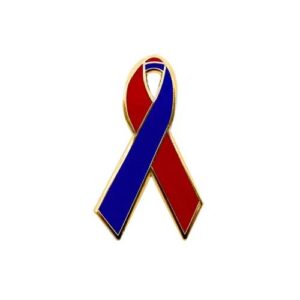

- Atrial Septal Defects: An Atrial Septal Defect is a heart condition that a baby is born with at birth. That means it is a congenital heart defect. People with an ASD have a hole between the upper heart chambers. The hole increases the amount of blood going through the lungs.
- Atrioventricular Septal Defect: Atrioventricular Septal Defect, or AV canal, is a heart defect that involves the valves between the heart's upper and lower chambers and the walls between the chambers. Other terms used to describe this problem include endocardial cushion defect and AV canal defect. A similar but less serious form of atrioventricular septal defect is called primum atrial septal defect or incomplete or partial atrioventricular septal defect. The cause of atrioventricular septal defect is not known. Overall, it is quite rare and accounts for 4% of heart defects diagnosed in children.
- Congenital Heart Block: Congenital Heart Block, or Atrioventricular Block, is characterized by interference of the transfer of the electrical nerve impulses that regulate the normal and rhythmic pumping action of the heart muscle. The severity of such conduction abnormalities varies among affected individuals.
- Congenital Heart Defects: Congenital Heart Defects are present at birth and can affect the structure of a baby’s heart and the way it works. They can affect how blood flows through the heart and out to the rest of the body. Congenital heart defects can vary from mild (such as a small hole in the heart) to severe (such as missing or poorly formed parts of the heart).
- Congenital Heart Diseases: A Congenital Heart Defect or Congenital Heart Disease is a malformation of the heart, aorta, or other large blood vessels that are the most frequent form of major birth defect in newborns. Congenital heart disease, or a congenital heart defect, is a heart abnormality present at birth. There are numerous types of congenital heart defects. They can range from simple conditions that do not cause symptoms to complex problems that cause severe, life-threatening symptoms. According to the Centers for Disease Control and Prevention, there are currently 1 million adults and 1 million children in the United States living with congenital heart defects.
- Fibrosing Alveolitis: Fibrosing Alveolitis is a disease of unknown cause mainly involving the gas-exchanging portions of the lungs. It may occur in isolation and be called cryptogenic or idiopathic, in which case the clinical manifestations are mainly respiratory, or it may be associated with other disorders, such as Rheumatoid Arthritis.
- Hereditary Hemorrhagic Telangiectasia: Hereditary Hemorrhagic Telangiectasia is a disorder in which some blood vessels do not develop properly. A person with Hereditary Hemorrhagic Telangiectasia may form blood vessels without the capillaries (tiny blood vessels that pass blood from arteries to veins) that are usually present between arteries and veins.
- Hypoplastic Left Heart Syndrome (HLHS): Hypoplastic Left Heart Syndrome (HLHS) is a birth defect that affects normal blood flow through the heart. As the baby develops during pregnancy, the left side of the heart does not form correctly. Hypoplastic Left Heart Syndrome is one type of congenital heart defect. Because a baby with this defect needs surgery or other procedures soon after birth, Hypoplastic Left Heart Syndrome is considered a critical congenital heart defect.
- Hypoplastic Right Heart Syndrome: Hypoplastic Right Heart Syndrome is the underdevelopment of the right side of the heart, particularly the ventricle. The ventricle is the muscular lower chamber of the heart. Normally, the right ventricle pushes blood out of the heart and to the lungs where it can pick up oxygen. The blood with oxygen then moves to the left side of the heart which pumps the blood to the rest of the body. Hypoplastic Right Heart Syndrome makes it difficult or impossible to pass blood to the lungs. This decreases the amount of oxygen for the rest of the body. The underdeveloped muscle of the right ventricle can also be easily exhausted by normal heart functions. Other structures of the right side of the heart may also be underdeveloped and decrease the flow of blood from the heart to the lungs.
- Noonan Syndrome: Noonan Syndrome is a genetic disorder that prevents normal development in various parts of the body. A person can be affected by Noonan Syndrome in a wide variety of ways. Noonan Syndrome is caused by a genetic mutation and is acquired when a child inherits a copy of an affected gene from a parent. It can also occur as a spontaneous mutation, meaning there is no family history involved.
- Pediatric Cardiomyopathy: Pediatric Cardiomyopathy is a rare heart condition that affects infants and children. Specifically, cardiomyopathy means disease of the heart muscle (myocardium). Several different types of cardiomyopathies exist, and the specific symptoms vary from person to person. In some affected individuals, no symptoms may be present (asymptomatic); in many people, cardiomyopathy is a progressive condition that may result in an impaired ability of the heart to pump blood; fatigue; heart block resulting in a very slow heart rate (bradycardia); irregular or rapid heartbeats (tachycardia); and, potentially, heart failure and sudden cardiac death.
- Pulmonary Fibrosis: Pulmonary Fibrosis is a lung disease that occurs when lung tissue becomes damaged and scarred. This thickened, stiff tissue makes it more difficult for the lungs to work properly. As Pulmonary Fibrosis worsens, one becomes progressively more short of breath. The scarring associated with Pulmonary Fibrosis can be caused by a multitude of factors.
- Seasonal Affective Disorder / SAD: SAD is a type of depression that happens during a certain season of the year, most often fall and winter. There is no clear cause of SAD. But less sunlight and shorter days may be part of the cause. Melatonin, a sleep-related hormone, also may be linked to SAD.
- Sudden Arrhythmic Death Syndrome / SADS: Sudden arrhythmic death syndrome (SADS) is a sudden unexpected death of adolescents and adults caused by a cardiac arrest. However, the exact cause of the cardiac arrest, and thus the exact cause of death, is unknown. These deaths occur mainly during sleep or at rest. The alternate color for Sudden Arrhythmic Death Syndrome / SADS is red.
- Tetralogy of Fallot: Tetralogy of Fallot is a rare heart condition that is present at birth. That means it is a congenital heart defect. A baby born with the condition has four different heart problems. These heart problems affect the structure of the heart. The condition causes altered blood flow through the heart and to the rest of the body. Babies with Tetralogy of Fallot often have blue or gray skin color due to low oxygen levels. Tetralogy of Fallot is usually diagnosed during pregnancy or soon after a baby is born. If the heart changes and symptoms are mild, Tetralogy of Fallot may not be noticed or diagnosed until adulthood.
- Tricuspid Atresia: Tricuspid Atresia is a heart problem present at birth, known as a congenital heart defect. The valve is not formed between the two right heart chambers. Instead, a solid sheet of tissue blocks the blood flow between the right heart chambers. The condition limits blood flow through the heart. Tricuspid Atresia causes the right lower heart to be underdeveloped.
Red and Gray Awareness Ribbons: Colors and causes symbolize, stand for and support:
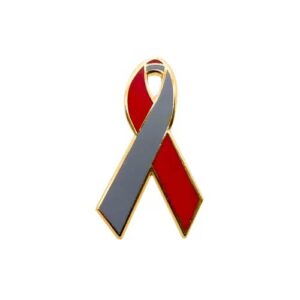

- Ohio State University Suicide Prevention Program: Anyone can help prevent suicide by learning the risks, warning signs, and how to intervene. REACH© is the name of the OSU Suicide Prevention in-person gatekeeper training program designed to help the OSU community prevent suicide by teaching faculty, staff, and students how to: Recognize warning signs, Engage with empathy, Ask directly about suicide, Communicate hope, Help suicidal individuals access care and treatment. OSUSPP offers in-person REACH© Trainings to university and student affiliated organizations, departments, colleges, and programs. Participants who finish the training receive certificates and pins verifying their completion of the program.
- Polymicrogyria: Polymicrogyria is a condition characterized by abnormal development of the brain before birth. Specifically, the surface of the brain develops too many folds which are unusually small. The signs and symptoms associated with the condition vary based on how much of the brain and which areas of the brain are affected. Bilateral forms tend to cause more severe neurological problems.
Red and Pearl Awareness Ribbons: Colors and causes symbolize, stand for and support:


- Latex Allergy: Latex Allergy is a reaction to certain proteins found in natural rubber latex, a product made from the rubber tree. With a latex allergy, the body mistakes latex for a harmful substance. Latex allergy may cause itchy skin and hives or even anaphylaxis, a potentially life-threatening condition that can cause throat swelling and severe difficulty breathing.
Red and Purple Awareness Ribbons: Colors and causes symbolize, stand for and support:
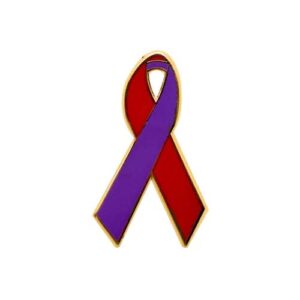

- Arachnoiditis: Arachnoiditis is a disorder caused by the inflammation of the arachnoid. The arachnoid is one of the membranes that surround and protect the nerves of the spinal cord. The arachnoid can become inflamed because of an irritation from chemicals, infection from bacteria or viruses. The alternate color for Arachnoiditis is purple.
- Autoimmune Myocarditis: Autoimmune Myocarditis is an autoimmune disease that affects the heart. The condition is characterized by inflammation of the heart muscle (myocardium). Some people with autoimmune myocarditis have no noticeable symptoms of the condition. The alternate color for Autoimmune Myocarditis is red.
- Desmoplastic Small Round Cell Tumor: Desmoplastic Small Round Cell Tumors are tumors that grow in the abdomen and pelvic area of the body. Desmoplastic Small Round Cell Tumors are a type of soft tissue sarcoma, which is a type of cancer that forms in the connective tissue of the body.
- Migraine: A migraine can cause severe throbbing pain or a pulsing sensation, usually on just one side of the head. It's often accompanied by nausea, vomiting, and extreme sensitivity to light and sound. Migraine attacks can cause significant pain for hours to days and can be so severe that the pain is disabling. Warning symptoms known as aura may occur before or with the headache. These can include flashes of light, blind spots, or tingling on one side of the face or in the arm or leg. The alternate color for Migraine is purple.
- Lupus Vasculitis: Lupus Vasculitis is one of the secondary issues occurring in the setting of Systemic Lupus Erythematosus (SLE) in approximately 50% of patients. It is most associated with small vessels, but medium-sized vessels can also be affected, whereas large vessel involvement is very rare.
Red and White Pinstripes Awareness Ribbons: Colors and causes symbolize, stand for and support:
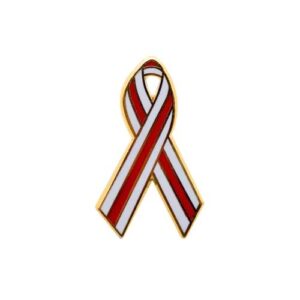

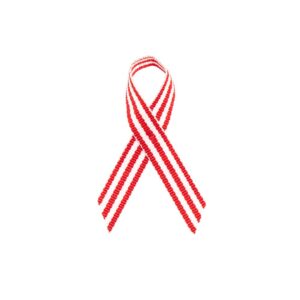
- Acquired Aplastic Anemia: Acquired Aplastic Anemia is a rare, serious blood disorder, due to bone marrow failure to produce blood cells. Bone marrow is the spongy substance found in the center of the bones of the body, in adults mainly the spine, pelvis, and large bones of the legs. The alternate color for Acquired Aplastic Anemia is red.
- Adenoid Cystic Carcinoma: An Adenoid Cystic Carcinoma is a rare type of cancer that usually begins in the salivary glands.
- Aplastic Anemia: Aplastic Anemia is a condition in which the bone marrow is unable to produce blood cells. The alternate color for Aplastic Anemia is red.
- Deep Vein Thrombosis / DVT: Deep Vein Thrombosis (DVT) occurs when a blood clot (thrombus) forms in one or more of the deep veins in the body, usually in the legs. Deep vein thrombosis can cause leg pain or swelling, but also can occur with no symptoms. The alternate color for Deep Vein Thrombosis / DVT is red.
- Esthesioneuroblastoma: Head and Neck Cancers include cancers in the larynx, throat, lips, mouth, nose, and salivary glands. Tobacco use, heavy alcohol use, and infection with Human Papillomavirus (HPV) increase the risk of head and neck cancers. Esthesioneuroblastoma, also known as Olfactory Neuroblastoma, is an uncommon malignant tumor of the upper nasal cavity and anterior skull base.
- Gum Disease: Periodontal or gum disease is inflammation and infection of the gums and the bone that supports your teeth. It can be a result of poor hygiene, but some people are more prone to this type of infection. Symptoms may include bad breath, loose teeth and bleeding, swollen gums. There are many treatments available, depending on the severity of disease.
- Head and Neck Cancer: Head and Neck Cancer is cancer that arises in the head or neck region (in the nasal cavity, sinuses, lips, mouth, salivary glands, throat, or larynx).
- Hypopharyngeal Cancer: Head and Neck Cancers include cancers in the larynx, throat, lips, mouth, nose and salivary glands. Tobacco use, heavy alcohol use, and infection with Human Papillomavirus (HPV) increase the risk of head and neck cancers.
- Laryngeal Cancer: Head and Neck Cancer includes cancers in the larynx, throat, lips, mouth, nose, and salivary glands. Tobacco use, heavy alcohol use, and infection with Human Papillomavirus (HPV) increase the risk of head and neck cancers. Most laryngeal cancers form in squamous cells, the thin, flat cells lining the inside of the larynx. Laryngeal cancer is a type of head and neck cancer.
- Lip and Oral Cavity Cancer: Lip and Oral Cavity Cancer is a type of head and neck cancer. Head and neck cancers include cancers in the larynx, throat, lips, mouth, nose, and salivary glands. Tobacco use, heavy alcohol use, and infection with Human Papillomavirus (HPV) increase the risk of head and neck cancers. Most lip and oral cavity cancers start in squamous cells, the thin, flat cells that line the lips and oral cavity. These are called squamous cell carcinomas. Cancer cells may spread into deeper tissue as the cancer grows. Squamous Cell Carcinoma usually develops in areas of leukoplakia (white patches of cells that do not rub off).
- Mouth Cancer: Lip and Oral Cavity Cancer is a disease in which malignant cells form in the lips or mouth. The oral cavity includes the front two thirds of the tongue; the gums; the lining of the inside of the cheeks; the bottom of the mouth under the tongue; the roof of the mouth; the small area behind the wisdom teeth. Most lip and oral cavity cancers start in squamous cells, the thin, flat cells that line the lips and oral cavity. These are called Squamous Cell Carcinomas. Cancer cells may spread into deeper tissue as the cancer grows. Squamous Cell Carcinoma usually develops in areas of leukoplakia (white patches of the cells that do not rub off).
- Nasal Cancer: Nasal and sinus cancers occur when cancerous cells form in the nasal cavity or paranasal sinuses. These types of cancers are extremely rare. In fact, less than 5% of all head and neck tumors occur in the nasal cavity and sinuses.
- Nasopharyngeal Cancer: Nasopharyngeal Cancer is a disease in which malignant cells form in the tissues of the nasopharynx. The nasopharynx is the upper part of the throat behind the nose.
- Oral Cancer, Lip and Oral Cavity Cancer and Oropharyngeal Cancer: Oral Cancer is cancer that forms in tissues of the oral cavity or the part of the throat at the back of the mouth. Lip and oral cavity cancer is a disease in which cancer cells form in the lips and mouth. Most lip and oral cavity cancers start in squamous cells, the thin flat cells that line the lips and oral cavity. These are called Squamous Cell Carcinomas. Cancer cells may spread into deeper tissue as the cancer grows. Squamous Cell Carcinoma usually develops in areas of leukoplakia (white patches of cells that do not rub off). Lip and oral cavity cancer is a type of head and neck cancer.
- Paranasal Sinus and Nasal Cavity Cancer: Different types of cells in the paranasal sinus and nasal cavity may become malignant. The most common type of paranasal sinus and nasal cavity cancer is Squamous Cell Carcinoma. This type of cancer forms in the squamous cells (thin, flat cells) lining the inside of the paranasal sinuses and the nasal cavity.
- Pharyngeal Cancer: Head and Neck Cancers include cancers in the larynx, throat, lips, mouth, nose, and salivary glands. Tobacco use, heavy alcohol use, and infection with Human Papillomavirus (HPV) increase the risk of head and neck cancers.
- Squamous Cell Carcinoma: Squamous Cell Carcinoma, also called Epidermoid Carcinoma, is cancer that begins in squamous cells. Squamous cells are thin, flat cells that look like fish scales, and are found in the tissue that forms the surface of the skin, the lining of the hollow organs of the body, and the lining of the respiratory and digestive tracts. Most cancers of the anus, cervix, head and neck, and vagina are squamous cell carcinomas.
- Squamous Neck Cancer with Occult Primary, Metastatic: Metastatic Squamous Neck Cancer with Occult Primary is a disease in which squamous cell cancer spreads to lymph nodes in the neck and it is not known where the cancer first formed in the body. Cancer can begin in squamous cells anywhere in the body and metastasize through the blood or lymph system to other parts of the body.
- Throat Cancer: Head and Neck Cancers include cancers of the larynx, throat, lips, mouth, nose, and salivary glands. Tobacco use, heavy alcohol use, and infection with Human Papillomavirus (HPV) increase the risk of head and neck cancers. Nasopharyngeal Cancer is a disease in which malignant cells form in the tissues of the nasopharynx. The nasopharynx is the upper part of the throat behind the nose. Oropharyngeal cancer is a disease in which malignant cancer cells form in the tissues of the oropharynx. The oropharynx is the middle part of the throat, behind the mouth. Hypopharyngeal Cancer is a disease in which cancer cells form in the tissues of the hypopharynx. The hypopharynx is the bottom part of the pharynx (throat).
- Tongue Cancer: Tongue cancer is a form of cancer that begins in the cells of the tongue. Several types of cancer can affect the tongue, but tongue cancer most often begins in the thin, flat squamous cells that line the surface of the tongue. The type of cells involved in tongue cancer helps determine prognosis and treatment.
Red and White Polka Dots Awareness Ribbons: Colors and causes symbolize, stand for and support:
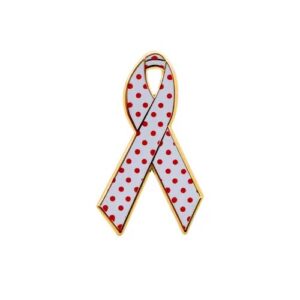

- Measles: Measles is an acute viral respiratory illness. It is characterized by a fever (as high as 105°F) and malaise, cough, coryza, and conjunctivitis. The rash usually appears about 14 days after a person is exposed.
- Rubella: Rubella is a contagious disease caused by a virus. Rubella is sometimes called “German measles,” but it is caused by a different virus from measles. The disease is no longer endemic (constantly present) in the United States; but rubella is common in other parts of the world.
- Urticaria: Urticaria, also known as hives, welts or nettle rash, is a raised rash that appears on the skin. It may appear on one part of the body or be spread across large areas. The rash is usually very itchy and ranges in size from a few millimeters to the size of a hand.
Red and Yellow Awareness Ribbons: Colors and causes symbolize, stand for and support:
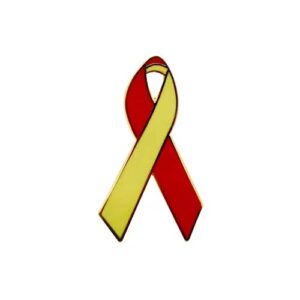

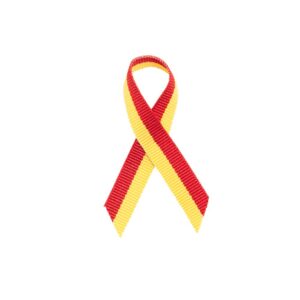
- Hepatitis C: Hepatitis C is a viral infection that causes liver inflammation, sometimes leading to serious liver damage. The Hepatitis C Virus (HCV) spreads through contaminated blood. Until recently, Hepatitis C treatment required weekly injections and oral medications that many HCV-infected people could not take because of other health problems or unacceptable side effects. Today, chronic HCV is usually curable with oral medications taken every day for two to six months. Still, about half of people with HCV do not know they are infected, mainly because they have no symptoms, which can take decades to appear. For that reason, the U.S. Centers for Disease Control and Prevention recommends a one-time screening blood test for everyone at increased risk of the infection. The largest group at risk includes everyone born between 1945 and 1965, a population five times more likely to be infected than those born in other years.
- HIV / HCV Co Infection: People with HIV who have underlying liver disease are at risk for severe disease from Hepatitis A infection. Widespread Hepatitis A outbreaks associated with person-to-person transmission have been occurring in the United States since 2016. Therefore, CDC and ACIP recommend Hepatitis A vaccination for this population.
- Neonatal Alloimmune Thrombocytopenia / NAIT: Neonatal Alloimmune Thrombocytopenia, (NAIT) is caused by maternal antibodies raised against alloantigens carried on fetal platelets. Although many cases are mild, NAIT is a significant cause of morbidity and mortality in newborns and is the most common cause of intracranial hemorrhage in full-term infants.
Red, White and Blue Awareness Ribbons: Colors and causes symbolize, stand for and support:


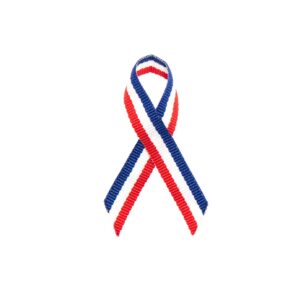
- Medicare for All: Medicare for All would establish a universal single-payer national health insurance system in the United States. Under a single-payer system, most medical care would be paid for by the federal government, ending the need for private health insurance and premiums, and re-casting private insurance companies as providing purely supplemental coverage, to be used when non-essential care is sought. The national system would be paid for in part through taxes replacing insurance premiums, but also by savings realized through the provision of preventive universal health care and the elimination of insurance company overhead and hospital billing costs.
- Military and Troop Support: Military and Troop Support, or Deployed Soldier Support, shows support for their efforts and freedom throughout the world. The alternate colors for Military and Troop Support are camouflage and yellow.
- Patriotism: The dictionary definition for patriotism is described as "love for or devotion to one's country." Wearing a red, white and blue awareness ribbon demonstrates patriotism.
- Remembering 9/11: 9/11 attacks were a series of airline hijackings and suicide attacks committed in 2001 by 19 militants associated with the Islamic extremist group al-Qaeda against targets in the United States. 9/11 was the deadliest terrorist attack on American soil in United States history.
- Remembering September 11, 2001: September 11 attacks, also known as 9/11 attacks, were the deadliest terrorist attack on U.S. soil. The attacks involved the hijacking of four planes, three of which were used to strike significant U.S. sites. The September 11 attacks caused extensive death and destruction. Approximately 2,750 people were killed in New York, 184 at the Pentagon, and 40 in Pennsylvania, where one of the hijacked planes crashed after the passengers attempted to retake the plane.
Road Distracted Driving Awareness Ribbons: Colors and causes symbolize, stand for and support:
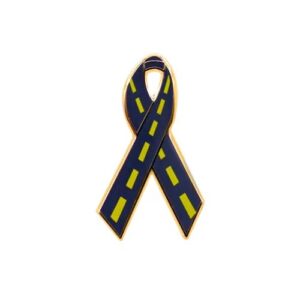

- Distracted Driving: Distracted Driving is any activity that diverts attention from driving, including talking or texting on the phone, eating and drinking, talking to people in the vehicle, fiddling with the stereo, entertainment or navigation system. In other words, anything that takes attention away from the task of safe driving.
- Texting While Driving: Texting is the most alarming driving distraction. Sending or reading a text takes the driver's eyes off the road for 5 seconds. At 55 mph, that is like driving the length of an entire football field with your eyes closed. You cannot drive safely unless the task of driving has your full attention. Any non-driving activity you engage in is a potential distraction and increases the risk of having an accident.
Royal Blue and Green Awareness Ribbons: Colors and causes symbolize, stand for and support:
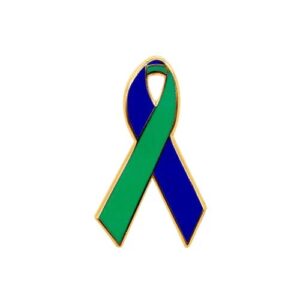

- Intercranial Hypertension: Intracranial Hypertension literally means that the pressure of cerebrospinal fluid (CSF) within the skull is too high. Intracranial means “within the skull.” Hypertension means “high fluid pressure.”
Sea Green Awareness Ribbons: Colors and causes symbolize, stand for and support:
Silver Awareness Ribbons: Colors and causes symbolize, stand for and support:
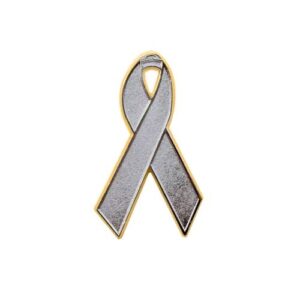





- Bell's Palsy: Bell's Palsy causes sudden, temporary weakness in the facial muscles. This makes half of the face appear to droop. Consequently, a smile is one-sided, and the eye on that side resists closing. Bell's Palsy, also known as Facial Palsy, can occur at any age. The exact cause is unknown. It is believed to be the result of swelling and inflammation of the nerve that controls the muscles on one side of the face. It may also be due to a reaction that occurs after a viral infection. For most people, Bell's Palsy is temporary.
- Brain Disabilities: Neurological or Brain Disabilities include a wide range of disorders, such as epilepsy, learning disabilities, neuromuscular disorders, autism, ADHD, brain tumors, and cerebral palsy. Some neurological conditions are congenital, emerging before birth.
- Brain Diseases: Brain diseases come in different forms. Infections, trauma, stroke, seizures, and tumors are some of the major categories of brain diseases.
- Brain Disorders: A Neurological or Brain Disorder is any disorder of the nervous system. Structural, biochemical or electrical abnormalities in the brain, spinal cord or other nerves can result in a range of symptoms. Examples of symptoms include paralysis, muscle weakness, poor coordination, loss of sensation, seizures, confusion, pain and altered levels of consciousness. There are many recognized neurological disorders, some relatively common, but many are rare.
- Dyslexia: Dyslexia is a specific learning disability that is neurobiological in origin. It is characterized by difficulties with accurate and/or fluent word recognition and by poor spelling and decoding abilities. These difficulties typically result from a deficit in the phonological component of language that is often unexpected in relation to other cognitive abilities and the provision of effective classroom instruction. Secondary consequences may include problems in reading comprehension and reduced reading experience that can impede growth of vocabulary and background knowledge. The alternate color for Dyslexia is red.
- Encephalitis: Encephalitis is inflammation of the brain. There are several causes, but the most common is viral infection. Encephalitis often causes only mild flu-like signs and symptoms, such as a fever or headache, or no symptoms at all. Sometimes the flu-like symptoms are more severe. Encephalitis can also cause confused thinking, seizures, or problems with senses or movement. Rarely, encephalitis can be life-threatening.
- Facial Paralysis: Facial Paralysis is a loss of facial movement due to nerve damage. A person's facial muscles may appear to droop or become weak. Facial paralysis can happen on one or both sides of the face. Common causes of facial paralysis include infection or inflammation of the facial nerve.
- Locked-In Syndrome: Locked-In Syndrome is a rare neurological disorder in which there is complete paralysis of all voluntary muscles except for the ones that control the movements of the eyes. Individuals with Locked-In Syndrome are conscious and awake but have no ability to produce movements (outside of eye movement) or to speak. Cognitive function is usually unaffected.
- Niemann Pick Disease Type C: Niemann-Pick Disease Type C (NPC) is a rare progressive genetic disorder characterized by an inability of the body to transport cholesterol and other fatty substances (lipids) inside of cells. This leads to the abnormal accumulation of these substances within various tissues of the body, including brain tissue. The accumulation of these substances damages the affected areas.
- Parkinson's Disease: Parkinson's Disease is a neurodegenerative disorder that affects predominately dopamine-producing neurons in a specific area of the brain called substantia nigra. Symptoms generally develop slowly over years.
- Schizophrenia: Schizophrenia is a chronic brain disorder that affects less than 1% of the U.S. population. When Schizophrenia is active, symptoms can include delusions, hallucinations, trouble with thinking and concentration, and lack of motivation.
- VACTERL: VACTERL association is a disorder that affects many body systems. VACTERL stands for vertebral defects, anal atresia, cardiac defects, tracheo-esophageal fistula, renal anomalies, and limb abnormalities. People diagnosed with VACTERL association typically have at least three of these characteristic features. Affected individuals may have additional abnormalities that are not among the characteristic features of VACTERL association.
Silver and Blue Awareness Ribbons: Colors and causes symbolize, stand for and support:


- Agenesis of Corpus Callosum: Agenesis of Corpus Callosum is a rare disorder that is present at birth (congenital). It is characterized by a partial or complete absence (agenesis) of an area of the brain that connects the two cerebral hemispheres. This part of the brain is normally composed of transverse fibers.
- Brachial Plexus Injuries: The Brachial Plexus is the network of nerves that sends signals from the spinal cord to the shoulder, arm and hand. A brachial plexus injury occurs when these nerves are stretched, compressed, or damaged extensively. The alternate color for Brachial Plexus Injuries is blue.
- Fetal Alcohol Spectrum Disorders: Fetal Alcohol Spectrum Disorders is an umbrella term describing the range of effects that can occur in an individual whose mother drank alcohol during pregnancy. These effects may include physical, mental, behavioral, and/or learning disabilities with possible lifelong implications.
Silver and Gold Awareness Ribbons: Colors and causes symbolize, stand for and support:
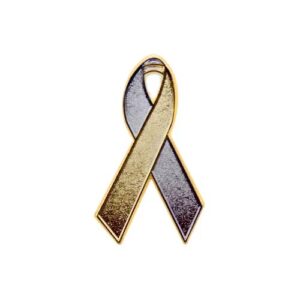

- Deafness: Deafness is partial or complete hearing loss. Levels of hearing impairment vary from a mild to a total loss of hearing. There are four levels of deafness or hearing impairment. These are: Mild deafness or mild hearing impairment where people may find it hard to understand the words other people are saying, especially if there is a lot of background noise; Moderate deafness or moderate hearing impairment where the person finds following a conversation very difficult without using a hearing aid; Severe deafness where the person is severely deaf and must either lip-read or use sign language in order to communicate, even if they have a hearing aid; Profound deafness where some people cannot hear anything at all.
- Hearing Disorders: There are four major types of hearing loss, including Auditory Processing Disorders, Conductive Hearing Loss, Sensorineural Hearing Loss, and Mixed Hearing Loss.
- Hearing Impairments: Hearing loss affects people of all ages and can be caused by many different factors. The three basic categories of hearing loss are Sensorineural Hearing Loss, Conductive Hearing Loss and Mixed Hearing Loss.
- Hearing Loss: Hearing Loss is a common problem caused by noise, aging, disease, and heredity. People with hearing loss may find it hard to have conversations with friends and family. They may also have trouble understanding a doctor’s advice, responding to warnings, and hearing doorbells and alarms.
- Hyperacusis: Hyperacusis (or Hyperacousis) is a highly debilitating hearing disorder characterized by an increased sensitivity to certain frequencies and volume ranges of sound. A person with severe hyperacusis has difficulty tolerating everyday sounds, which become painful or loud. Hyperacusis is often coincident with tinnitus. Both conditions have a prevalence of about 10–15% and hearing loss as a major risk factor.
- Meniere's Disease: Meniere's Disease is a disorder of the inner ear that causes episodes in which one feels as if they're spinning (vertigo), and has fluctuating hearing loss with a progressive, ultimately permanent loss of hearing, ringing in the ear (tinnitus), and sometimes a feeling of fullness or pressure in the ear. In most cases, Meniere's Disease affects only one ear.
- Tinnitus: Tinnitus is the perception of noise or ringing in the ears. A common problem, tinnitus affects about 1 in 5 people. Tinnitus is not a condition itself. Rather, it's a symptom of an underlying condition, such as age-related hearing loss, ear injury or a circulatory system disorder.
- Vertigo: Vertigo is a symptom that causes a person to feel like they or the world around them is spinning or moving when they are not. Vertigo can feel like swaying or spinning, and can be accompanied by nausea, vomiting, sweating, or difficulty walking.
Teal Awareness Ribbons: Colors and causes symbolize, stand for and support:
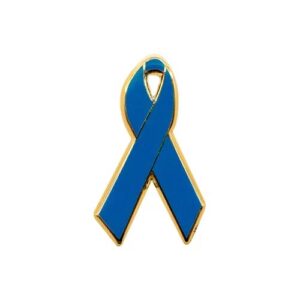

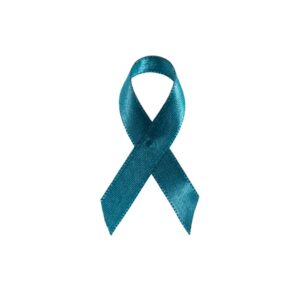
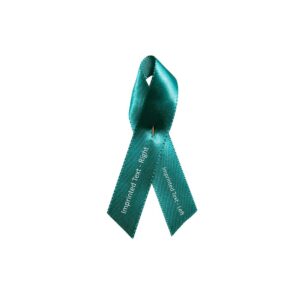


- Addiction Recovery: Yes, addiction is a treatable disorder. Research on the science of addiction and the treatment of substance use disorders has led to the development of research-based methods that help people to stop using drugs and resume productive lives, also known as being in recovery.
- Adult Survivors of Child Sexual Abuse: Many Adult Survivors of Child Sexual Abuse manage things by working hard to “forget” or not think about their prior sexual abuse. Unfortunately, some adult survivors avoid working through their traumas by hurting themselves with drugs and alcohol, excessive exercise, unhealthy relationships with food, or harming themselves in other ways. These means of coping help the survivor to avoid the pain of past memories of abuse.
- Agoraphobia: Agoraphobia is a type of anxiety disorder in which a person fears and avoids places or situations that might cause panic and the feelings of being trapped, helpless or embarrassed. Those with agoraphobia fear an actual or anticipated situation, such as using public transportation, being in open or enclosed spaces, standing in line, or being in a crowd. The anxiety is caused by fear that there is no easy way to escape or get help if the anxiety intensifies. Most people who have agoraphobia develop it after having one or more panic attacks, causing them to worry about having another attack and avoid the places where it may happen again. People with agoraphobia often have a hard time feeling safe in any public place, especially where crowds gather.
- Allergies: Allergies occur when the immune system overreacts to a substance that is usually harmless to other people. These substances are called allergens and can be found in dust, pollen, mold, pet dander, food, and some medications.
- Anaphylaxis: Anaphylaxis is a serious allergic response that often involves swelling, hives, lowered blood pressure and in severe cases, shock. If anaphylactic shock is not treated immediately, it can be fatal. A major difference between anaphylaxis and other allergic reactions is that anaphylaxis typically involves more than one system of the body.
- Anxiety Disorders: Anxiety Disorders are a group of mental illnesses, and the distress they cause can keep sufferers from carrying on with their normal life. Anxiety disorder is an umbrella term that includes different conditions: Panic Disorder, Social Anxiety Disorder, specific phobias and Generalized Anxiety Disorder.
- Autonomic Dysfunction: The most common Autonomic Dysfunction occurs in the cardiovascular control sphere and consists of an abnormal vasovagal response that leads to syncope (fainting). Other common manifestations are related to Postural Tachycardia Syndrome (POTS) or changes seen with Parkinson Disease and other Parkinsonisms. The alternate color for Autonomic Dysfunction is turquoise.
- Batten Disease / Neuronal Ceroid Lipofuscinosis: Batten Disease / Neuronal Ceroid Lipofuscinosis refers to a group of conditions that affect the nervous system. Signs and symptoms vary widely between the forms but generally include a combination of dementia, vision loss, and epilepsy. Although Neuronal Ceroid Lipofuscinosis was historically classified according to the age of onset and clinical symptoms, the most recent classification system is primarily based on the underlying genetic cause.
- Child Sexual Abuse: Sexual Abuse can include many different things, from touching a victim in a sexual manner to forcing a victim to touch the perpetrator in a sexual way to making a victim look at sexual body parts or watch sexual activity. Sexual abuse of a child is a criminal act.
- Child Sexual Assault: The term sexual assault can describe a range of criminal acts that are sexual in nature, from unwanted touching and kissing, to rubbing, groping or forcing the victim to touch the perpetrator in sexual ways. Sexual assault overlaps with rape because the term includes rape.
- CREST Syndrome: CREST (calcinosis, Raynaud phenomenon, esophageal dysmotility, sclerodactyly, and telangiectasia) syndrome is a member of the heterogeneous group of sclerodermas, and its name is an acronym for the cardinal clinical features of the syndrome.
- Depersonalization Disorder: Depersonalization/derealization disorder involves a persistent or recurring feeling of being detached from one's body or mental processes, like an outside observer of one's life (depersonalization), and/or a feeling of being detached from one's surroundings (derealization).
- Desmoid Tumor: Desmoid Tumors are noncancerous growths that occur in the connective tissue. Desmoid tumors most often occur in the abdomen, arms and legs. Another term for desmoid tumors is aggressive fibromatosis. Some desmoid tumors are slow growing and do not require immediate treatment.
- Dissociative Identity Disorder: Dissociative Identity Disorder is thought to be a complex psychological condition that is likely caused by many factors, including severe trauma during early childhood. The dissociative aspect is thought to be a coping mechanism. In other words, the person literally dissociates himself from a situation or experience that is too violent, traumatic, or painful to assimilate with his conscious self.
- Dysphagia: Dysphagia is the medical term for swallowing difficulties. Some people with dysphagia have problems swallowing certain foods or liquids, while others cannot swallow at all. Other signs of dysphagia include coughing or choking when eating or drinking or bringing food back up sometimes through the nose. The alternate color for Dysphagia is blue.
- Ectodermal Dysplasia: Ectodermal Dysplasias are a group of more than 180 disorders that affect the outer layer of tissue of the embryo that helps make up the skin, sweat glands, hair, teeth, and nails. Symptoms of ectodermal dysplasia can range from mild to severe and may include teeth abnormalities; brittle, sparse or absent hair; abnormal fingernails; inability to perspire; various skin problems; and other symptoms. The alternate color for Ectodermal Dysplasia is blue.
- Erdheim-Chester Disease: Erdheim-Chester disease (ECD) is a rare blood disorder that occurs when the body makes too many white blood cells called histiocytes. ECD can affect multiple organs and cause various symptoms or even no symptoms, making diagnosis tricky. Current treatments include targeted therapy, immunotherapy and chemotherapy.
- Fallopian Tube Cancer: Fallopian Tube Cancer, Ovarian Epithelial Cancer, and Primary Peritoneal Cancer form in the same kind of tissue and are treated in the same way. These cancers are often advanced at diagnosis. Less common types of Ovarian Tumors include Ovarian Germ Cell Tumors and Ovarian Low Malignant Potential Tumors.
- Food Allergies: Food Allergies or food Intolerances affect nearly everyone at some point. But only about 5% of children have clinically proven allergic reactions to foods. In teens and adults, food allergies occur in about 4% of the total population. This difference between the clinically proven prevalence of food allergy and the public perception of the problem is in part due to reactions called "food intolerances" rather than food allergies. A food allergy, or hypersensitivity, is an abnormal response to a food that is triggered by the immune system.
- Fragile X Syndrome: Fragile X Syndrome is a genetic condition involving changes in part of the X chromosome. This condition causes a range of developmental problems including learning disabilities and cognitive impairment. It is the most common form of inherited intellectual disability in males and a significant cause of intellectual disability in females.
- Generalized Anxiety Disorder: Generalized Anxiety Disorder is characterized by persistent and excessive worry about a number of different things. People with generalized anxiety disorder may anticipate disaster and may be overly concerned about money, health, family, work, or other issues. Individuals with generalized anxiety disorder find it difficult to control their worry. They may worry more than seems warranted about actual events or may expect the worst even when there is no apparent reason for concern.
- Heterotaxy Syndrome: Heterotaxy is a condition characterized by internal organs that are not arranged as would be expected in the chest and abdomen. Organs are expected to be in a particular position inside of the body, known as situs solitus. Heterotaxy occurs when the organs are not in this typical orientation but are instead in different positions in the body. This most commonly causes complications with the heart, lungs, liver, spleen, and intestines.
- Hirsutism: Hirsutism is a condition in women that results in excessive growth of dark or coarse hair in a male-like pattern, on the face, chest and back. With hirsutism, extra hair growth often arises from excess male hormones (androgens), primarily testosterone.
- Interstitial Cystitis / IC: Interstitial Cystitis, also called painful bladder syndrome, is a chronic condition causing bladder pressure, bladder pain and sometimes pelvic pain. The pain ranges from mild discomfort to severe. Although signs and symptoms of interstitial cystitis may resemble those of a chronic urinary tract infection, there is usually no infection.
- Lichen Planus: Lichen planus is a common disease that causes inflammation (swelling and irritation) on the skin or inside the mouth. On the skin, lichen planus causes a rash that is usually itchy. Inside the mouth, it may cause burning or soreness.
- Lichen Sclerosus: Lichen Sclerosus is a condition that causes patchy, discolored, thin skin. It usually affects the genital and anal areas. Anyone can get lichen sclerosus but postmenopausal women are at higher risk. It is not contagious and cannot be spread through sexual contact.
- Martin-Bell Syndrome:Martin-Bell Syndrome is another name for Fragile X Syndrome, a genetic disorder that causes intellectual disability, autism, and other health issues.
- Military Sexual Assault and Trauma: The military has long struggled with addressing sexual assault among troops. Concerns spiked in 2013 when the Pentagon released a report that estimated the number of sexual assaults increased 35% from 2010 to 2012 to 26,000 victims.
- MRSA: Methicillin-Resistant Staphylococcus Aureus (MRSA) infection is caused by a type of staph bacteria that's become resistant to many of the antibiotics used to treat ordinary staph infections. Most MRSA infections occur in people who have been in hospitals or other health care settings, such as nursing homes and dialysis centers. Another type of MRSA infection has occurred in the wider community among healthy people. This form, community-associated MRSA, often begins as a painful skin boil. It is spread by skin-to-skin contact. At-risk populations include groups such as high school wrestlers, childcare workers and people who live in crowded conditions.
- Myasthenia Gravis: Myasthenia Gravis is a chronic condition that causes muscles to tire and weaken easily. This waxing-and-waning weakness of muscles, worsening with use and improving with rest, is a hallmark of this disease. The disease most commonly affects muscles that control eye and eyelid movement. The majority will go on to develop weakness in other muscle groups within one or two years.
- Obsessive-Compulsive Disorder / OCD: Obsessive-Compulsive Disorder is a type of mental illness. People with OCD can have either obsessive thoughts and urges or compulsive, repetitive behaviors. Some have both obsessions and compulsions. OCD is not about habits like biting your nails or always thinking negative thoughts. The disorder can affect a person's job, school, and relationships and keep a person from living a normal life. These thoughts and actions are beyond a person's control.
- Occipital Neuralgia: Occipital Neuralgia is a condition in which the nerves that run from the top of the spinal cord up through the scalp, called the occipital nerves, are inflamed or injured. One might feel pain in the back of the head or the base of the skull.
- Orthostatic Hypotension: Orthostatic hypotension, also known as postural hypotension, is a sudden drop in blood pressure that occurs when standing up or sitting up from a lying down position. It can cause dizziness, lightheadedness, or fainting.
- Ovarian Cancer, Adult: Ovarian Cancer is a disease in which malignant (cancer) cells form in tissues of the ovary. Most ovarian cancers are either Ovarian Epithelial Cancers (cancer that begins in the cells on the surface of the ovary) or malignant germ cell tumors (cancer that begins in egg cells). Fallopian Tube Cancer and Primary Peritoneal Cancer are similar to Ovarian Epithelial Cancer and are staged and treated the same way.
- Ovarian Cancer, Childhood: Ovarian Cancer is a disease in which malignant cells form in the ovary. Most ovarian tumors in children are benign (not cancer). They occur most often in females aged 15 to 19 years. The alternate color for ovarian cancer in children is gold.
- Panic Disorder: Panic Disorder is diagnosed in people who experience spontaneous seemingly out-of-the-blue panic attacks and are very preoccupied with the fear of a recurring attack. Panic attacks occur unexpectedly, sometimes even when waking up from sleep. Panic disorder usually begins in adulthood, but children can also have panic disorder, and many children experience panic-like symptoms (“fearful spells”).
- Phosphoglycerate Kinase Deficiency: Phosphoglycerate kinase deficiency is a genetic disorder that affects the body's ability to break down the simple sugar glucose, which is the primary energy source for most cells. Researchers have described two major forms of the condition. The most common form is sometimes called the hemolytic form.
- Pierre Robin Sequence: Pierre Robin syndrome (PRS) is an uncommon birth defect. Babies with this disorder may have underdeveloped jaws and difficulty breathing. Their tongues may fall to the back of their throats. PRS may be mild or severe. In some cases, babies do not need treatment. Other times, they may need surgery and ongoing medical care.
- Polycystic Kidney Disease / PKD: Polycystic Kidney Disease is an inherited disorder in which clusters of cysts develop primarily within the kidneys, causing the kidneys to enlarge and lose function over time. Cysts are noncancerous round sacs containing fluid. The cysts vary in size, and they can grow very large. Having many cysts or large cysts can damage the kidneys.
- Polycystic Ovarian Syndrome / PCOS: Polycystic Ovary Syndrome (PCOS) is a hormonal disorder common among women of reproductive age. Women with PCOS may have infrequent or prolonged menstrual periods or excess male hormone (androgen) levels. The ovaries may develop numerous small collections of fluid and fail to regularly release eggs.
- Post Traumatic Stress Disorder / PTSD: Post Traumatic Stress Disorder is a mental health condition that is triggered by a terrifying event, either experiencing it or witnessing it. Symptoms may include flashbacks, nightmares and severe anxiety, as well as uncontrollable thoughts about the event.
- Postural Orthostatic Tachycardia Syndrome / POTS: Postural orthostatic tachycardia syndrome (POTS) is a chronic condition that causes an abnormally rapid increase in heart rate when standing from a sitting or lying position. This can lead to symptoms like dizziness, lightheadedness, and fainting.
- Premature Ovarian Insufficiency: Premature Ovarian Failure, also known as Primary Ovarian Insufficiency, is a loss of normal function of the ovaries before age 40. If the ovaries fail, they do not produce normal amounts of the hormone estrogen or release eggs regularly. Infertility is a common result. Premature Ovarian Failure is sometimes referred to as premature menopause, but the two conditions are not the same. Women with premature ovarian failure can have irregular or occasional periods for years and might even become pregnant. Women with premature menopause stop having periods and cannot become pregnant.
- Premenstrual Dysphoric Disorder: Premenstrual Dysphoric Disorder is a much more severe form of Premenstrual Syndrome. It may affect women of childbearing age. The main symptoms that distinguish Premenstrual Mood Dysphoric Disorder from other mood disorders or menstrual conditions is when symptoms start and how long they last. Symptoms of PMDD are so severe that it affects one's ability to function at home, work and in relationships.
- Primary Peritoneal Cancer: Primary Peritoneal Cancer is a relatively rare cancer that develops most commonly in women. Primary peritoneal cancer is a close relative of epithelial ovarian cancer, which is the most common type of malignancy that affects the ovaries. The cause of primary peritoneal cancer is unknown
- Progressive Supranelear Palsy: Progressive Supranuclear Palsy is a degenerative neurologic disease due to damage to nerve cells in the brain. Signs and symptoms vary but may include loss of balance, blurred vision, problems controlling eye movement, changes in mood, behavior and judgment, cognitive decline, and slowing and slurred speech.
- Rape: Rape is forced sexual intercourse, sexual assault, or sexual intercourse between an adult and a minor. Rape may be heterosexual (involving members of opposite sexes) or homosexual (involving members of the same sex). Rape involves insertion of an erect penis or an inanimate object into the female vagina or the male anus. Legal definitions of rape may also include forced oral sex and other sexual acts.
- Scleroderma: Scleroderma is a group of rare diseases that involve the hardening and tightening of the skin and connective tissues, the fibers that provide the framework and support for the body. In some people, scleroderma affects only the skin. But in many people, scleroderma also harms structures beyond the skin, such as blood vessels, internal organs and the digestive tract. Signs and symptoms vary depending on which structures are affected.
- Sexual Assault: The term Sexual Assault refers to sexual contact or behavior that occurs without explicit consent of the victim. Some forms of sexual assault include attempted rape, fondling or unwanted sexual touching, forcing a victim to perform sexual acts, such as oral sex or penetrating the perpetrator’s body, or penetration of the victim’s body, also known as rape.
- Sexual Assault on College Campuses: Sexual Assault on College Campuses is a common problem that often goes unreported. It includes any unwanted sexual activity, from unwanted touching to rape. Alcohol and drugs often play a role in sexual assault on campuses.
- Sexual Violence: Sexual Violence is a serious public health and human rights problem with both short- and long-term consequences on both women's physical, mental, and sexual and reproductive health. Whether sexual violence occurs in the context of an intimate partnership, within the larger family or community structure, or during times of conflict, it is a deeply violating and painful experience for the survivor. Men and boys who have been sexually assaulted may experience the same effects of sexual assault as other survivorsvand may face other challenges that are more unique to their experience. The alternate color for Sexual Violence is teal and purple.
- Smith-LemliOpitz Syndrome: Smith-Lemli-Opitz syndrome is a developmental disorder that affects many parts of the body. This condition is characterized by distinctive facial features, small head size (microcephaly), intellectual disability or learning problems, and behavioral problems.
- Social Anxiety: The latest government epidemiological data show social anxiety affects about 7% of the population at any given time. The chances of developing social anxiety disorder at any time during the lifespan stands slightly above 13%. Social anxiety is the fear of social situations that involve interaction with other people.
- Stress Disorders: Trauma- and stress-related disorders result from exposure to a traumatic or stressful event. Specific disorders include acute stress disorder and post-traumatic stress disorder. These disorders cause similar symptoms but differ in how long they last.
- Substance Abuse Recovery: The Substance Abuse Recovery model describes five stages that people go through when changing their behavior: pre-contemplation (not ready), contemplation (getting ready), preparation (ready), action and maintenance. The model assumes that everyone goes through a similar process when changing a behavior.
- Systemic Scleroderma: Systemic Scleroderma is an autoimmune disorder that affects the skin and internal organs. Autoimmune disorders occur when the immune system malfunctions and attacks the body's own tissues and organs. The word "scleroderma" means hard skin in Greek, and the condition is characterized by the buildup of scar tissue.
- Systemic Sclerosis: Systemic Sclerosis is a multi-system disease which results in fibrosis and vascular abnormalities in association with autoimmune changes, affecting the connective tissue in many parts of the body. These lead to the breakdown of the skin, subcutaneous tissue, muscles and internal organs (e.g. digestive tract, heart, lungs, and kidneys).
- Tourette Syndrome: Tourette Syndrome is a disorder that involves repetitive movements or unwanted sounds (tics) that cannot be easily controlled. Males are about three to four times more likely than females to develop Tourette Syndrome.
- Trigeminal Neuralgia: Trigeminal Neuralgia is a chronic pain condition that affects the trigeminal nerve, which carries sensation from the face to the brain. Even mild stimulation of the face, such as from brushing one's teeth or putting on makeup, may trigger a jolt of excruciating pain. Trigeminal neuralgia affects women more often than men, and it is more likely to occur in people who are older than fifty.
Teal and Purple Awareness Ribbons: Colors and causes symbolize, stand for and support:
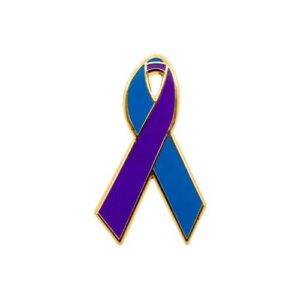

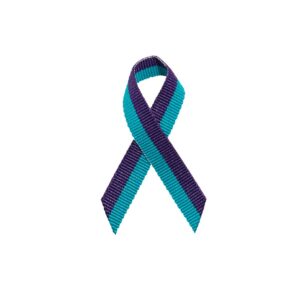
- Domestic Violence / Sexual Assault: Perpetrators who are physically violent toward their intimate partners are often sexually abusive as well. Women who are disabled, pregnant, or attempting to leave their abusers are at greatest risk for intimate partner rape.
- Necrotizing Fasciitis: Necrotizing Fasciitis, also known as flesh-eating disease, is a rare but serious bacterial infection that causes the death of soft tissue in the body.
- Suicide: Nearly 1 million people die by suicide globally each year. Suicide is one of the top ten leading causes of death across all age groups. Worldwide, suicide ranks among the three leading causes of death among adolescents and young adults. 988 is the Suicide and Crisis Lifeline.
- Suicide Prevention: Suicide Prevention is a collection of efforts to reduce the risk of suicide. Suicide is often preventable, and the efforts to prevent it may occur at the individual, relationship, community, and society level. 988 is the Suicide and Crisis Lifeline.
- Women Murdered by Domestic Violence: Every month, an average of 70 women in the United States are shot and killed by an intimate partner. While intimate partner violence is a global issue, the intersection between gun violence and intimate partner violence is uniquely American.
Teal, Purple and Rainbow Awareness Ribbons: Colors and causes symbolize, stand for and support:


- LGBTQ+ Suicide Prevention: The LGBTQ+ community is diverse and made up of different experiences, identities, and challenges. However, members of the community are disproportionately at-risk for suicide and other mental health struggles. Over 80% of LGBTQ+ youth have been assaulted or threatened, and every instance of victimization in an LGBTQ+ person’s life more than doubles the likelihood of self-harming. The first transgender suicide hotline is now up and running in the United States. You can reach Trans Lifeline at 877-565-8860. The alternate colors for LGBTQ+ Suicide Prevention is teal and purple.
Teal and White Awareness Ribbons: Colors and causes symbolize, stand for and support:
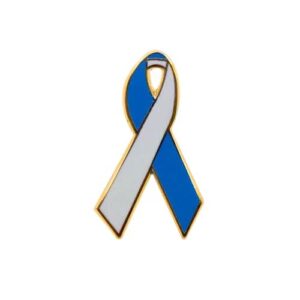

- Cervical Cancer, Adult: Cervical Cancer is a type of cancer that occurs in the cells of the cervix, the lower part of the uterus that connects to the vagina. Various strains of the Human Papillomavirus (HPV), a sexually transmitted infection, play a role in causing most cervical cancer.
- Cervical Cancer, Childhood: Cervical Cancer is rarely seen in children and teens. Cases of Cervical Cancer in women under 20 were seen in only about 0.2 percent of females. In very rare cases in the past, some cervical cancer was seen in girls whose mothers were treated with a drug called diethylstilbestrol (DES), which was used to prevent miscarriage. But DES has not been used with pregnant women since the early 1970s. The alternate color for Cervical Cancer in children is gold.
Teal and Yellow Awareness Ribbons: Colors and causes symbolize:
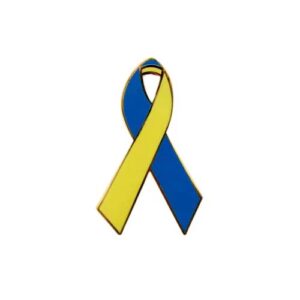

- Body Dysmorphic Disorder: Body Dysmorphic Disorder is a mental disorder characterized by the obsessive idea that some aspect of one's own body part or appearance is severely flawed and warrants exceptional measures to hide or fix their dysmorphic part on their person.
Turquoise Awareness Ribbons: Colors and causes symbolize, stand for and support:
Violet Awareness Ribbons: Colors and causes symbolize, stand for and support:
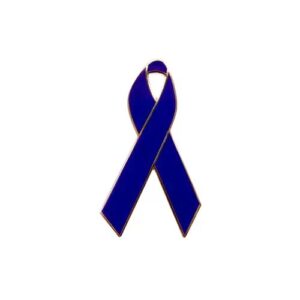

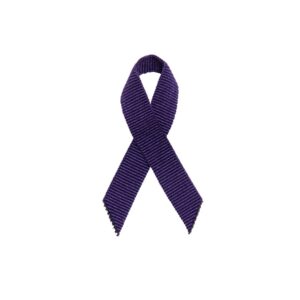


- Hodgkin Lymphoma / Hodgkin’s Lymphoma / Hodgkin’s Disease, Adult: Hodgkin Lymphoma, also called Hodgkin's Lymphoma or Hodgkin's Disease, is a cancer of the immune system that is marked by the presence of a type of cell called the Reed-Sternberg cell. The two major types of Hodgkin disease are classical Hodgkin Lymphoma and Nodular Lymphocyte-Predominant Hodgkin Lymphoma. Symptoms include the painless enlargement of lymph nodes, spleen, or other immune tissue. Other symptoms include fever, weight loss, fatigue, or night sweats.
- Hodgkin Lymphoma / Hodgkin’s Lymphoma / Hodgkin’s Disease, Childhood: Hodgkin Lymphoma, also called Hodgkin’s Lymphoma and Hodgkin Disease, is a cancer of the lymphoid system. The lymphoid system is made up of various tissues and organs, including the lymph nodes, tonsils, bone marrow, spleen, and thymus. These organs produce, store and carry white blood cells to fight infection and disease. Approximately 1,180 children and adolescents each year are diagnosed with Hodgkin Lymphoma in the United States. It has been reported in infants and very young children, but it is considered rare before the age of five. The majority of Hodgkin Lymphoma cases are in teenagers (age 15-19). Hodgkin Lymphoma is the most common cancer of teenagers and young adults. The alternate color for Hodgkin Lymphoma /Hodgkin's Lymphoma / Hodgkin's Disease in children is gold.
White Awareness Ribbons: Colors and causes symbolize, stand for and support:
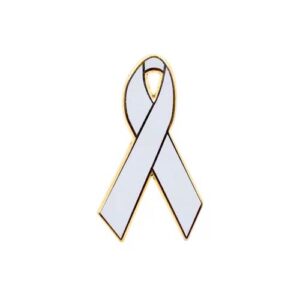





- Adoption: Related to human children, “adoption” means “the act or process of adopting a child.” But legally, adoption does not just refer to children, although that is its most popular use. In fact, adults over the age of 18 can legally be adopted as well.
- Bone Diseases: Generalized Osteoporosis is the most common form of bone disease, affecting most of the skeleton. Osteoporosis can also occur in localized parts of the skeleton because of injury or conditions that reduce muscle forces on the bone, such as limb paralysis. A lifelong lack of calcium plays a role in the development of osteoporosis. Low calcium intake contributes to diminished bone density, early bone loss and an increased risk of fractures.
- Congenital Cataracts: A Congenital Cataract is when the lens of the eye is cloudy instead of clear at birth, making it hard to see. The lens is the tissue inside the eye that helps focus the light coming into the eye. Congenital cataracts can happen in one or both eyes.
- Dental Hygiene / Dental Care: Dental and oral health is an essential part of a person's overall health and well-being. Poor oral hygiene can lead to dental cavities and gum disease, and has also been linked to heart disease, cancer, and diabetes.
- End Violence Against Women International: End Violence Against Women International (EVAWI) strives to provide victim centered, multi-disciplinary training and expert consultation on sexual assault and domestic violence.
- Holocaust Remembrance: The internationally recognized date for Holocaust Remembrance Day corresponds to the 27th day of Nisan on the Hebrew calendar. It marks the anniversary of the Warsaw Ghetto Uprising.
- Hypoxic Ischemic Encephalopathy: Hypoxic Ischemic Encephalopathy is a type of brain damage that occurs when an infant's brain does not receive enough oxygen and blood. It is a dangerous condition that requires immediate medical intervention.
- International End of Violence Against Women: This campaign, led by the UN Secretary-General and UN Women since 2008, aims to prevent and eliminate violence against women and girls around the world, calling for global action to increase awareness, promote advocacy and create opportunities for discussion on challenges and solutions.
- Make Poverty History: Make Poverty History is the name of organizations in a number of countries, which focus on issues relating to 8th Millennium Development Goal such as aid, trade and justice. The movement exists or has existed in Australia, Canada, Denmark, Finland, New Zealand, Nigeria, Norway, Romania, South Africa, Ireland, the United Arab Emirates, the United States of America, and the United Kingdom. The various national campaigns are part of the international Global Call to Action Against Poverty campaign.
- Multiple Hereditary Exostoses: Hereditary Multiple Exostosis, also known as Diaphyseal Aclasis, is a genetic condition often passed down to a child by one parent, but it can also be caused by a genetic mutation. This means it can occur on its own.
- Osteoporosis: Osteoporosis is a condition of fragile bone with an increased susceptibility to fracture. Osteoporosis weakens bone and increases risk of bones breaking. Bone mass (bone density) decreases after 35 years of age, and bone loss occurs more rapidly in women after menopause.
- Peace: Peace is a concept of societal friendship and harmony in the absence of hostility and violence. In a social sense, peace is commonly used to mean a lack of conflict and freedom from fear of violence between individuals or groups.
- Postpartum Depression / Postpartum Disorders: Postpartum Depression is a type of depression that happens after having a baby. It affects up to 15% of people. People with postpartum depression experience emotional highs and lows, frequent crying, fatigue, guilt, anxiety and may have trouble caring for their baby. Postpartum depression can be treated with medication and counseling. The alternate color for Postpartum Depression / Postpartum Disorders is teal.
- Retinoblastoma, Childhood: Retinoblastoma is a rare type of eye cancer in the retina that typically develops before the age of 5. It usually affects only one eye, but one-third of children with retinoblastoma develop cancer in both eyes. The first sign is typically a visible whiteness in the pupil called "cat's eye reflex" or leukocoria, which is particularly noticeable in photographs taken with a flash. Other signs and symptoms include strabismus; persistent eye pain, redness or irritation; and blindness or poor vision in the affected eye(s). The alternate color for Retinoblastoma in children is gold.
- Safe Motherhood: Safe Motherhood means ensuring that all women have access to the information and services they need to go safely through pregnancy and childbirth. It includes education on safe motherhood, prenatal care (care during pregnancy) and counseling with focus on high-risk pregnancies.
- Severe Combined Immunodeficiency: Severe Combined Immunodeficiency (SCID) is a very rare genetic disorder that causes life-threatening problems with the immune system. It is a type of primary immune deficiency (also called an inborn error of immunity). Various genetic changes can lead to the condition.
- Teen Pregnancy Prevention: Evidence-based teen pregnancy prevention programs reduce teen pregnancies, sexually transmitted infections, and sexual risk behaviors. The alternate color for Teen Pregnancy Prevention is pink.
- Victims of Terrorism: Terrorism is defined as the deliberate creation and exploitation of fear through violence or the threat of violence in the pursuit of political change. All terrorist acts involve violence or the threat of violence. Terrorism is specifically designed to have far-reaching psychological effects beyond the immediate victim(s) or object of the terrorist attack. Terrorism is designed to create power where there is none or to consolidate power where there is very little. Through the publicity generated by their violence, terrorists seek to obtain the leverage, influence, and power they otherwise lack to effect political change on either a local or an international scale.
- Vision Impairment: Impaired vision can range from poor vision to blindness. People whose vision cannot be corrected by ordinary glasses, contact lenses, medication, or surgery have visual impairments. People with visual impairments have difficulty with routine tasks, such as reading a newspaper, even with glasses or contact lenses. Visual impairments are associated with four main causes: cataracts, macular degeneration, glaucoma, and diabetic retinopathy.
- White Ribbon Campaign for Men Against Violence: Men and boys wearing the white ribbon declare that they will never commit, excuse, or remain silent about men's violence against women. White Ribbon is one of the world’s largest male-led campaigns to end men’s violence against women. It started in 1991 in Canada and is now active in many countries across the globe. Every year it is growing stronger as more men and boys realize that women’s and girls’ safety is their issue, too.
Yellow Awareness Ribbons: Colors and causes symbolize, stand for and support:
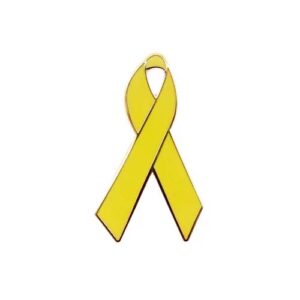

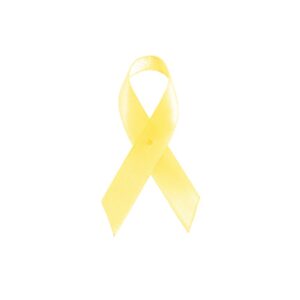



- Adenosarcoma: A tumor that is a mixture of an adenoma (a tumor that starts in the gland-like cells of epithelial tissue) and a sarcoma (a tumor that starts in bone, cartilage, fat, muscle, blood vessels, or other connective or supportive tissue).
- Adoptive Parents: An adoptive parent is someone who provides a permanent home to a child or children through a legal process. The key word is "permanent." The end result is no different from giving birth to a child. Becoming an adoptive parent comes with all the joys, heartache, laughter, frustration, responsibilities and rights that a natural or biological parent-child relationship brings.
- AIDS-Related Kaposi Sarcoma: Kaposi Sarcoma is a cancer that causes lesions (abnormal tissue) to grow in the skin; the mucous membranes lining the mouth, nose and throat; lymph nodes; or other organs. Kaposi Sarcoma is different from other cancers in that lesions may begin in more than one place in the body at the same time.
- Albinism: Albinism is a rare genetic condition caused by mutations, or changes, of certain genes that affect the amount of melanin the body produces. Melanin controls the pigmentation (color) of the skin, eyes and hair. People with albinism have extremely pale skin, eyes and hair. They are at an increased risk of vision, skin and social issues.
- Alveolar Soft Part Sarcoma: Alveolar Soft Part Sarcoma is a rare, slow growing soft tissue tumor of an unclear cause. It is among the least common sarcomas, representing 0.2-1% of large studies of soft tissue sarcomas.
- Bereaved Parents: Bereaved parents are parents who have recently experienced the death of a child or close relative.
- Bone Cancer: Bone Cancer is rare and includes several types. Some bone cancer, including Osteosarcoma and Ewing Sarcoma, are seen most often in children and young adults. Malignant Fibrous Histiocytoma of bone is a rare tumor of the bone. It is treated like osteosarcoma.
- Carbon Monoxide Poisoning: Carbon Monoxide is a colorless, odorless gas produced by burning material containing carbon. Early symptoms of Carbon Monoxide Poisoning such as headaches, nausea, and fatigue, are often mistaken for the flu because the deadly gas goes undetected in a home. Prolonged exposure can lead to brain damage and even death. Because carbon monoxide is an odorless, tasteless, and colorless gas, it is known as the "silent killer." The alternate color for Carbon Monoxide Poisoning is black and gold.
- Cardiac Sarcoma: Cardiac sarcoma is a rare, malignant tumor that starts in the heart's muscle or blood vessels. It can be primary, meaning it starts in the heart, or secondary, meaning it spreads to the heart from another part of the body. Secondary cardiac tumors are more common than primary tumors.
- Chondrosarcoma: Chondrosarcoma is a rare type of cancer that usually begins in the bones but can sometimes occur in the soft tissue near bones. Chondrosarcoma happens most often in the pelvis, hip and shoulder. More rarely, it can happen in the bones of the spine.
- Chordoma, Adult: Chordoma is a rare type of bone cancer that happens most often in the bones of the spine or the skull. It most often forms where the skull sits atop the spine (skull base) or at the bottom of the spine (sacrum).
- Chordoma, Childhood: Chordoma is a very rare type of bone tumor that forms anywhere along the spine from the base of the skull to the tailbone. In children and adolescents, chordomas develop more often in the base of the skull, making them hard to remove completely with surgery. Childhood chordoma is linked to the condition Tuberous Sclerosis, a genetic disorder in which tumors that are benign (not cancer) form in the kidneys, brain, eyes, heart, lung, and skin. The alternate color for Chordoma in childhood is gold.
- Endometriosis: Endometriosis is the presence of tissue that normally grows inside the uterus (womb) in an abnormal anatomical location. Endometriosis is very common and may not produce symptoms, or it may lead to painful menstruation. It has also been associated with infertility. Endometriosis occurs most commonly within the Fallopian tubes and on the outside of the tubes and ovaries, the outer surface of the uterus and intestines, and anywhere on the surface of the pelvic cavity. It can also be found, less often, on the surface of the liver, in old surgery scars or, very rarely, in the lung or brain.
- Epithelioid Sarcoma: A rare type of cancer that usually begins as a slow-growing, firm lump in the deep soft tissue or skin of the arms, hands, or fingers. It may also occur in the legs, trunk, or head and neck. The lump is usually painless and there may be an ulcer in the skin covering the lump. Epithelioid sarcoma may spread to nearby tissue, lymph nodes, or other parts of the body. It often recurs (comes back) after treatment. Epithelioid sarcoma usually occurs in young adults. It is a type of soft tissue sarcoma.
- Ewing Sarcoma: Ewing Sarcoma is a type of cancer that forms in bone or soft tissue. It is also called Peripheral Primitive Neuroectodermal Tumor and pPNET.
- Gastritis: Gastritis is a general term for a group of conditions with one thing in common, which is inflammation of the lining of the stomach. The inflammation of gastritis is most often the result of infection with the same bacterium that causes most stomach ulcers or the regular use of certain pain relievers.
- Gilbert Syndrome: People with Gilbert's Syndrome inherit a mutated gene that affects the liver’s ability to process bilirubin, a waste product that forms during the breakdown of old red blood cells. Jaundice (yellowish skin and eyes) occurs when too much bilirubin builds up in blood. Because this liver disease does not cause serious problems, treatment is not necessary.
- Kaposi Sarcoma: Kaposi Sarcoma is a cancer that causes lesions (abnormal tissue) to grow in the skin; the mucous membranes lining the mouth, nose, and throat; lymph nodes; or other organs. The lesions are usually purple and are made of cancer cells, new blood vessels, red blood cells, and white blood cells. Kaposi Sarcoma is different from other cancers in that lesions may begin in more than one place in the body at the same time.
- Liposarcoma: Liposarcomas are a rare type of cancer that develops in the fatty tissue. This type of tumor can grow anywhere in the body. Common places include the abdomen, thigh, and behind the knee. A liposarcoma is a malignant tumor. This means the cancer can spread to other areas, including vital organs.
- Malignant Fibrous Histiocytoma of Bone and Osteosarcoma: Osteosarcoma and Malignant Fibrous Histiocytoma of the bone are diseases in which malignant cells form in bone. Osteosarcoma usually starts in osteoblasts, which are a type of bone cell that becomes new bone tissue. Osteosarcoma is most common in adolescents. It commonly forms in the ends of the long bones of the body, which include bones of the arms and legs. In children and adolescents, it often forms in the long bones, near the knee. Rarely, osteosarcoma may be found in soft tissue or organs in the chest or abdomen. Osteosarcoma is the most common type of bone cancer.
- Microcephaly: Microcephaly is a rare neurological condition in which a person's head is significantly smaller than expected based on standardized charts. Some cases of microcephaly are detected at birth, while others develop in the first few years of life.
- Missing Persons: Anyone whose whereabouts cannot be established is considered as missing until located, and their well-being or otherwise confirmed. All reports of missing people sit within a continuum of risk from ‘no apparent risk' (absent) through to high-risk cases that require immediate, intensive action. The alternate color for Missing Persons is green.
- Myxoid Liposarcoma: Myxoid/Round Cell Liposarcoma is one of several types of liposarcoma. Liposarcoma is a rare cancer that grows in the cells that store fat in the body. Myxoid Liposarcoma usually grows in the arms and legs. These tumors grow slowly, and they can spread to other parts of the body.
- Obesity: A person has traditionally been considered to be obese if they are more than 20 percent over their ideal weight. That ideal weight must consider the person's height, age, sex, and build. Obesity has been more precisely defined by the National Institutes of Health as a BMI of 30 and above. (A BMI of 30 is about 30 pounds overweight.) Obesity is often multifactorial, based on both genetic and behavioral factors. Accordingly, treatment of obesity usually requires more than just dietary changes. Exercise, counseling and support, and sometimes medication can supplement diet to help patients conquer weight problems. Extreme diets, on the other hand, can actually contribute to increased obesity.
- Osteosarcoma: Osteosarcoma is a type of bone cancer that begins in the cells that form bones. Osteosarcoma is most often found in the long bones — more often the legs, but sometimes the arms. However, it can start in any bone. In very rare instances, it occurs in soft tissue outside the bone.
- Rhabdomyosarcoma, Adult: Rhabdomyosarcoma is a rare type of cancer that forms in soft tissue, specifically skeletal muscle tissue or sometimes hollow organs such as the bladder or uterus. Rhabdomyosarcoma can occur at any age, but it most often affects children.
- Rhabdomyosarcoma, Childhood: Childhood soft tissue sarcoma is a disease in which malignant (cancer) cells form in soft tissues of the body. Soft tissue sarcoma may be found anywhere in the body. In children, the tumors form most often in the arms, legs, or trunk (chest and abdomen). Soft tissue sarcoma in children may respond differently to treatment and may have a better prognosis than soft tissue sarcoma in adults. The alternate color for Rhabdomyosarcoma in children is gold.
- Soft Tissue Sarcoma, Adult: Soft Tissue Sarcoma is a broad term for cancers that start in soft tissues (muscles, tendons, fat, lymph and blood vessels, and nerves). These cancers can develop anywhere in the body but are found mostly in the arms, legs, chest, and abdomen. Adult soft tissue sarcoma is a disease in which malignant (cancer) cells form in the soft tissues of the body.
- Soft Tissue Sarcoma, Childhood: Childhood soft tissue sarcoma is a disease in which malignant cells form in soft tissues of the body. The alternate color for Sarcoma in children is gold.
- Spina Bifida: Spina Bifida is a birth defect that occurs when the spine and spinal cord do not form properly. It falls under the broader category of Neural Tube Defects. The neural tube is the embryonic structure that eventually develops into the baby's brain and spinal cord and the tissues that enclose them. Normally, the neural tube forms early in pregnancy, and it closes by the 28th day after conception. In babies with Spina Bifida, a portion of the neural tube fails to develop or close properly, causing defects in the spinal cord and in the bones of the spine. Spina Bifida can range from mild to severe, depending on the type of defect, size, location and complications.
- Suicide Loss Survivors: Losing a loved one to suicide is difficult and can come with a lot of complicated emotions. There is support available to help survivors of suicide loss. If you’re struggling, the 988 Lifeline is available to provide support.
- Support for the Return of Israeli Hostages and Sympathy for their Families: The yellow ribbon pin is worn by anyone who wants to express unreserved support for the return of the hostages and sympathy for the families of the hostages whose loved ones have been abandoned to Hamas in Gaza.
- Vascular Tumors: Soft tissue sarcomas are malignant tumors that arise in any of the mesodermal tissues of the extremities (50%), trunk and retroperitoneum (40%), or head and neck (10%). The reported international incidence rates range from 1.8 to 5 cases per 100,000 individuals per year. The risk of sporadic Soft Tissue Sarcomas is increased by previous radiation therapy, and in the case of lymphangiosarcoma, by chronic lymphedema.
Yellow and Blue Awareness Ribbons: Colors and causes symbolize, stand for and support:
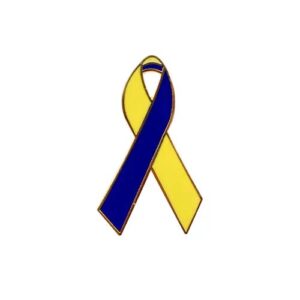

- Down Syndrome: Down Syndrome is a genetic disorder caused when abnormal cell division results in an extra full or partial copy of chromosome 21. This extra genetic material causes the developmental changes and physical features of Down Syndrome. Down Syndrome varies in severity among individuals, causing lifelong intellectual disability and developmental delays. It is the most common genetic chromosomal disorder and cause of learning disabilities in children.
- Thoracic Outlet Syndrome: Thoracic Outlet Syndrome (TOS) is a chronic condition that occurs when the nerves, arteries, or veins in the upper chest are compressed. This compression can happen in the passageway between the collarbone and first rib, or between the neck and shoulder muscles.
Zebra Awareness Ribbons: Colors and causes symbolize, stand for and support:
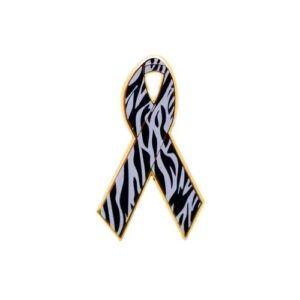

- Adenocarcinoma: Adenocarcinoma is a type of cancer. It starts in the glands that line the organs. Adenocarcinoma cancers can affect several areas of the body, including the lungs, stomach, pancreas and colon. Treatment options include surgery, chemotherapy or radiation therapy. Survival rates vary depending on the location, stage and type of adenocarcinoma.
- Adenocarcinoid Tumors: Adenocarcinoid tumors, also known as goblet cell carcinomas, are a type of tumor that is like both carcinoid and adenocarcinoma tumors. They can develop in the appendix and may spread to other parts of the body, particularly the abdomen.
- Carcinoid Cancer, Adult: Carcinoid Tumors are a type of slow-growing cancer that can arise in several places throughout the body. Carcinoid tumors, which are one subset of tumors called Neuroendocrine Tumors, usually begin in the digestive tract or in the lungs. Carcinoid tumors can produce and release hormones into the body that cause signs and symptoms such as diarrhea or skin flushing.
- Carcinoid Cancer, Childhood: A Carcinoid Tumor is a specific type of Neuroendocrine Tumor. Carcinoid tumors most often develop in the GI tract, in organs such as the stomach or intestines, or in the lungs. Sometimes neuroendocrine tumors in children form in the appendix. The tumor is often found during surgery to remove the appendix. The alternate color for Carcinoid Cancer in children is gold.
- Carcinoid Syndrome: Carcinoid Syndrome occurs when a rare cancerous tumor called a carcinoid tumor secretes certain chemicals into the bloodstream, causing a variety of signs and symptoms. A carcinoid tumor, which is a type of neuroendocrine tumor, occurs most often in the gastrointestinal tract or the lungs. Carcinoid syndrome typically occurs in people who have carcinoid tumors that are advanced.
- Carcinoid Tumors, Adult: Carcinoid Tumors are a type of slow-growing cancer that can arise in several places throughout the body. Carcinoid tumors, which are one subset of tumors called neuroendocrine tumors, usually begin in the digestive tract (stomach, appendix, small intestine, colon, rectum) or in the lungs.
- Carcinoid Tumors, Childhood: The majority of carcinoid tumors in children are small, slow-growing, and benign. In rare cases, these tumors can grow more quickly and spread to other sites in the body. About 10% of children with multiple endocrine neoplasia type 1 (MEN1) develop carcinoid tumors. The alternate color for Carcinoid Tumors in children is gold.
- Ehlers-Danlos Syndrome: The Ehlers-Danlos syndromes are a group of connective tissue disorders that can be inherited and are varied both in how they affect the body and in their genetic causes. They are generally characterized by joint hypermobility (joints that stretch further than normal), skin hyperextensibility (skin that can be stretched further than normal), and tissue fragility.
- Gastrointestinal Carcinoid Tumor, Adult: Gastrointestinal Cardinoid tumors are slow-growing tumors that form in the GI tract, mainly in the rectum, small intestine, or appendix.
- Gastrointestinal Carcinoid Tumor, Childhood: Gastrointestinal carcinoid tumors, also known as neuroendocrine tumors (NETs), are rare tumors that acan form in the gastrointestinal tract of children. The alternate color for Gastrointestinal Carcinoid Tumors in children is gold.
- Islet Cell Tumors, Pancreatic Neuroendocrine Tumors: Pancreatic Cancer can develop from two kinds of cells in the pancreas; exocrine cells and neuroendocrine cells, such as Islet cells. The exocrine type is more common and is usually found at an advanced stage. Pancreatic neuroendocrine tumors (Islet Cell Tumors) are less common but have a better prognosis.
- Pancreatic Neuroendocrine Neoplasms: Pancreatic neuroendocrine tumors (NETs), or Islet Cell Tumors, are a type of cancer that starts in the pancreas. Pancreatic NETs are a less common type of pancreatic cancer. They make up less than 2% of pancreatic cancers but tend to have a better outlook (prognosis) than the more common type.
- Pheochromocytoma: Pheochromocytoma and Paraganglioma are rare tumors that can be benign or malignant. Pheochromocytomas form in the adrenal glands, and Paragangliomas usually along nerve pathways in the head, neck, and spine. Pheochromocytoma is a rare tumor that forms in the center of the adrenal gland. Usually, pheochromocytoma affects one adrenal gland, but it may affect both adrenal glands. Sometimes there is more than one tumor in one adrenal gland.
- Pheochromocytoma, Childhood: Pheochromocytoma and paraganglioma are rare tumors that come from the same type of nerve tissue. Pheochromocytoma forms in the adrenal glands. Some pheochromocytomas release extra adrenaline and noradrenaline into the blood and cause symptoms. The alternate color for Pheochromocytoma in children is gold.
- Rare Diseases and Disorders: In the United States, a Rare Disease is defined as a condition that affects fewer than 200,000 people. This definition was created by Congress in the Orphan Drug Act of 1983. Rare Diseases became known as Orphan Diseases because drug companies were not interested in adopting them to develop treatments. The Orphan Drug Act created financial incentives to encourage companies to develop new drugs for rare diseases. The Rare Disease definition was needed to establish which conditions would qualify for the new incentive programs. Other countries have their own official definitions of a Rare Disease. In the European Union, a disease is defined as rare when it affects fewer than 1 in 2,000 people. There may be as many as 7,000 Rare Diseases. The total number of Americans living with a rare disease is estimated at between 25-30 million. This estimate has been used by the rare disease community for several decades to highlight that while individual diseases may be rare, the total number of people with a rare disease is large. In the United States, only a few types of rare diseases are tracked when a person is diagnosed. These include certain infectious diseases, birth defects, and cancers. It also includes the diseases on state newborn screening tests. Because most rare diseases are not tracked, it is hard to determine the exact number of rare diseases or how many people are affected.
Zebra, Pink and Blue Awareness Ribbons: Colors and causes symbolize, stand for and support:
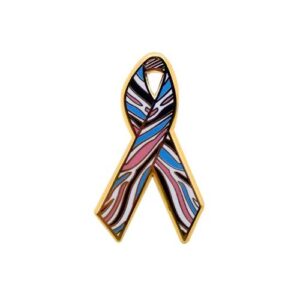

- Undiagnosed Diseases: The Common Fund’s Undiagnosed Diseases Network is a research study to improve the level of diagnosis of rare and undiagnosed conditions. In the United States, it has been estimated that approximately 25 million Americans suffer from a rare disorder. The Undiagnosed Diseases Network established a nationwide network of clinicians and researchers who use both basic and clinical research to uncover the underlying disease mechanisms associated with these conditions. In its first 20 months, the UDN accepted 601 participants undiagnosed by traditional medical practices. Of those who completed their UDN evaluation during this time, 35% were given a diagnosis. Many of these diagnoses were rare genetic diseases including 31 previously unknown syndromes. The UDN is currently accepting applications. Contact Undiagnosed Diseases Network at https://undiagnosed.hms.harvard.edu/apply/
